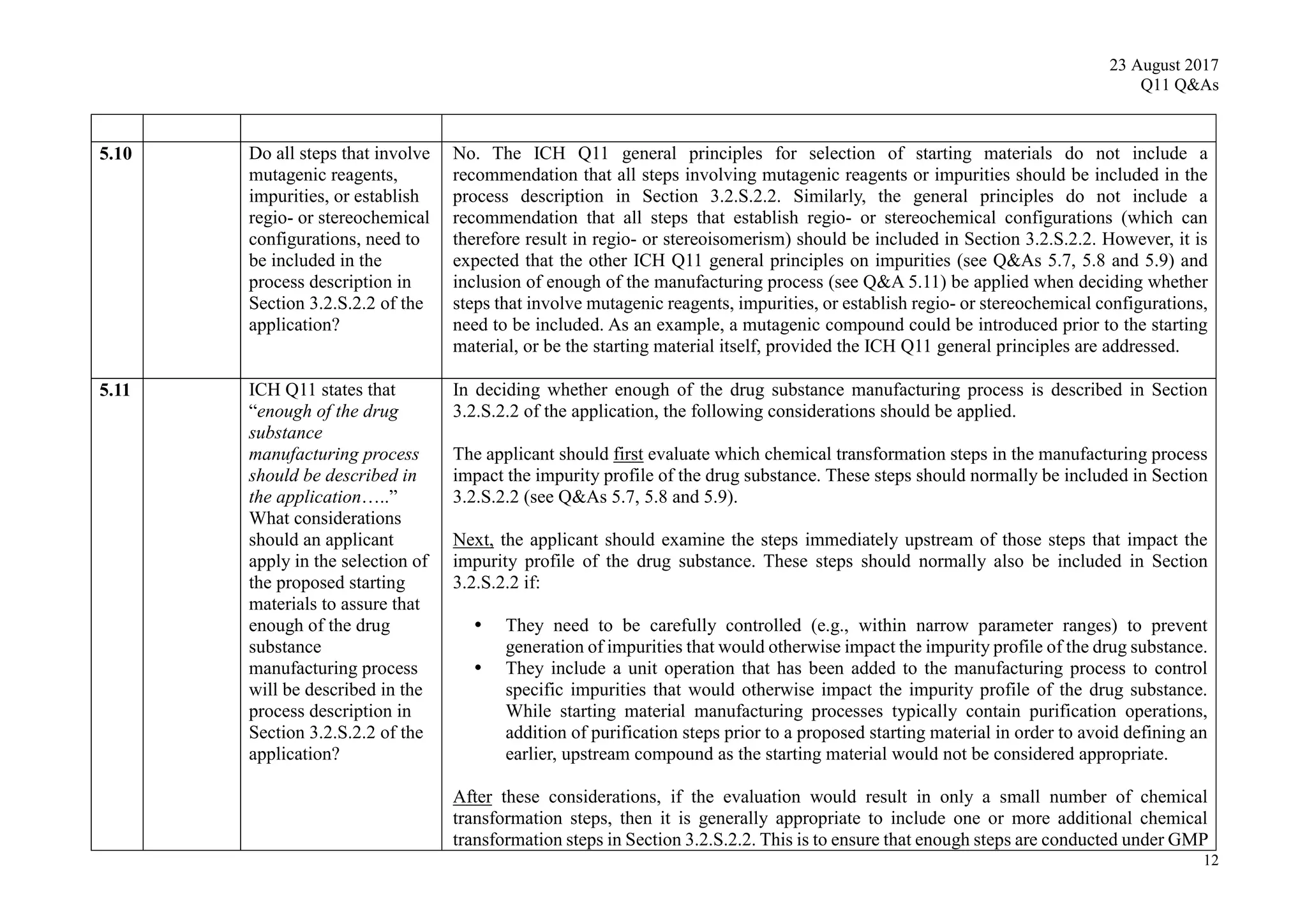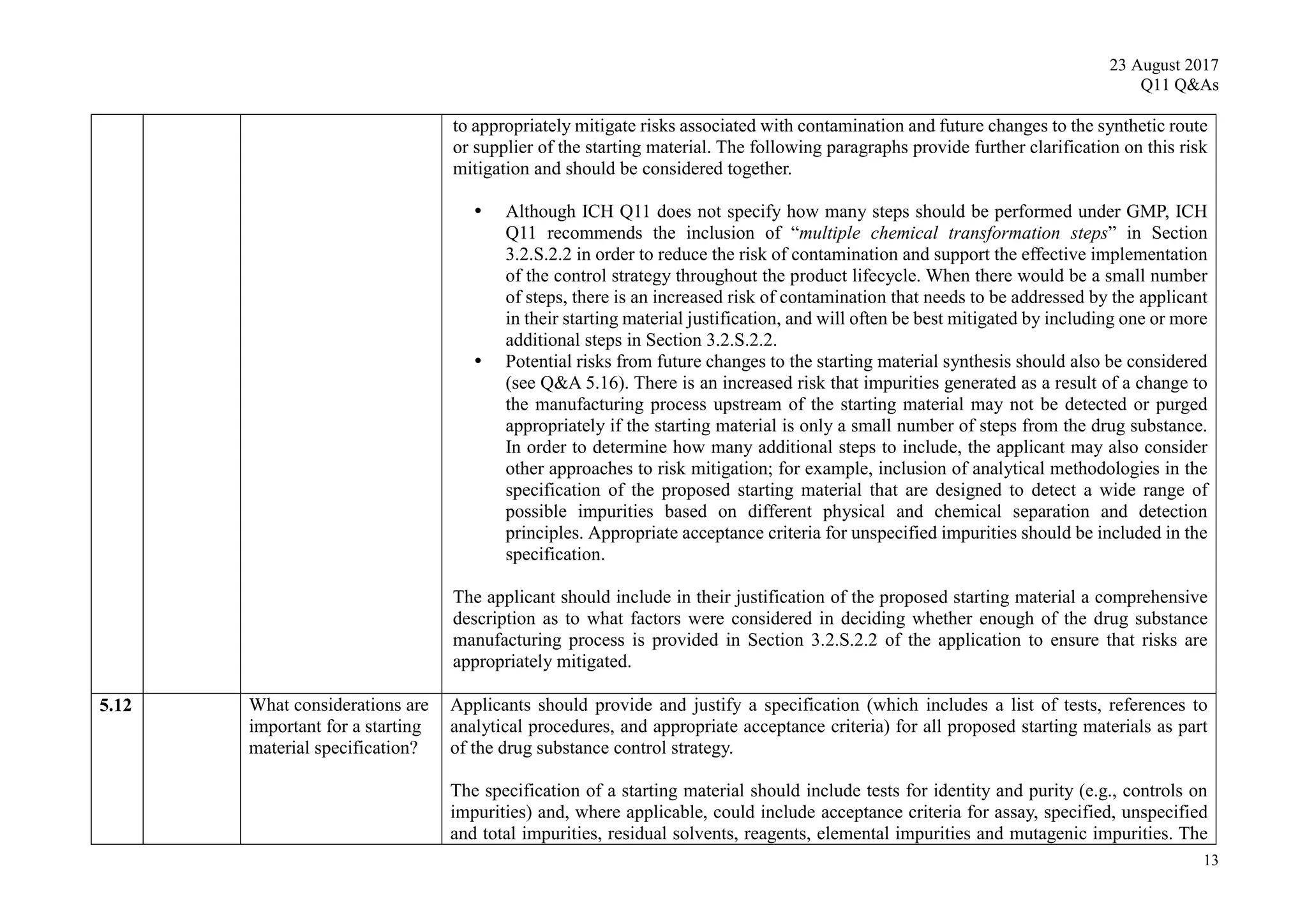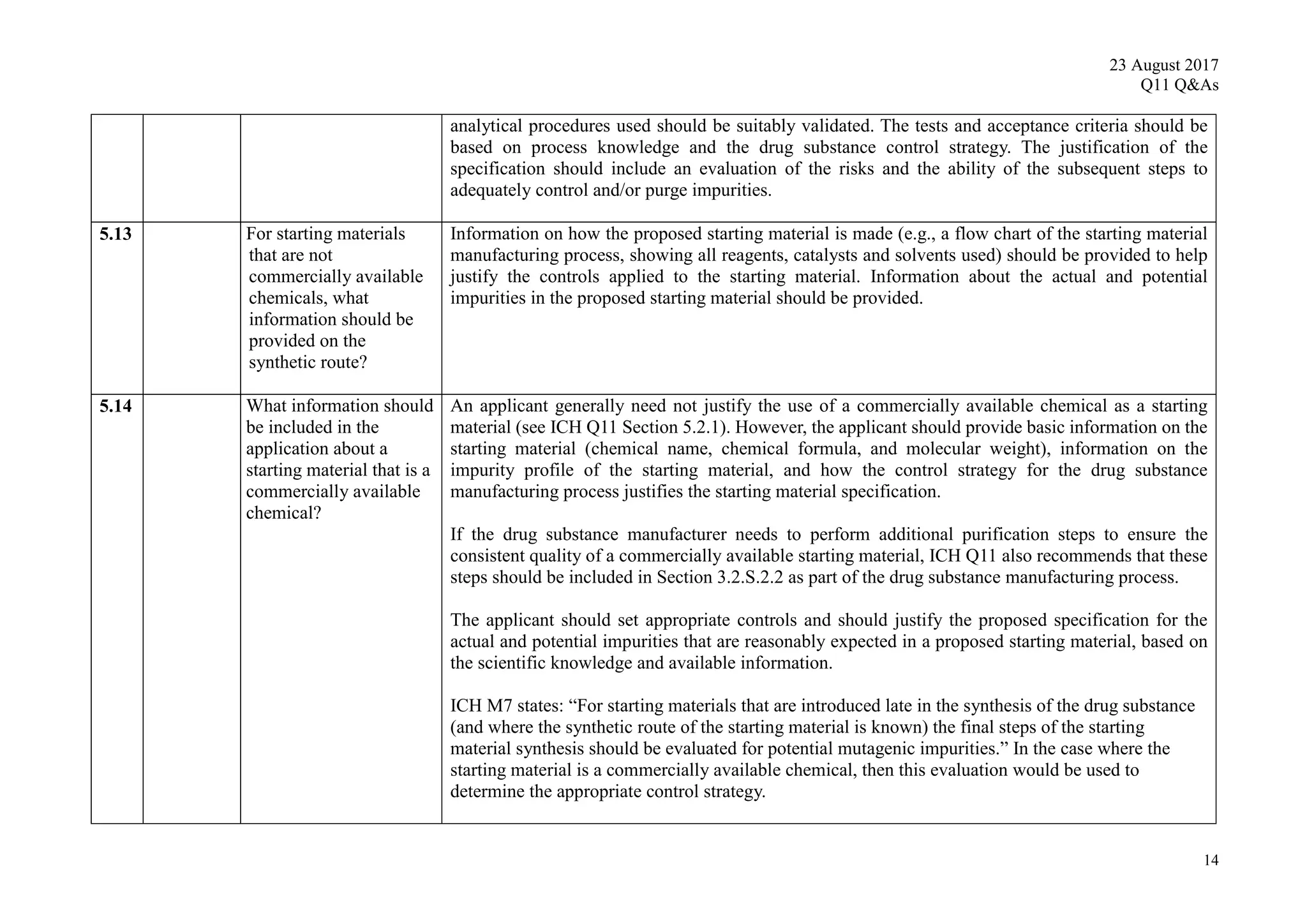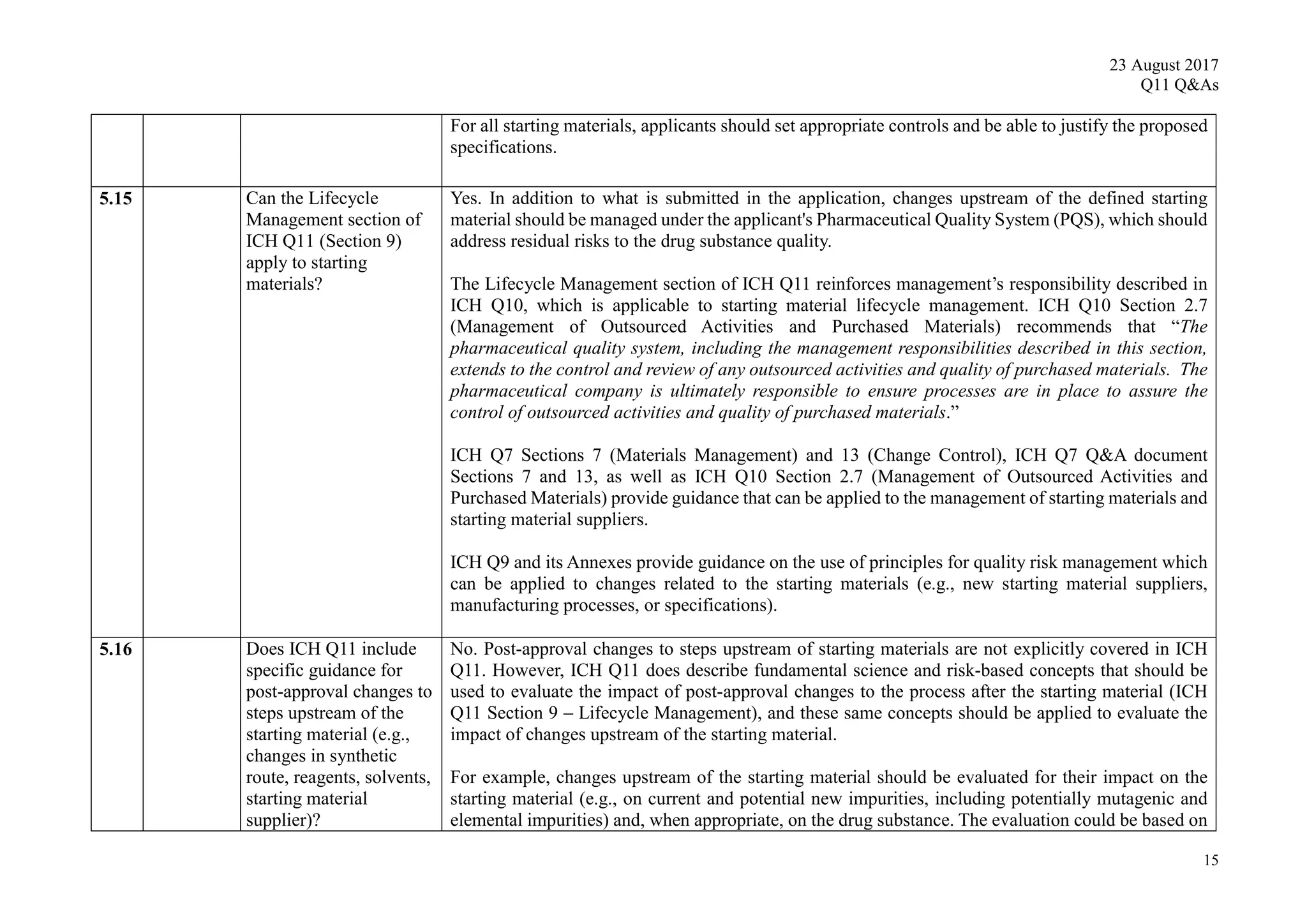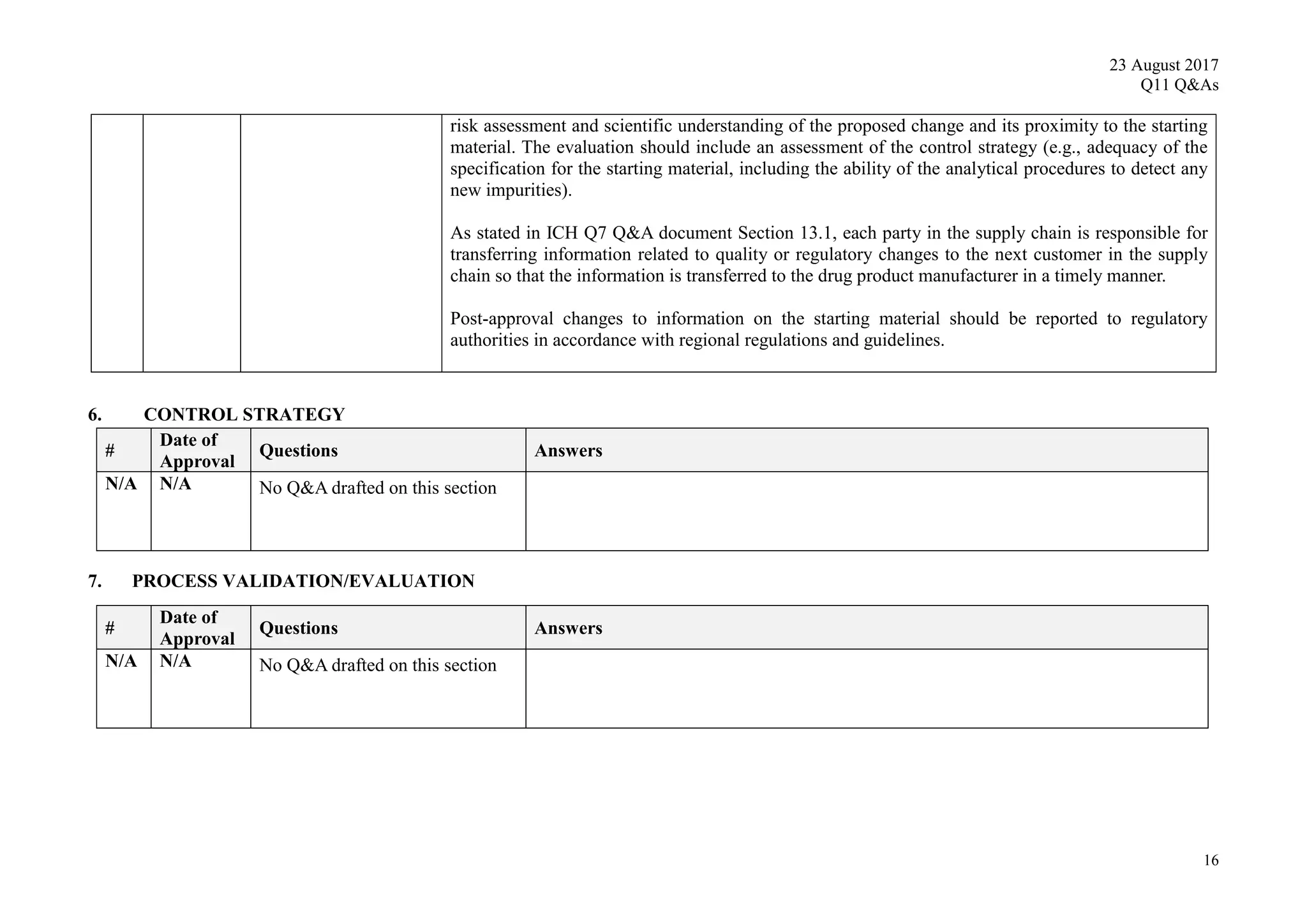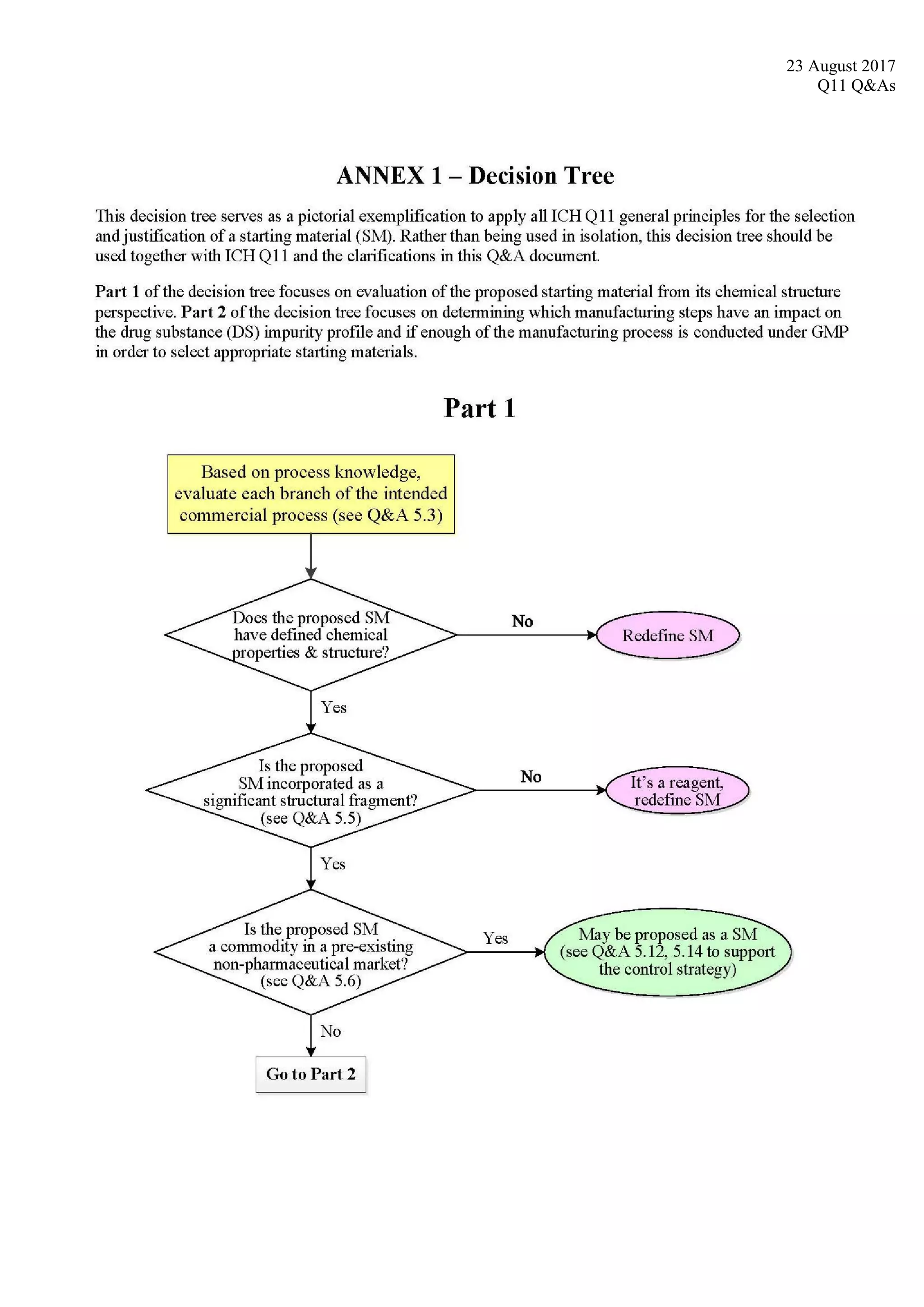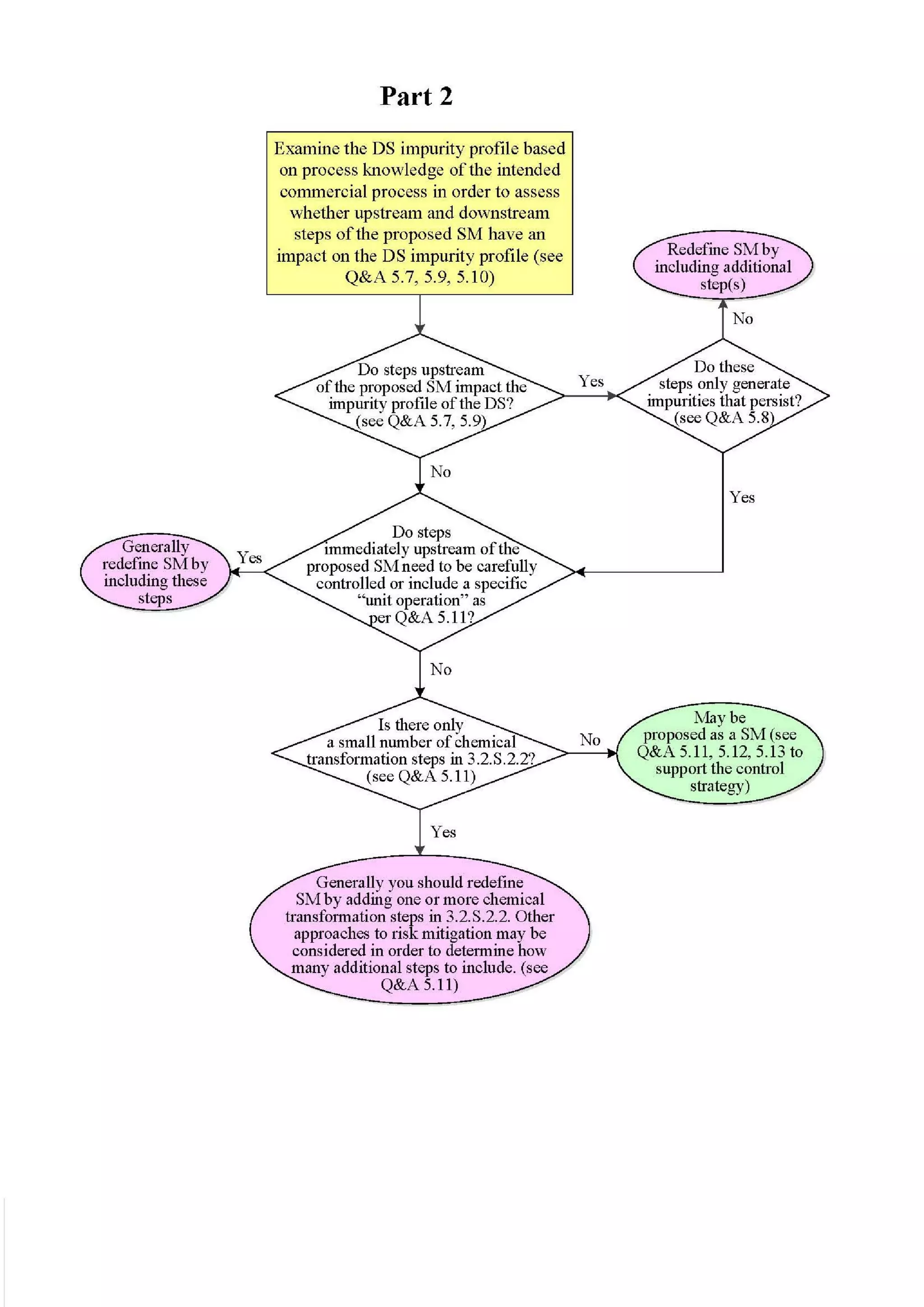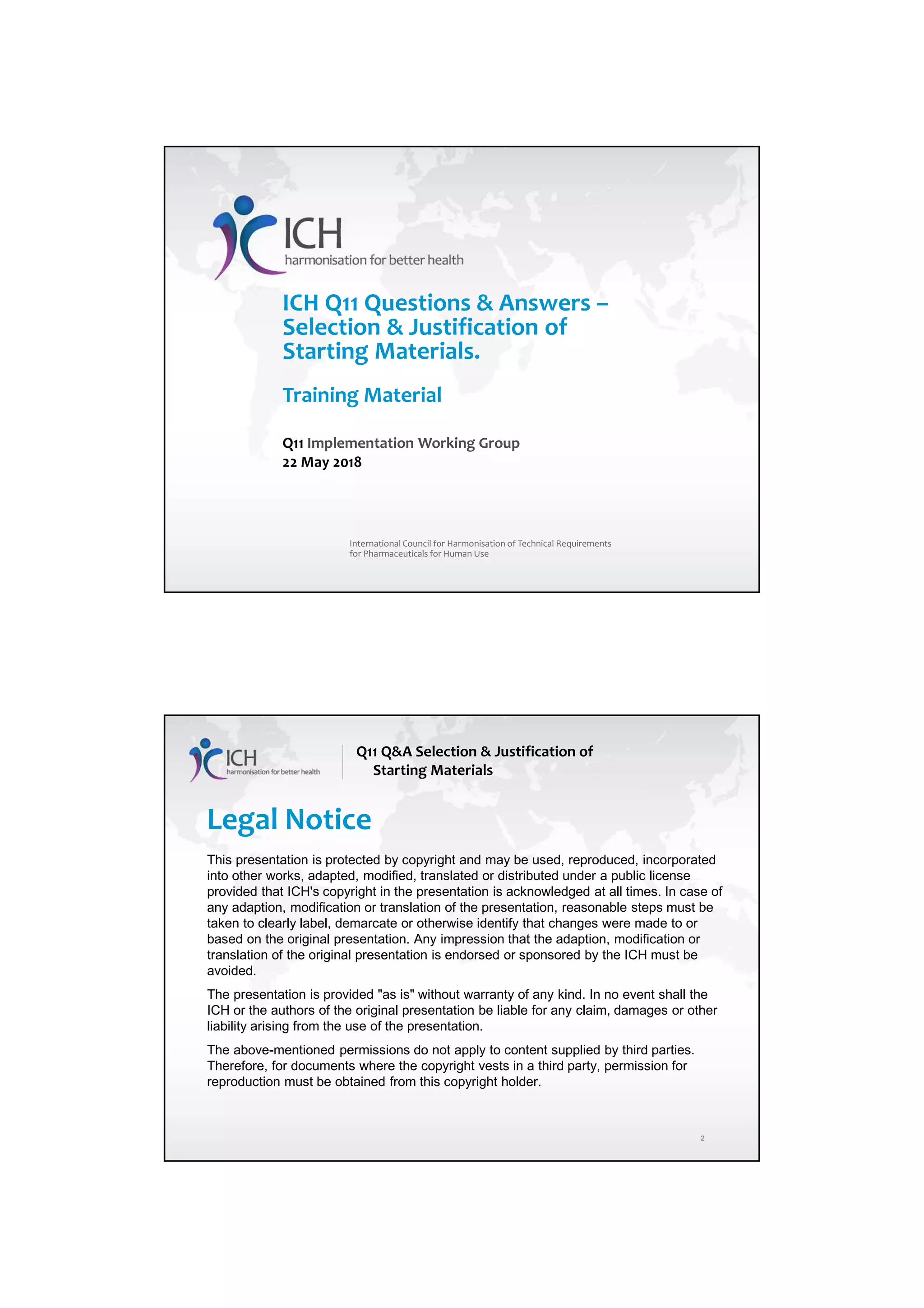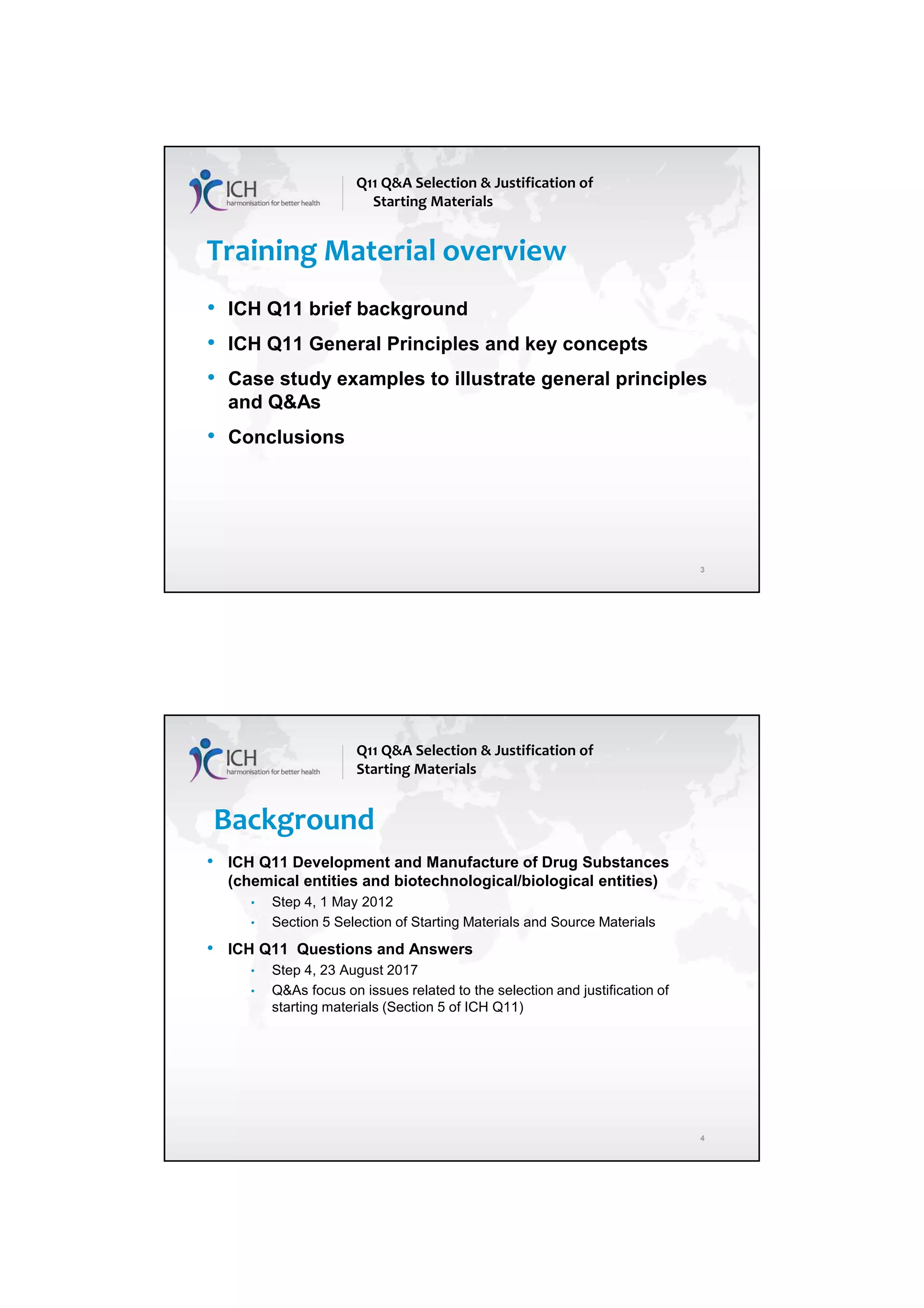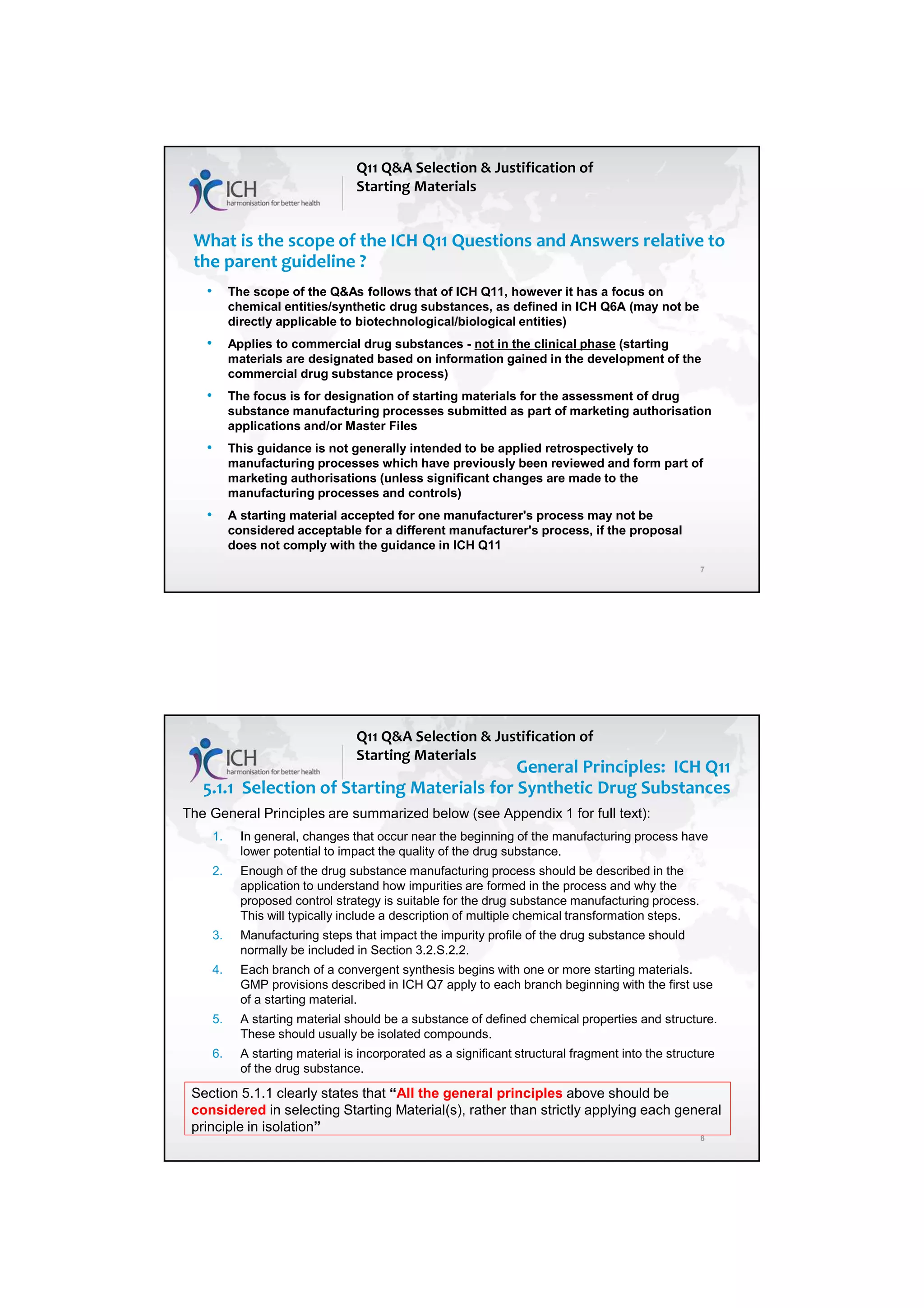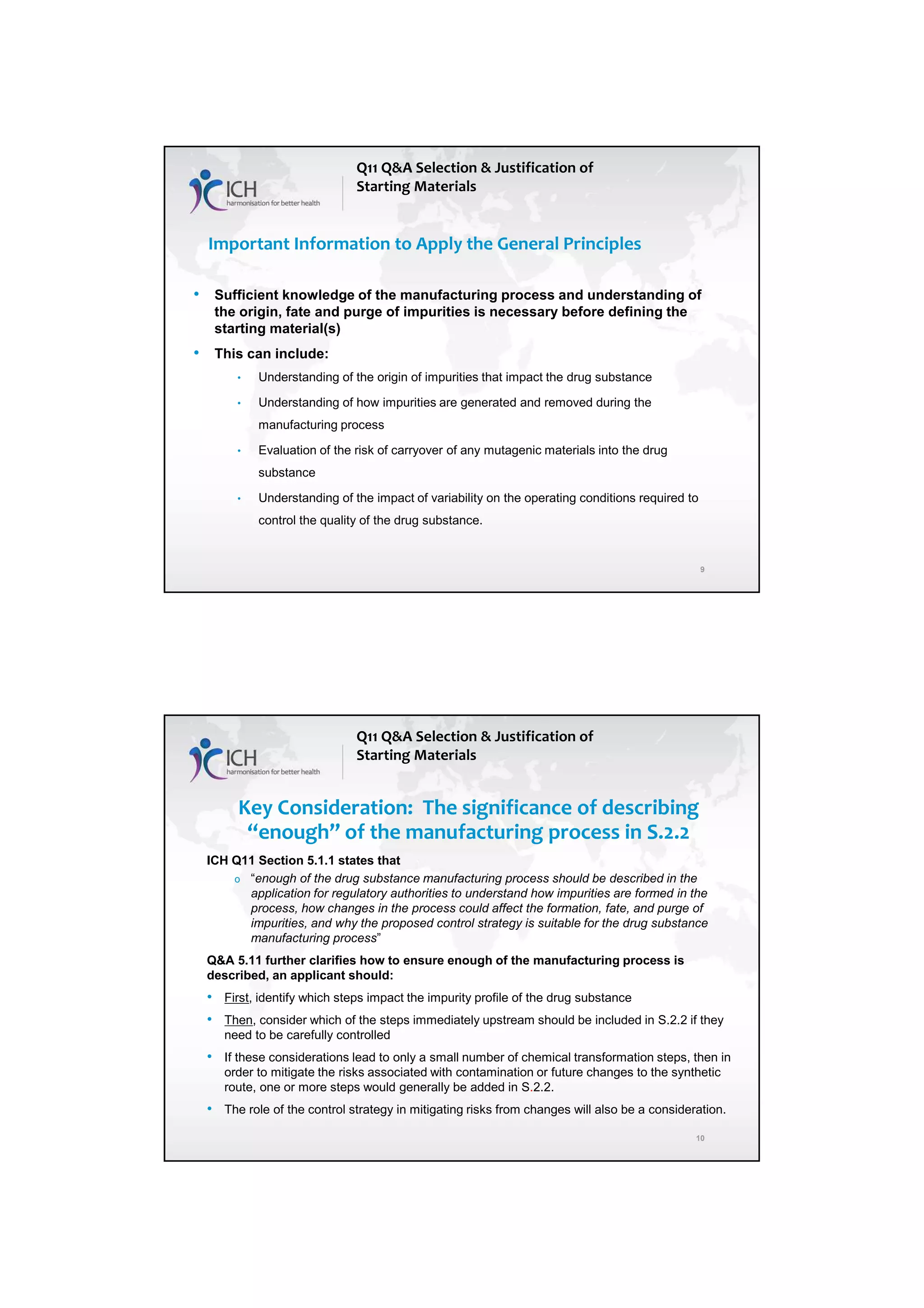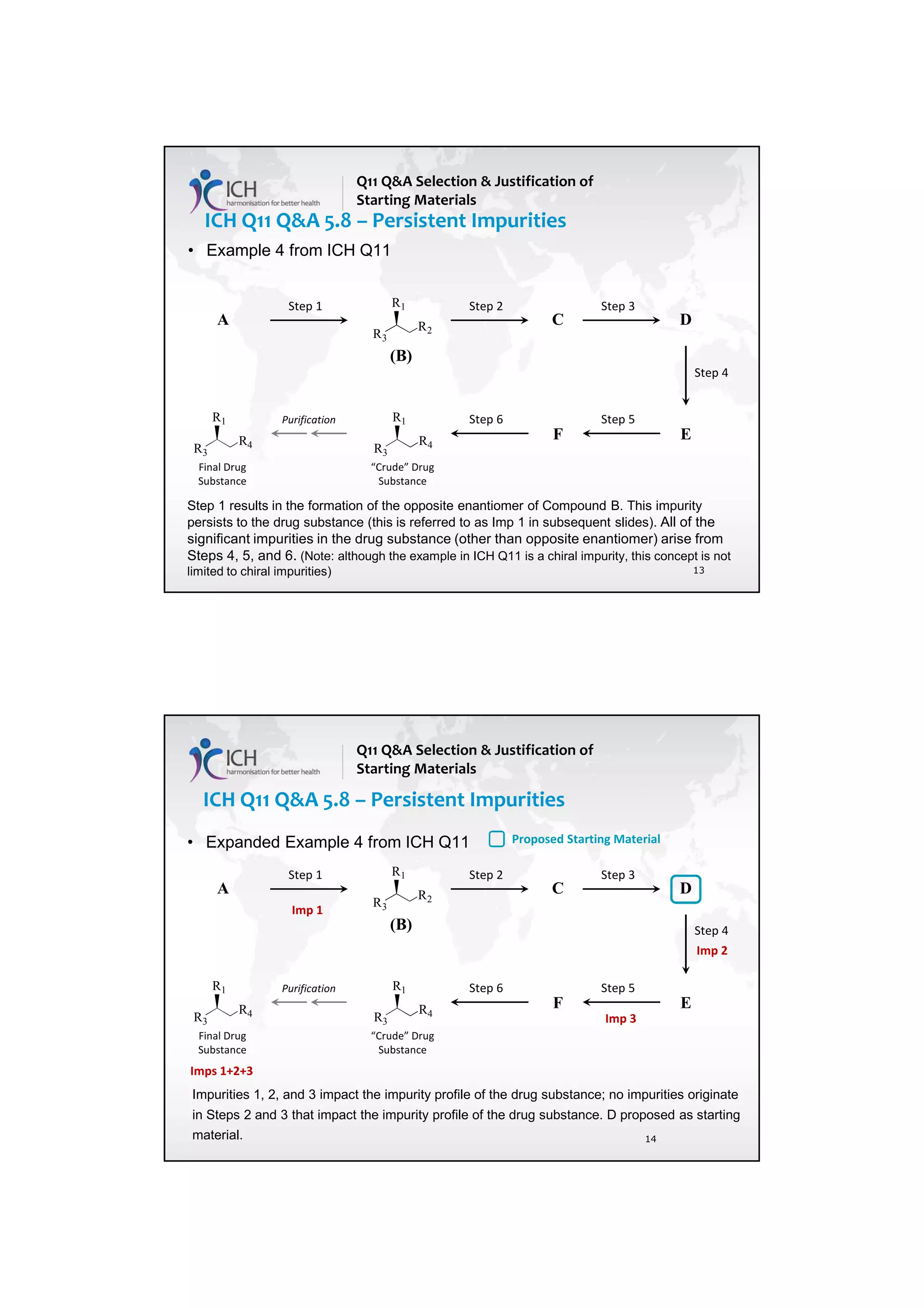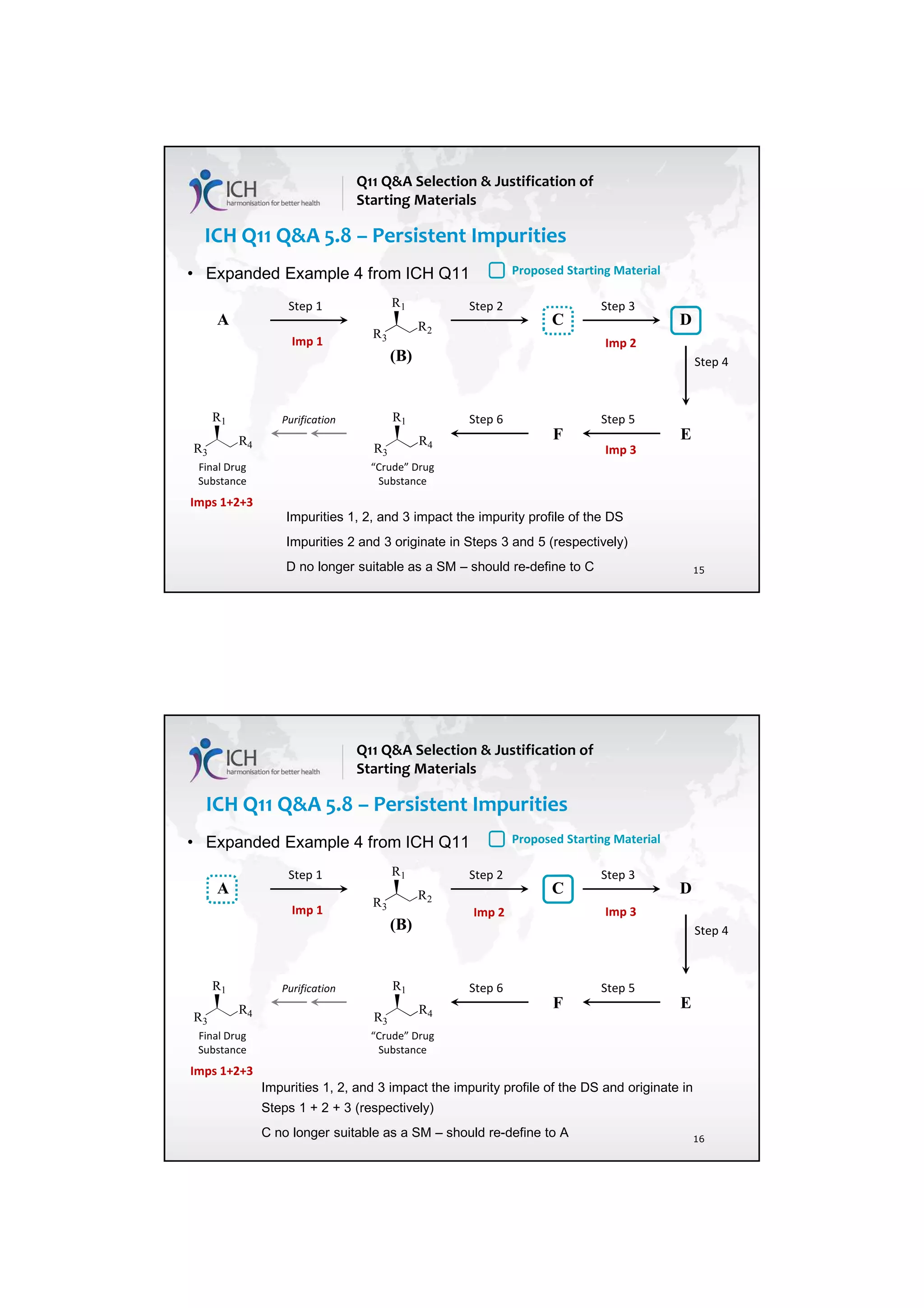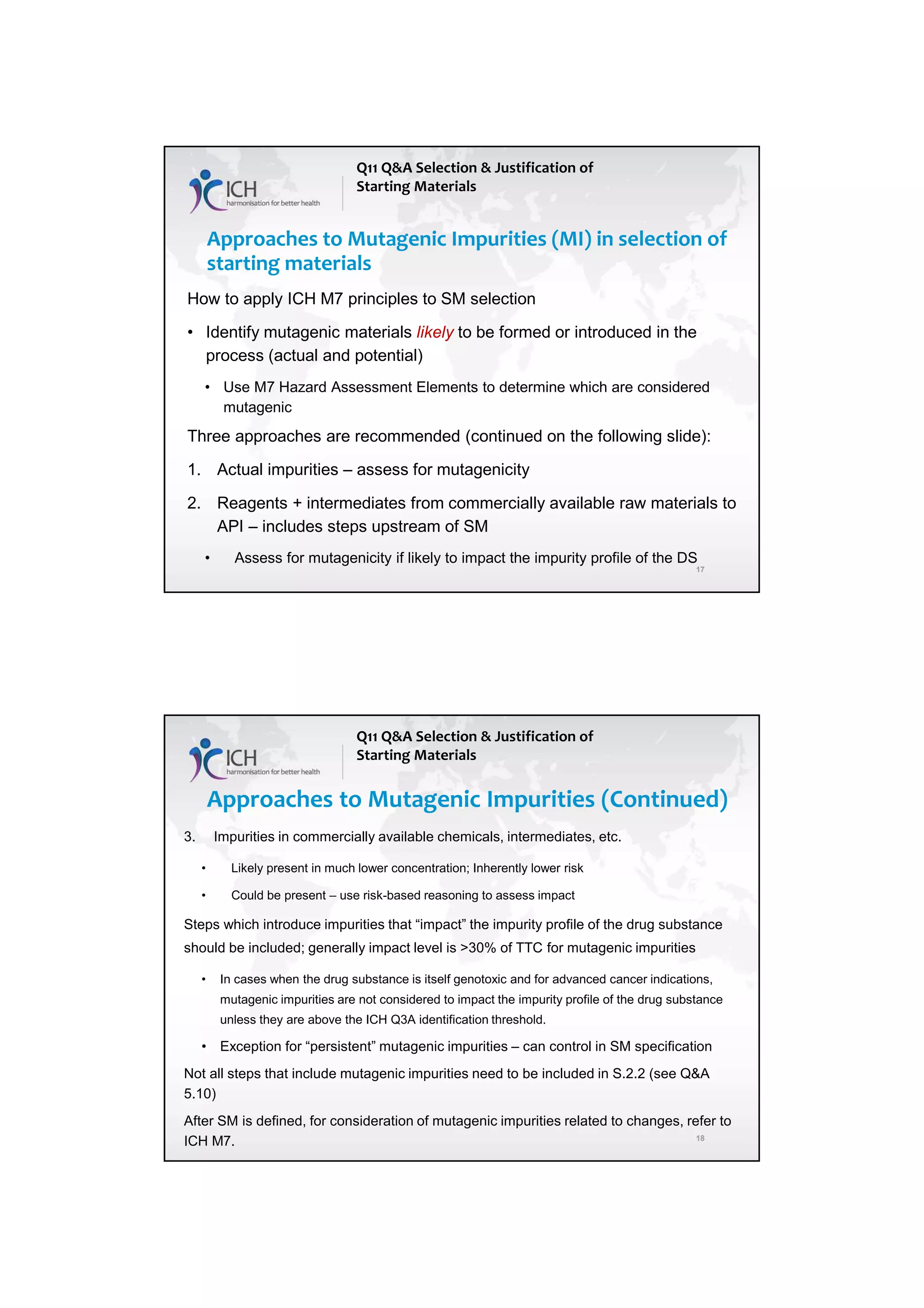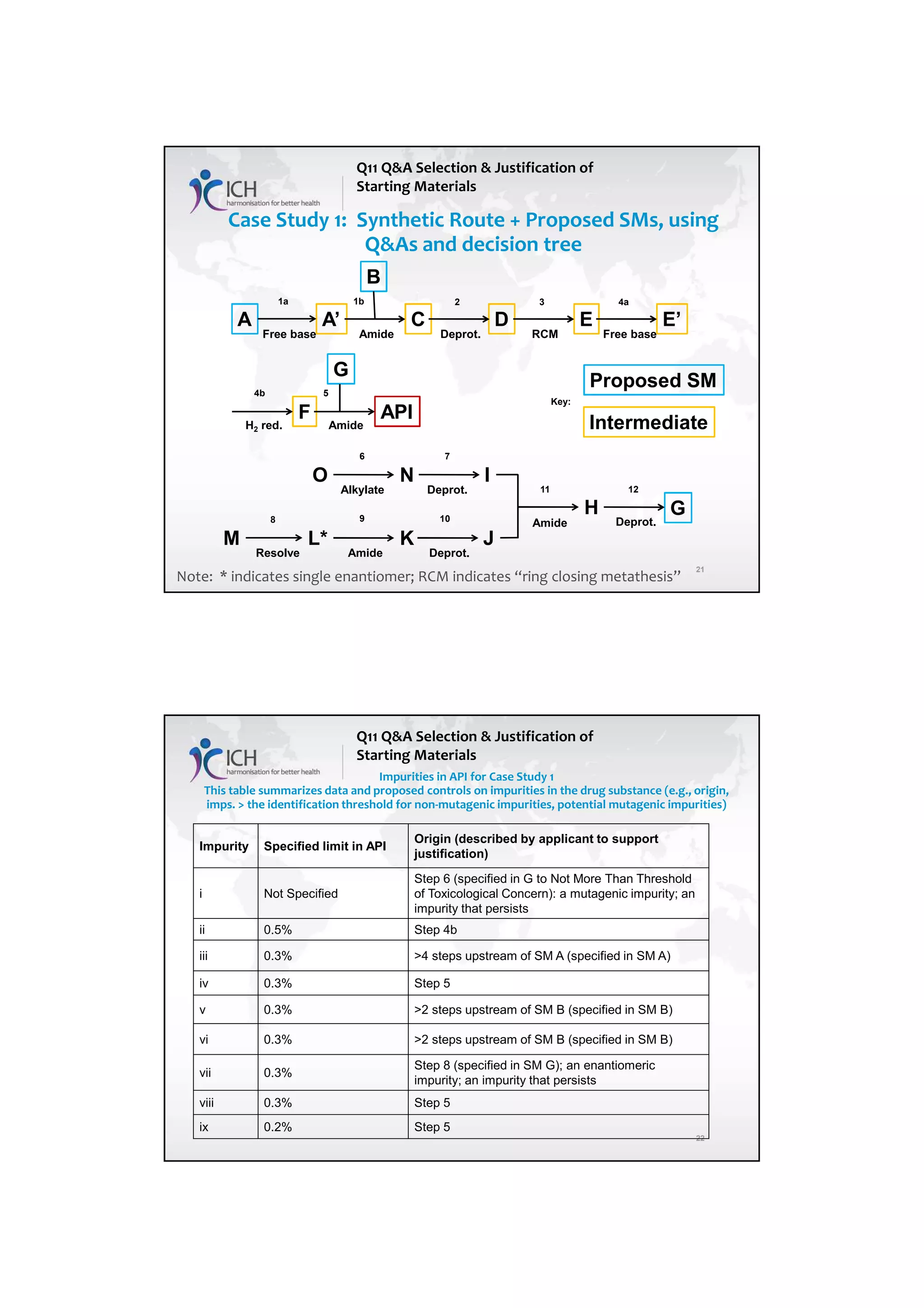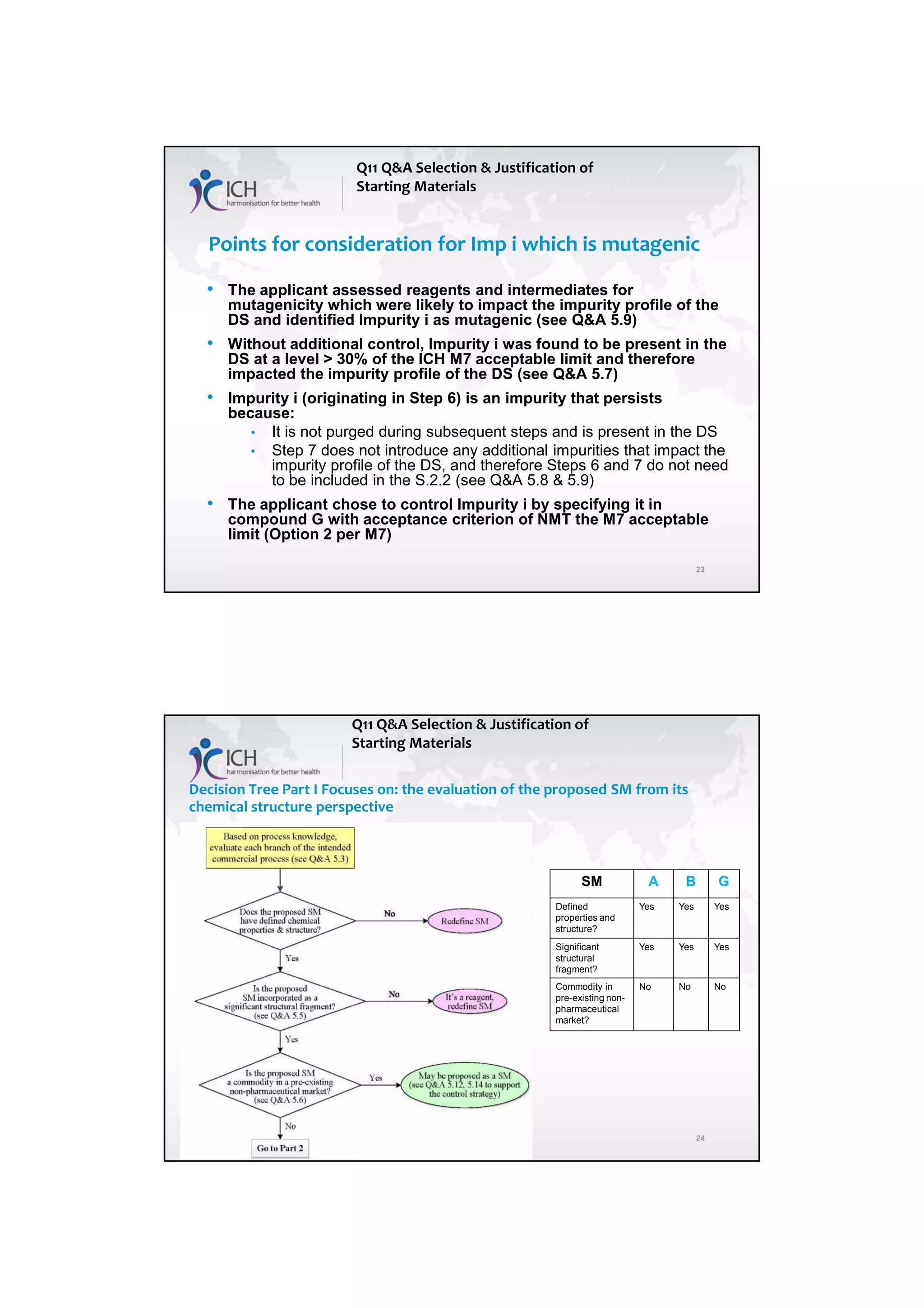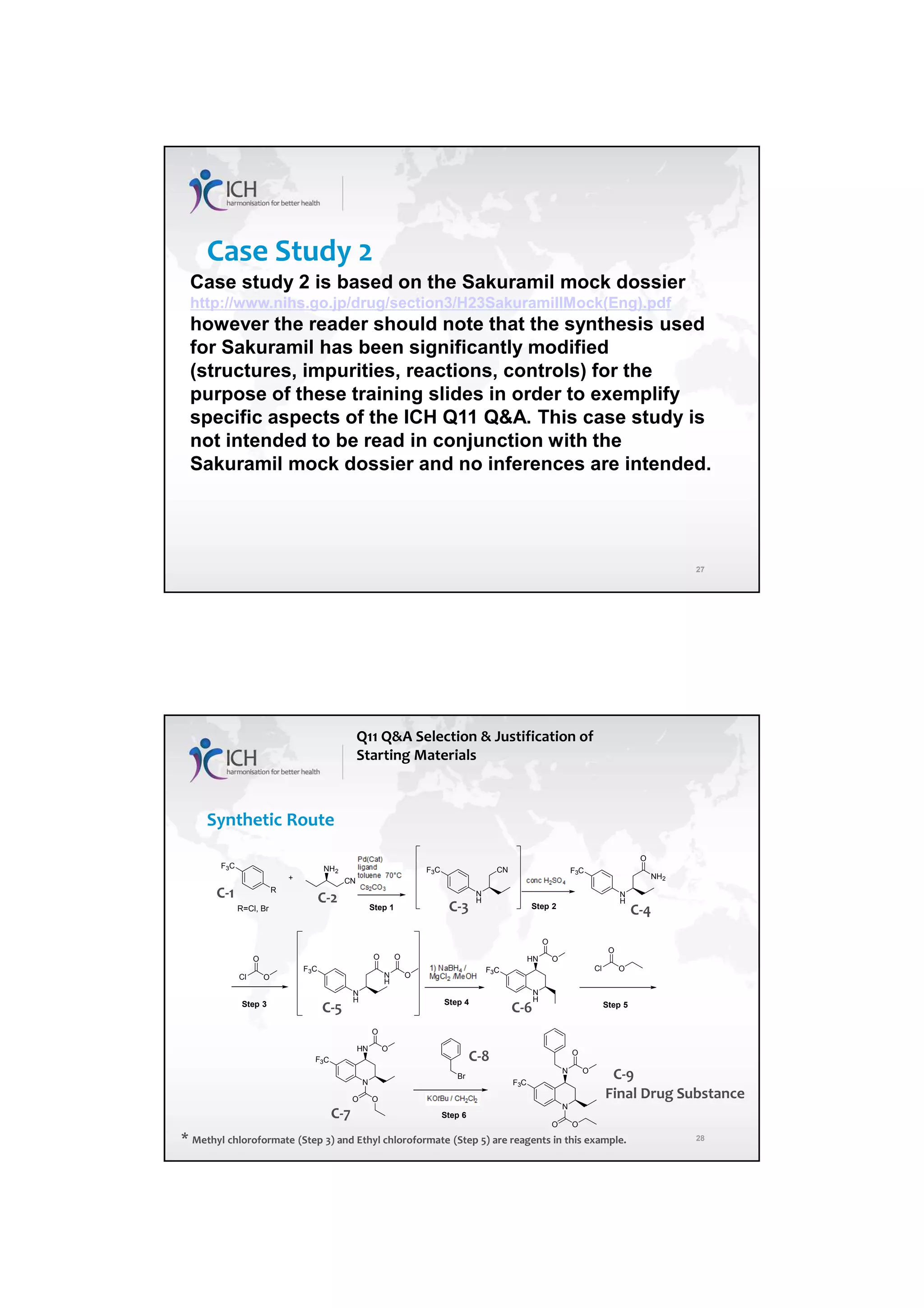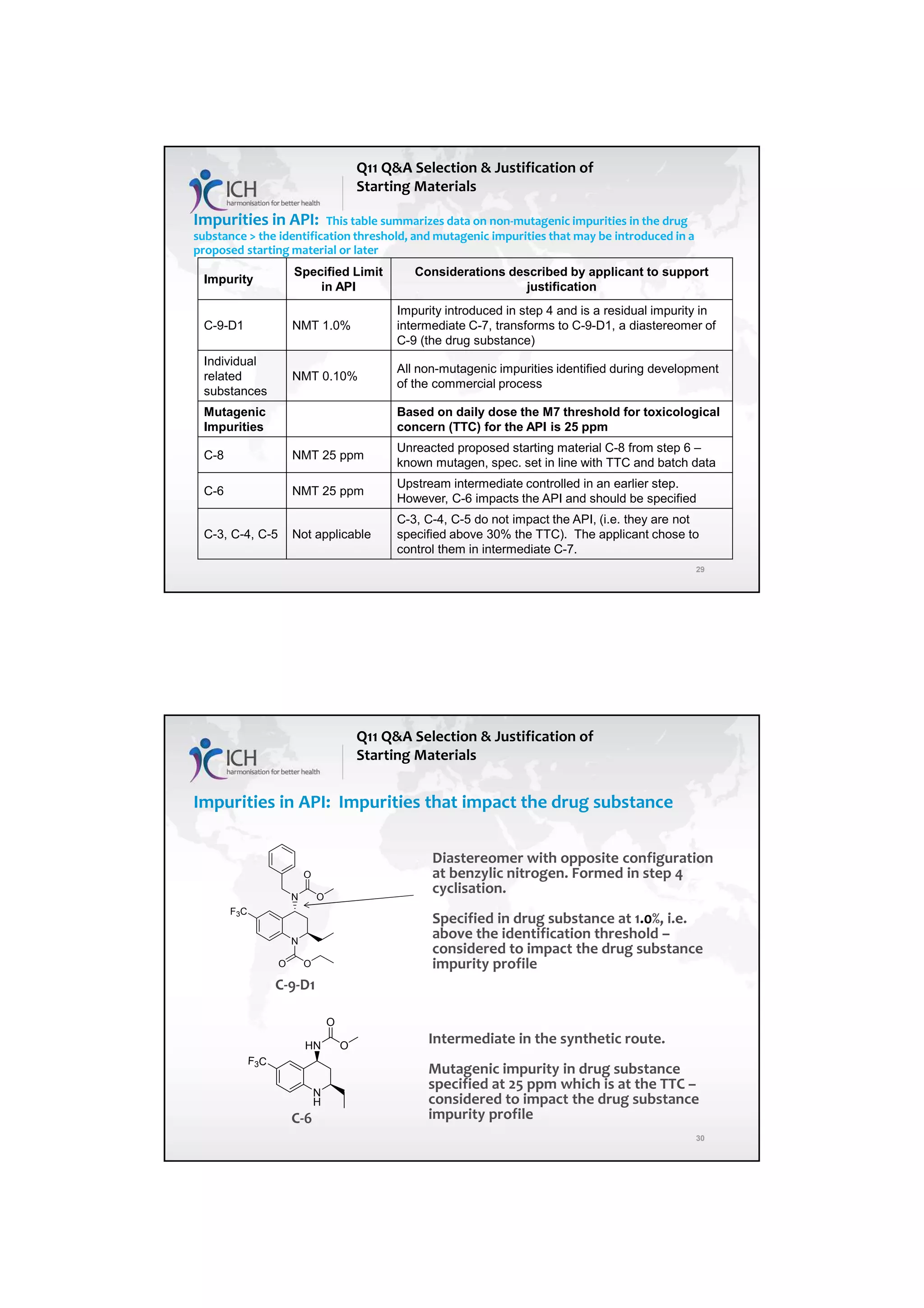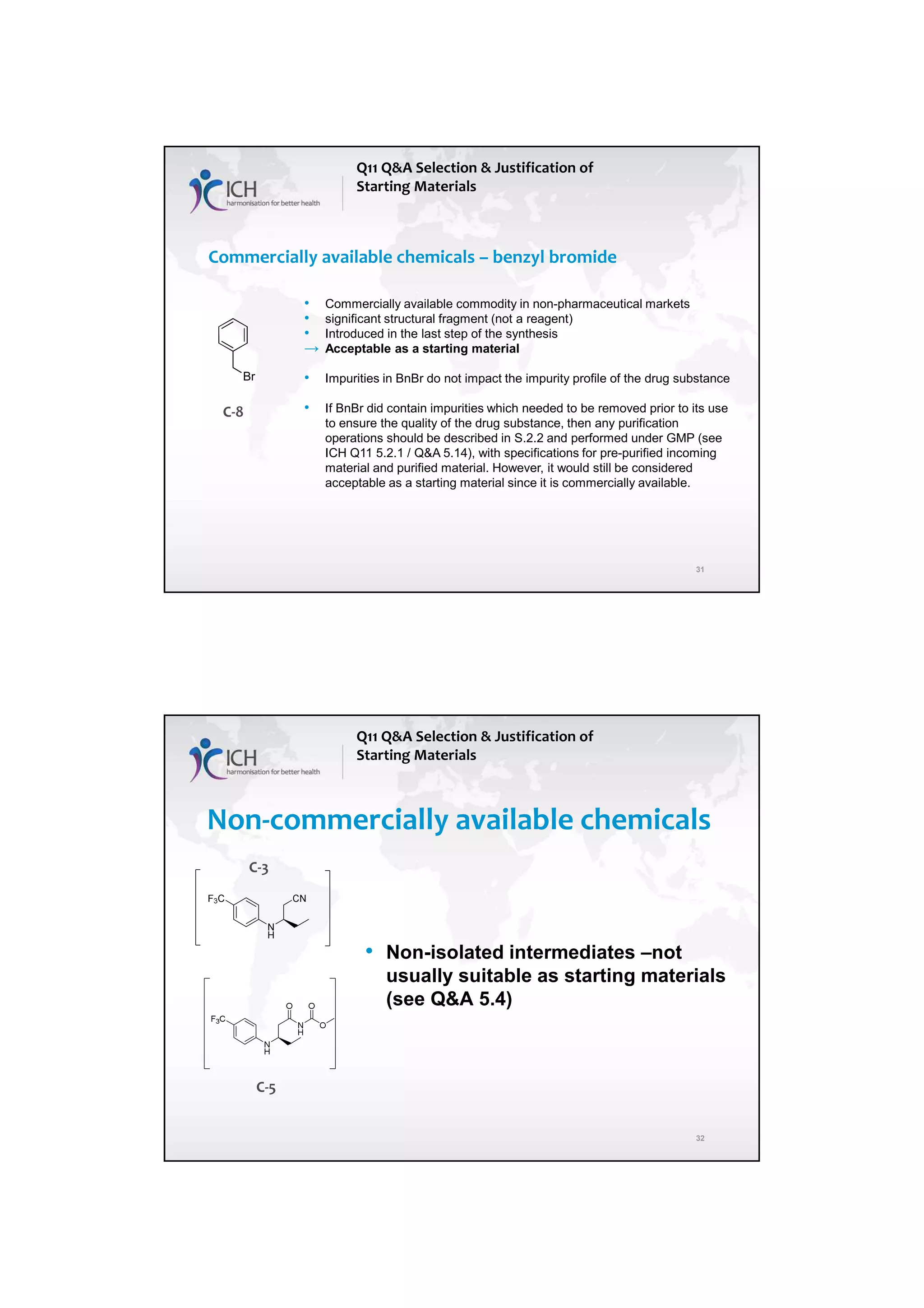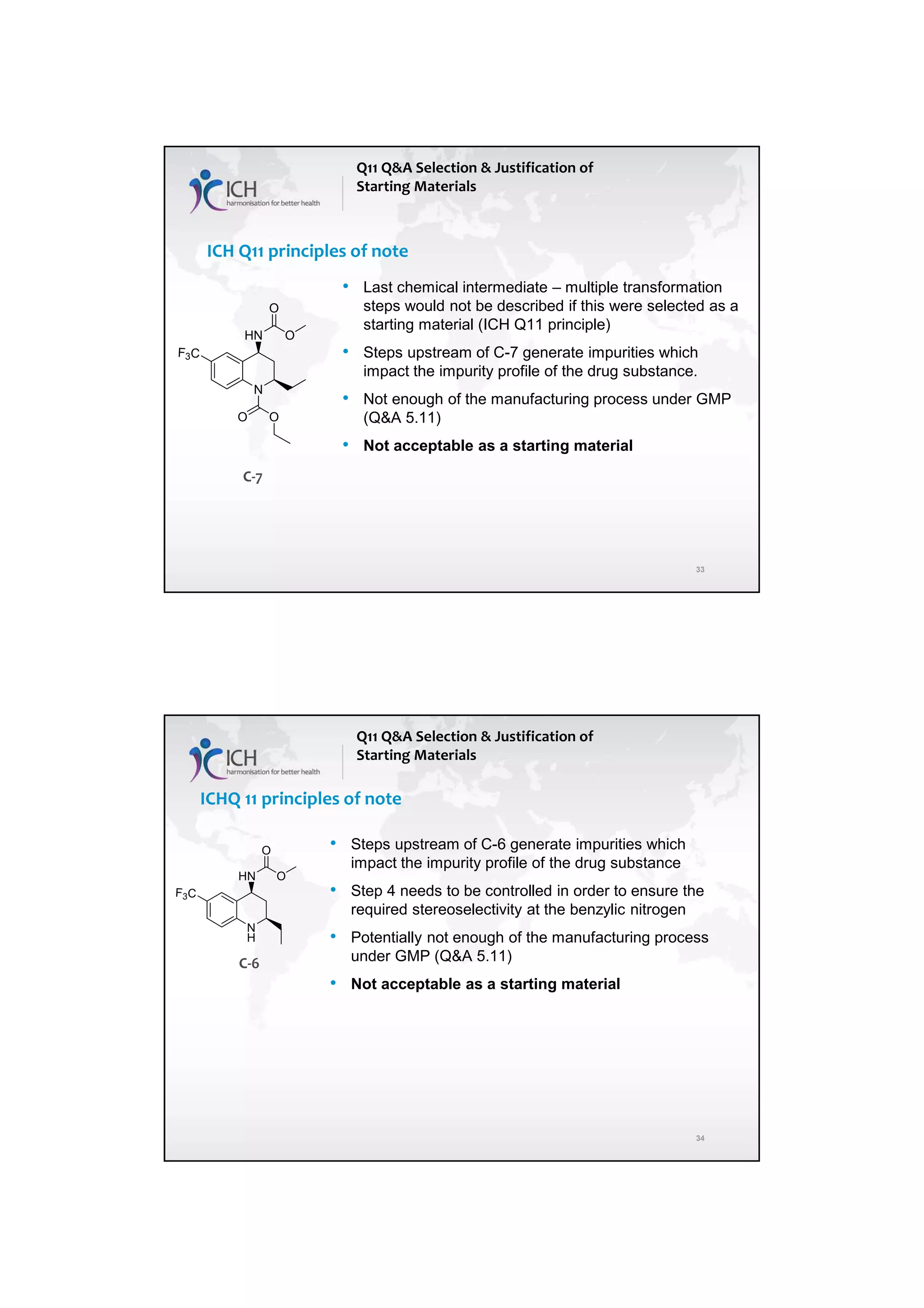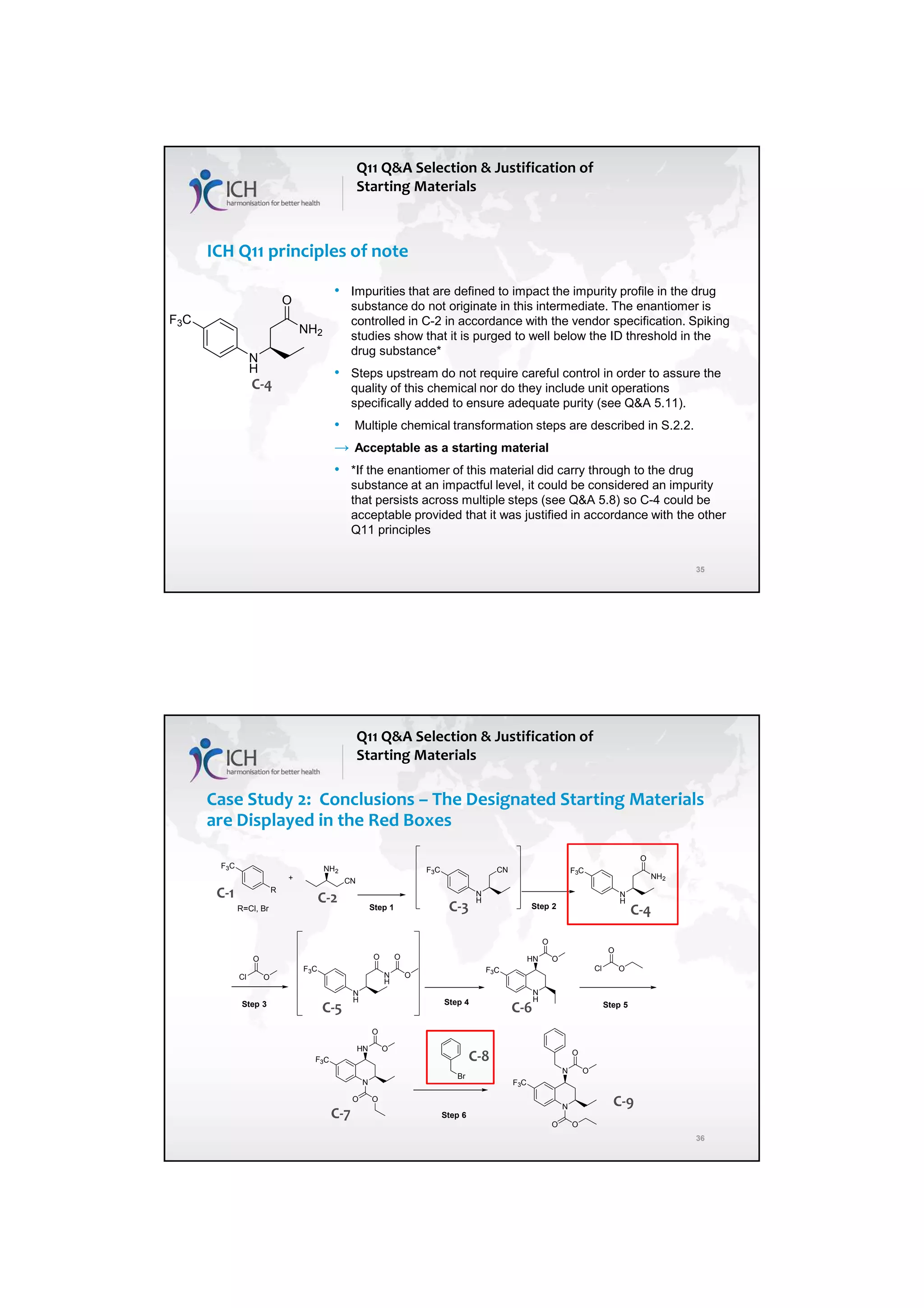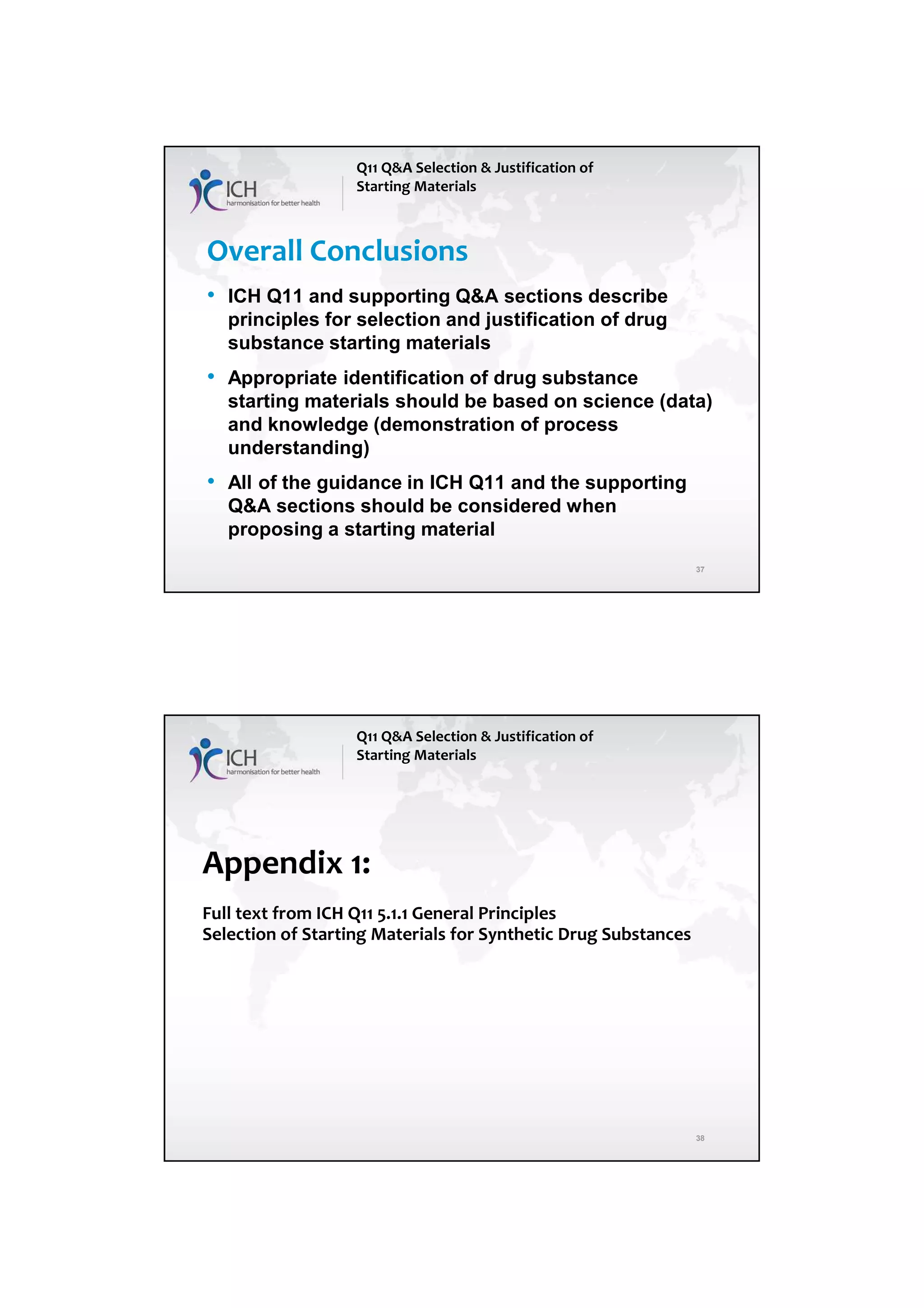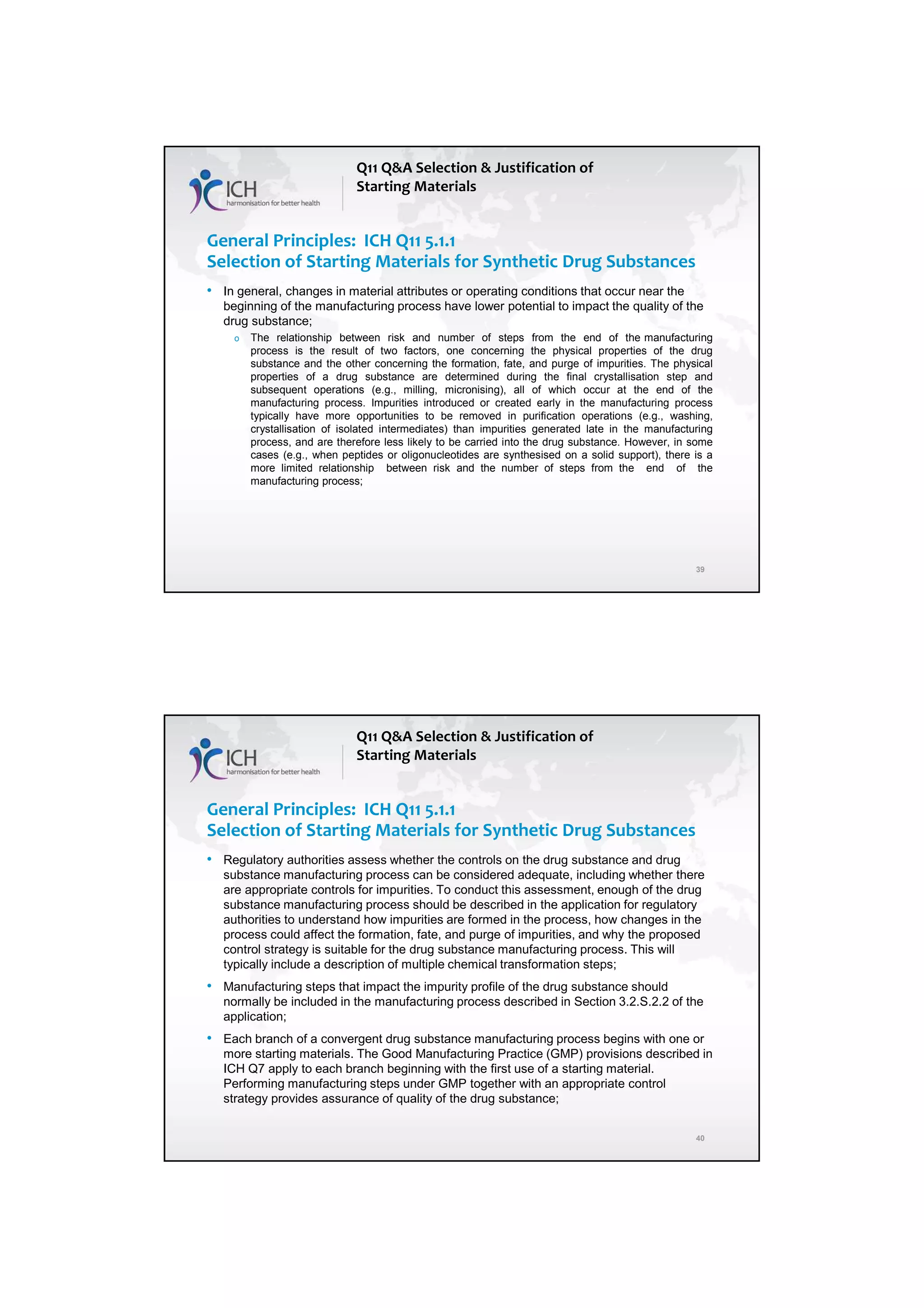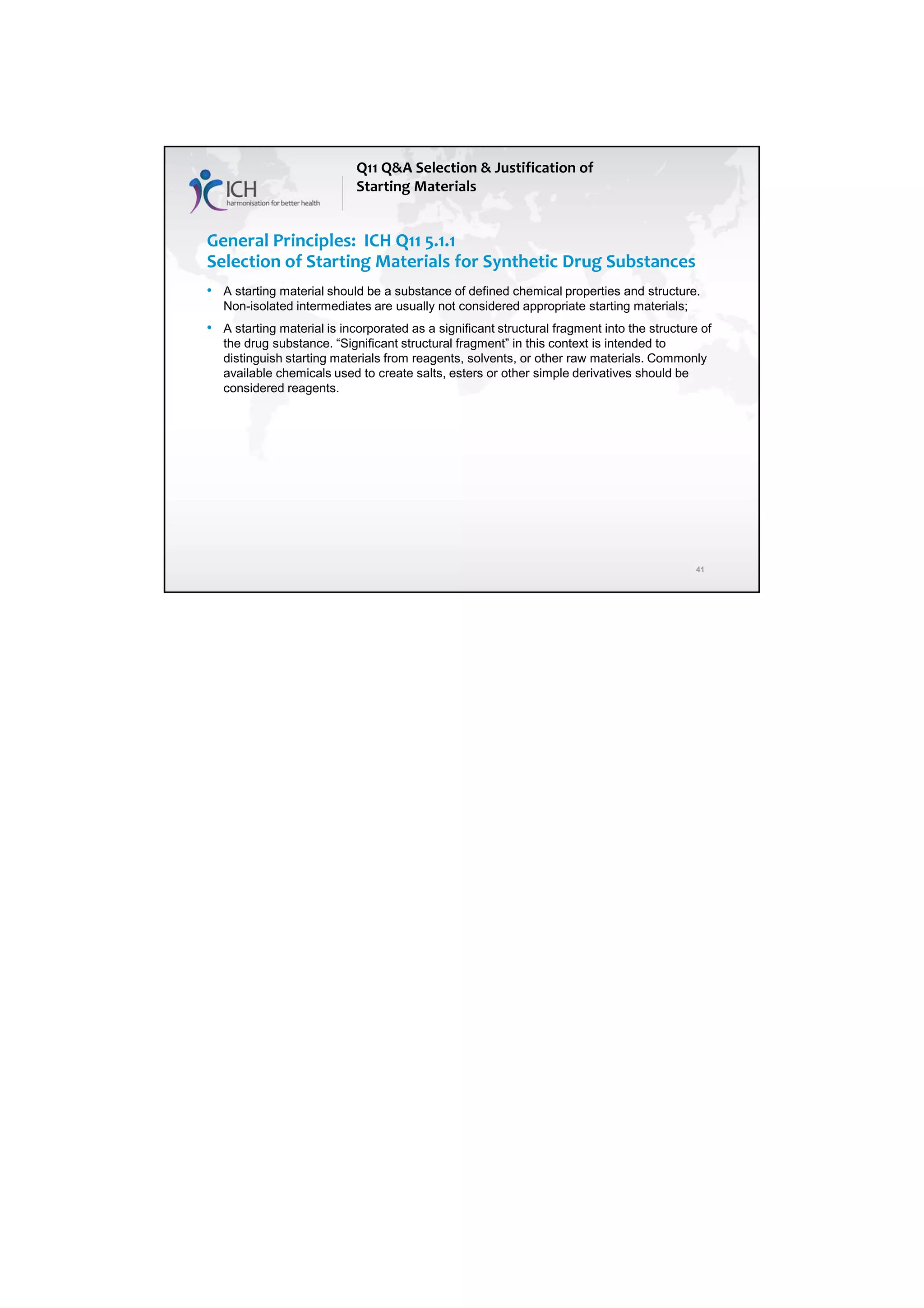The ICH Q11 guideline addresses the development and manufacture of drug substances, emphasizing the need for quality control strategies and the establishment of critical quality attributes (CQAs) essential for ensuring product quality. It provides a framework for companies to adopt traditional or enhanced approaches in process development while utilizing risk management and scientific knowledge to optimize manufacturing processes. The guideline aims to align regulatory practices among the EU, Japan, and the USA, facilitating consistent standards in pharmaceutical production.

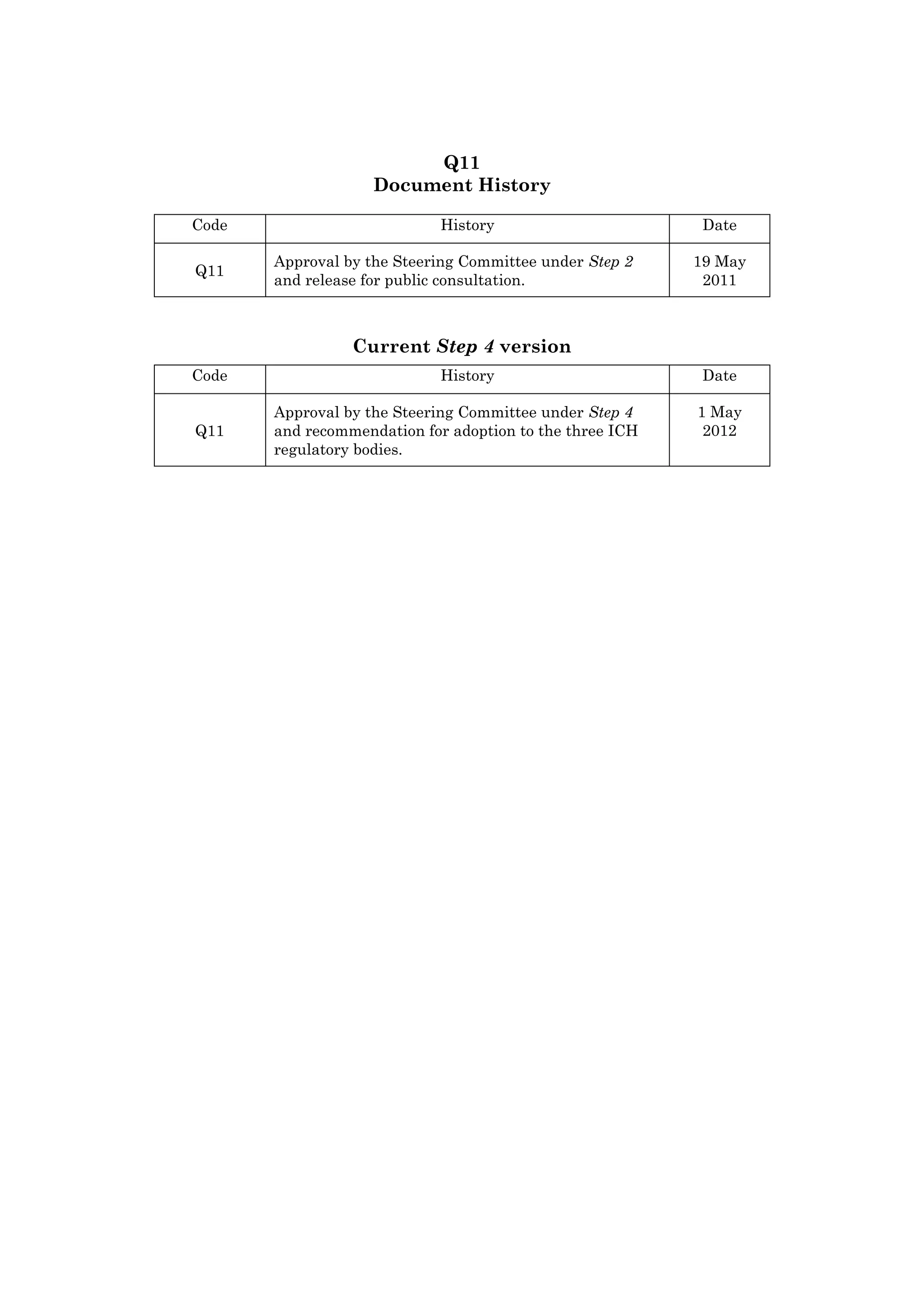
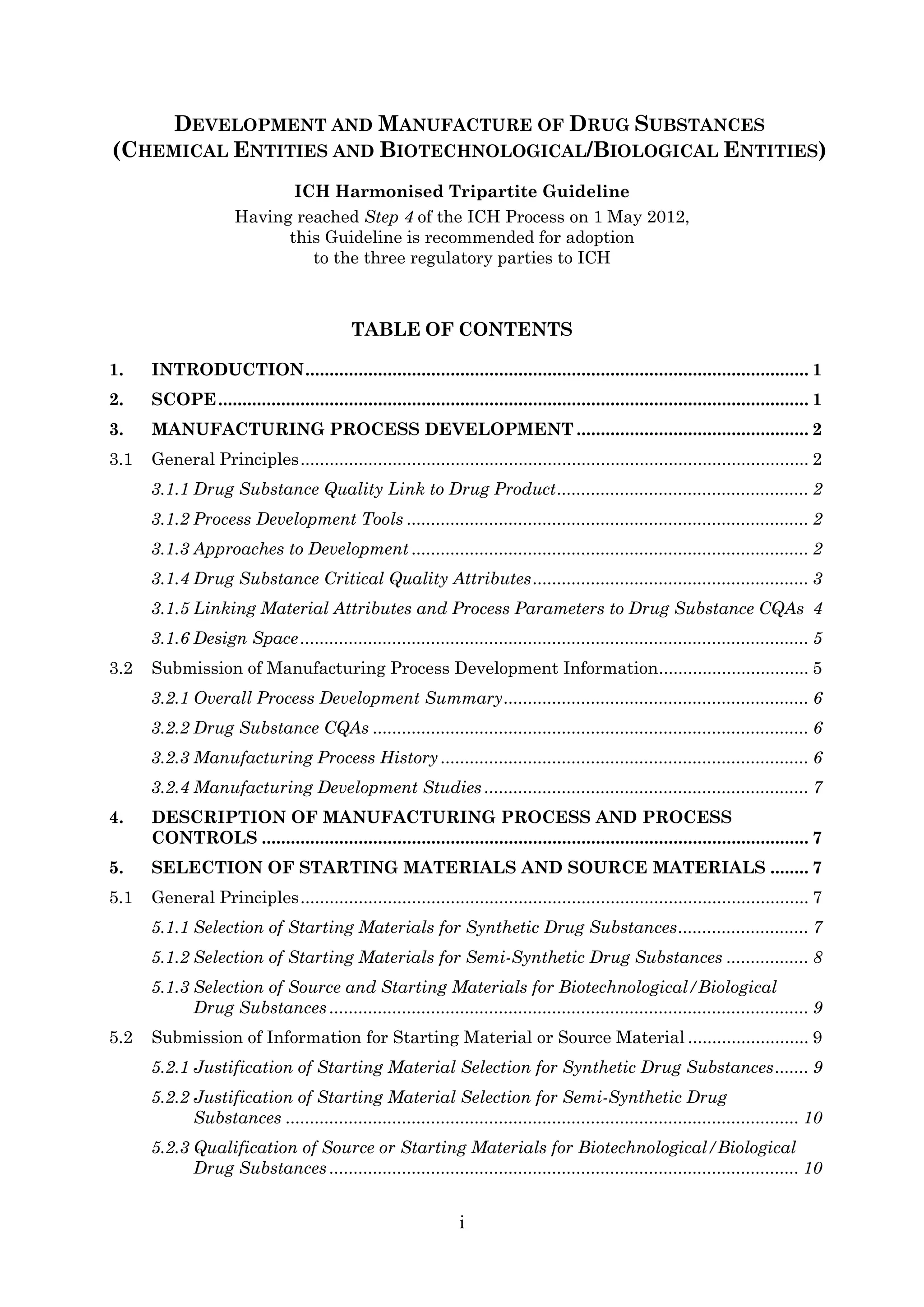
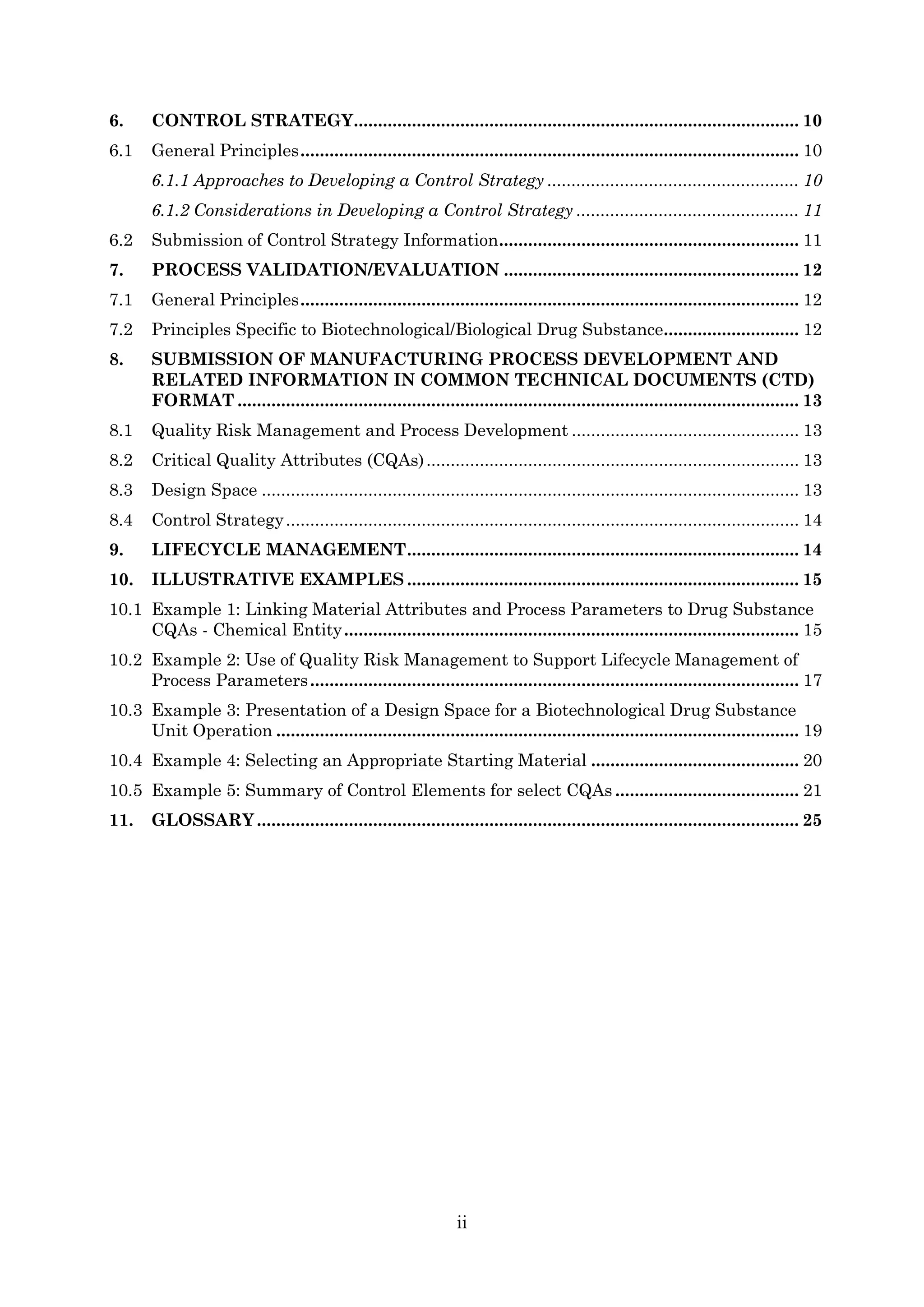
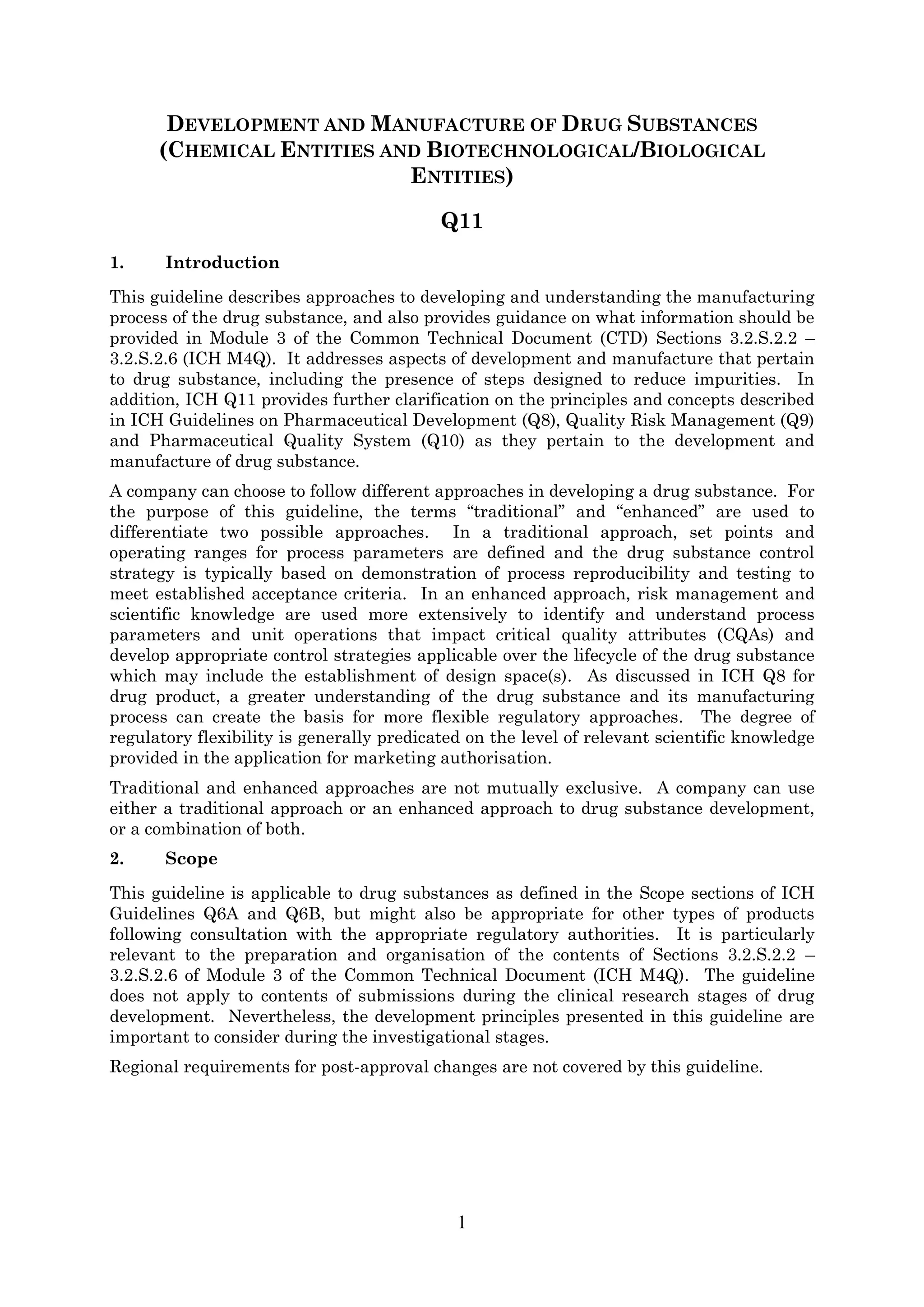
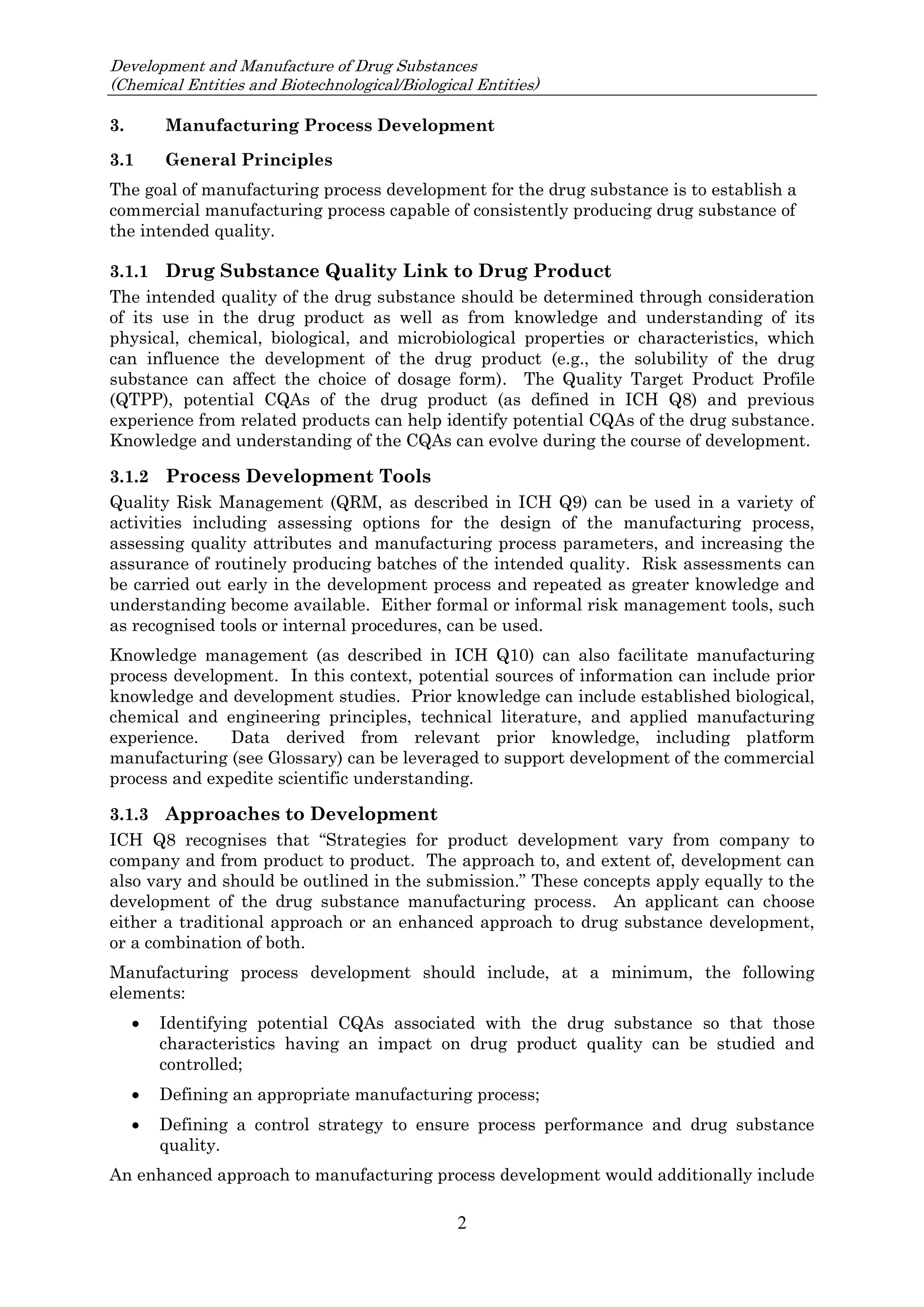


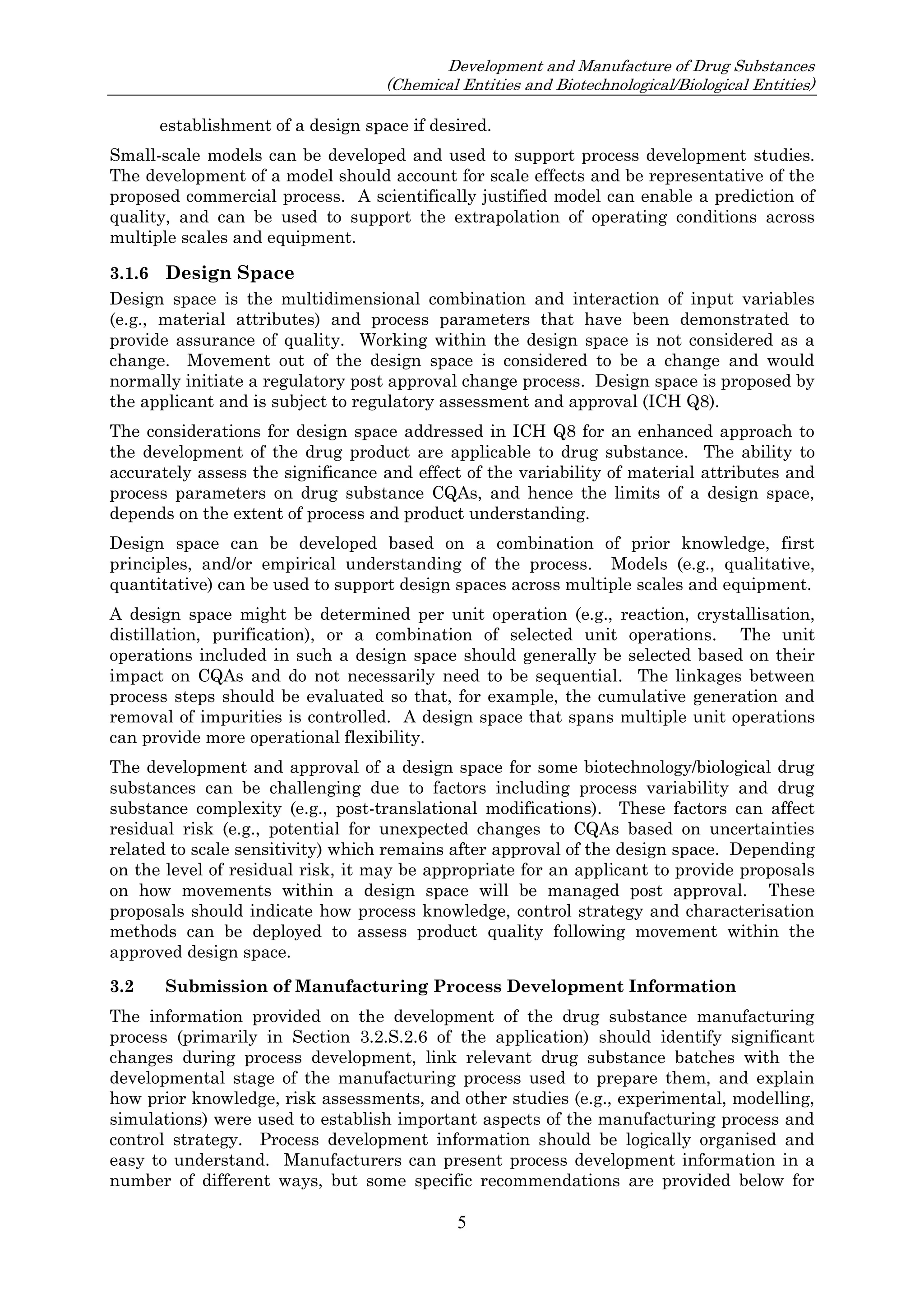
![Development and Manufacture of Drug Substances
(Chemical Entities and Biotechnological/Biological Entities)
6
consideration.
3.2.1 Overall Process Development Summary
It is recommended that the manufacturing process development section begin with a
narrative summary that describes important milestones in the development of the
process and explains how they are linked to assuring that the intended quality of the
drug substance is achieved. The following should be included in the summary:
List of drug substance CQAs;
Brief description of the stages in the evolution of the manufacturing process and
relevant changes to the control strategy;
Brief description of the material attributes and process parameters identified as
impacting drug substance CQAs;
Brief description of the development of any design spaces.
Following the overall process development summary, the manufacturing process
development section should include more comprehensive information, as recommended
below.
3.2.2 Drug Substance CQAs
The CQAs of the drug substance should be listed, and the rationale for designating these
properties or characteristics as CQAs should be provided. In some cases, it might be
appropriate to explain why other properties or characteristics that might be considered
potential CQAs are not included in the list of CQAs. Links or references should be
provided to information submitted elsewhere in the submission (e.g., 3.2.S.3.1,
Elucidation of Structure and other Characteristics) that supports the designation of
these properties or characteristics as CQAs. Some discussion of drug substance CQAs as
they relate to drug product CQAs can be appropriate in the pharmaceutical development
section of the application (e.g., 3.2.P.2.1 Components of the Drug Product).
3.2.3 Manufacturing Process History
A description and discussion should be provided of significant changes made to the
manufacturing process or site of manufacture of drug substance batches used in support
of the marketing application (e.g., those used in nonclinical or clinical studies or stability
studies in support of a marketing authorisation) and, if available, production-scale
batches. The description should usually follow a chronological sequence ending with the
proposed commercial process. Batch information (batch size or scale, site and date of
manufacture, route and process used, and intended purpose [e.g., in a specified
toxicology or clinical study]) and supporting data from comparative analytical testing on
relevant drug substance batches should be provided or referenced (e.g., Batch Analysis,
Section 3.2.S.4.4).
For biotechnological/biological drug substances, the reason for each significant change
should be explained, together with an assessment of its potential to impact the quality of
the drug substance (and/or intermediate, if appropriate). The manufacturing process
history section should include a discussion of comparability during development as
described in ICH Q5E. A discussion of the data, including a justification for selection of
the tests and assessment of results, should be included. Testing used to assess the
impact of manufacturing changes on the drug substance and the corresponding drug
product can also include nonclinical and clinical studies. Cross-reference to the location
of these studies in other modules of the submission should be included.](https://image.slidesharecdn.com/ichq11combine-230821090349-df7d2b39/75/ICH-Q11-Combine-pdf-10-2048.jpg)
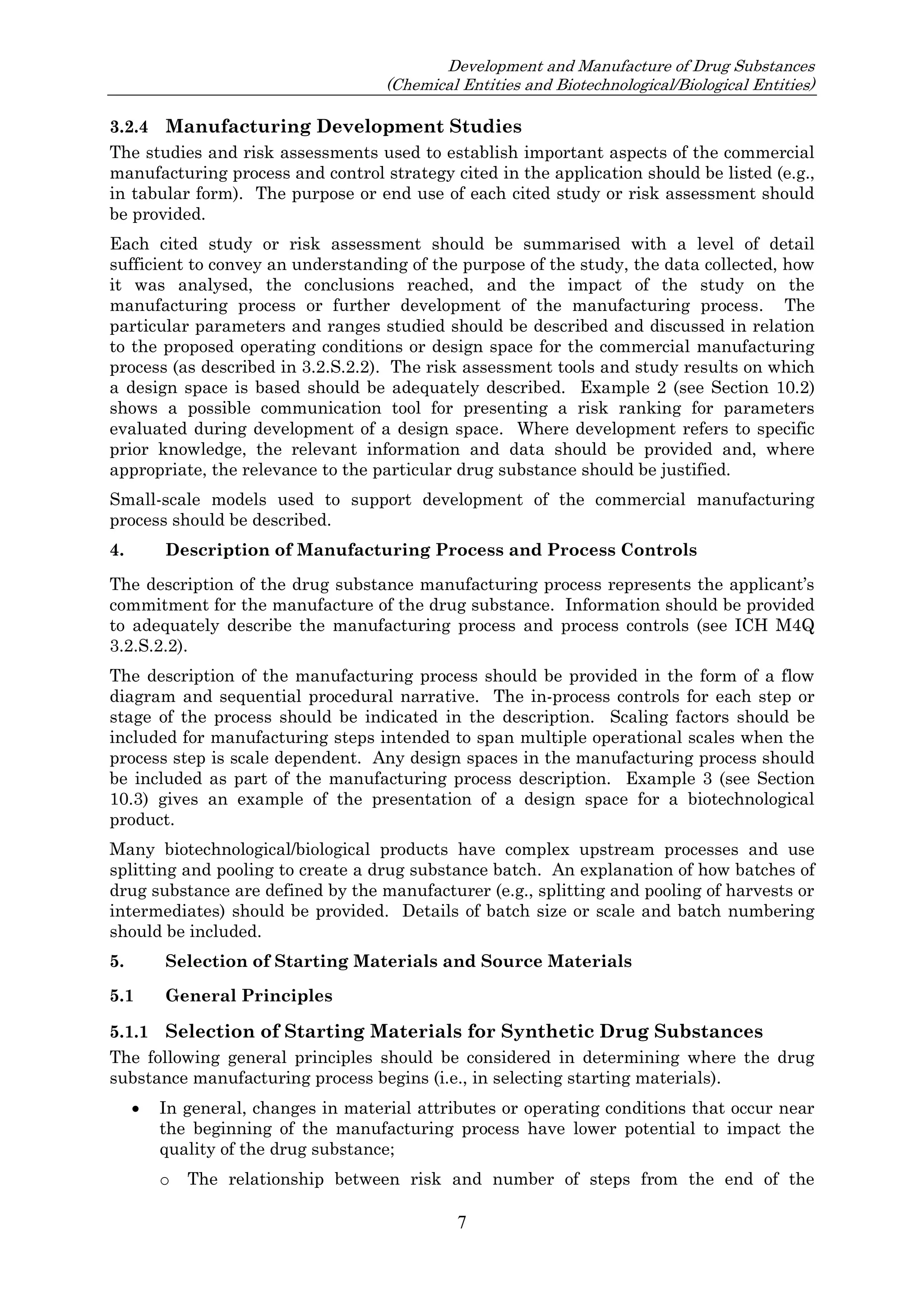
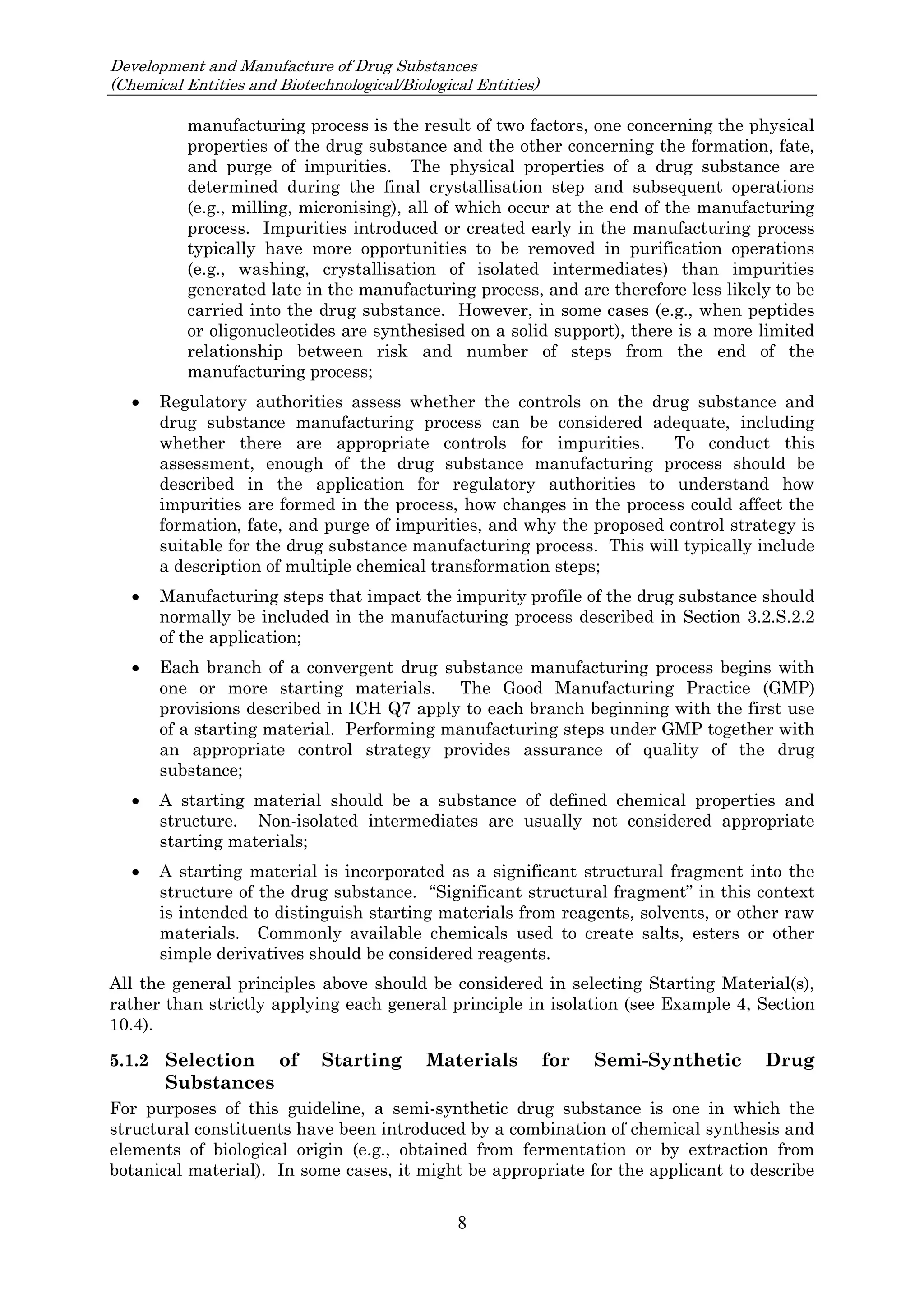
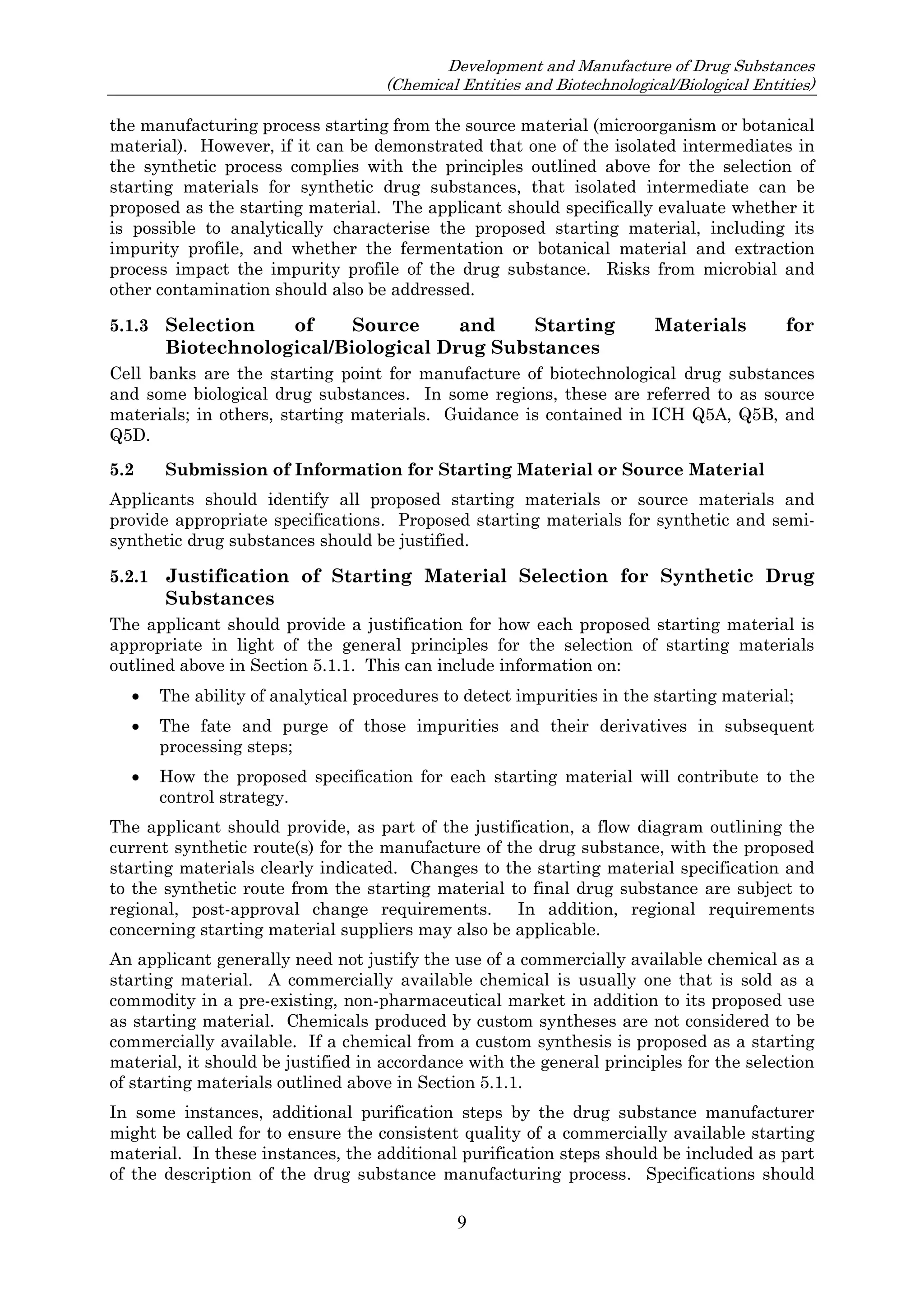
![Development and Manufacture of Drug Substances
(Chemical Entities and Biotechnological/Biological Entities)
10
normally be provided for both incoming and purified starting material.
5.2.2 Justification of Starting Material Selection for Semi-Synthetic
Drug Substances
If an isolated intermediate is proposed as the starting material for a semi-synthetic drug
substance, the applicant should provide a justification that explains how the proposed
starting material complies with the general principles for the selection of starting
materials outlined above in Section 5.1.1. Otherwise, the applicant should describe the
manufacturing process starting from the microorganism or botanical material, as
appropriate, and these materials should be qualified.
5.2.3 Qualification of Source or Starting Materials for
Biotechnological/Biological Drug Substances
Guidance is contained in ICH Q5A, Q5B and Q5D.
6. Control Strategy
6.1 General Principles
A control strategy is a planned set of controls, derived from current product and process
understanding, that assures process performance and product quality (ICH Q10). Every
drug substance manufacturing process, whether developed through a traditional or an
enhanced approach (or some combination thereof), has an associated control strategy.
A control strategy can include, but is not limited to, the following:
Controls on material attributes (including raw materials, starting materials,
intermediates, reagents, primary packaging materials for the drug substance,
etc.);
Controls implicit in the design of the manufacturing process (e.g., sequence of
purification steps [biotechnological/biological drug substances], or order of addition
of reagents [chemical entities]);
In-process controls (including in-process tests and process parameters);
Controls on drug substance (e.g., release testing).
6.1.1 Approaches to Developing a Control Strategy
A control strategy can be developed through a combination of approaches, utilising the
traditional approach for some CQAs, steps, or unit operations, and a more enhanced
approach for others.
In a traditional approach to developing a manufacturing process and control strategy, set
points and operating ranges are typically set narrowly based on the observed data to
ensure consistency of manufacture. More emphasis is placed on assessment of CQAs at
the stage of the drug substance (i.e., end-product testing). The traditional approach
provides limited flexibility in the operating ranges to address variability (e.g., in raw
materials).
An enhanced approach to manufacturing process development generates better process
and product understanding than the traditional approach, so sources of variability can
be identified in a more systematic way. This allows for the development of more
meaningful and efficient parametric, attribute, and procedural controls. The control
strategy might be developed through several iterations as the level of process
understanding increases during the product lifecycle. A control strategy based on an
enhanced approach can provide for flexibility in the operating ranges for process](https://image.slidesharecdn.com/ichq11combine-230821090349-df7d2b39/75/ICH-Q11-Combine-pdf-14-2048.jpg)
![Development and Manufacture of Drug Substances
(Chemical Entities and Biotechnological/Biological Entities)
11
parameters to address variability (e.g., in raw materials).
6.1.2 Considerations in Developing a Control Strategy
A control strategy should ensure that each drug substance CQA is within the
appropriate range, limit, or distribution to assure drug substance quality. The drug
substance specification is one part of a total control strategy and not all CQAs need to be
included in the drug substance specification. CQAs can be (1) included on the
specification and confirmed through testing the final drug substance, or (2) included on
the specification and confirmed through upstream controls (e.g., as in Real Time Release
Testing [RTRT]), or (3) not included on the specification but ensured through upstream
controls. Examples of upstream controls can include:
In process testing;
Use of measurements of process parameters and/or in process material attributes
that are predictive of a drug substance CQA. In some cases, Process Analytical
Technology (PAT) can be used to enhance control of the process and maintain output
quality.
Regardless of whether a traditional or enhanced process development approach is taken,
the use of upstream controls should be based on an evaluation and understanding of the
sources of variability of a CQA. Downstream factors that might impact the quality of the
drug substance, such as temperature changes, oxidative conditions, light, ionic content,
and shear, should be taken into consideration.
When developing a control strategy, a manufacturer can consider implementing controls
for a specific CQA at single or multiple locations in the process, depending on the risk
associated with the CQA and the ability of individual controls to detect a potential
problem. For example, with sterilised chemical entities or biotechnological/biological
drug substances, there is an inherent limitation in the ability to detect low levels of
bacterial or viral contamination. In these cases, testing on the drug substance is
considered to provide inadequate assurance of quality, so additional controls (e.g.,
attribute and in-process controls) are incorporated into the control strategy.
The quality of each raw material used in the manufacturing process should be
appropriate for its intended use. Raw materials used in operations near the end of the
manufacturing process have a greater potential to introduce impurities into the drug
substance than raw materials used upstream. Therefore, manufacturers should evaluate
whether the quality of such materials should be more tightly controlled than similar
materials used upstream.
6.2 Submission of Control Strategy Information
The information provided on the control strategy should include detailed descriptions of
the individual elements of the control strategy plus, when appropriate, a summary of the
overall drug substance control strategy. The summary of the overall control strategy can
be presented in either a tabular format or in a diagrammatic format, to aid visualisation
and understanding (see Example 5, Section 10.5 for example of a control strategy
summary in tabular form). Ideally, the summary should explain how the individual
elements of the control strategy work together to assure drug substance quality.
ICH M4Q recommends that the individual elements of the control strategy reported in
an application be provided in the appropriate sections of a submission, including:
Description of Manufacturing Process and Process Controls (3.2.S.2.2);
Control of Materials (3.2.S.2.3);](https://image.slidesharecdn.com/ichq11combine-230821090349-df7d2b39/75/ICH-Q11-Combine-pdf-15-2048.jpg)


![Development and Manufacture of Drug Substances
(Chemical Entities and Biotechnological/Biological Entities)
14
section of the application that includes the justification of the drug substance
specification (3.2.S.4.5).
8.4 Control Strategy
Although the drug substance specification is only one part of the total control strategy,
the section of the application that includes the justification of the drug substance
specification (3.2.S.4.5) is a good place to summarise the overall drug substance control
strategy. However, detailed information about input material controls, process controls,
and control of drug substance should still be provided in the appropriate CTD format
sections (e.g., description of manufacturing process and process controls [3.2.S.2.2],
control of materials [3.2.S.2.3], controls of critical steps and intermediates [3.2.S.2.4],
drug substance specification [3.2.S.4.1]). A brief description of relevant changes to the
control strategy during the evolution of the manufacturing process should be provided in
Section 3.2.S.2.6 of the application.
9. Lifecycle Management
The quality system elements and management responsibilities described in ICH Q10 are
intended to encourage the use of science-based and risk-based approaches at each
lifecycle stage, thereby promoting continual improvement across the entire product
lifecycle. Product and process knowledge should be managed from development through
the commercial life of the product up to and including product discontinuation.
The development and improvement of a drug substance manufacturing process usually
continues over its lifecycle. Manufacturing process performance, including the
effectiveness of the control strategy, should be periodically evaluated. Knowledge gained
from commercial manufacturing can be used to further improve process understanding
and process performance and to adjust the control strategy to ensure drug substance
quality. Knowledge gained from other products, or from new innovative technologies,
can also contribute to these goals. Continual improvement and successful process
validation, or continuous process verification, call for an appropriate and effective control
strategy.
There should be a systematic approach to managing knowledge related to both drug
substance and its manufacturing process throughout the lifecycle. This knowledge
management should include but not be limited to process development activities,
technology transfer activities to internal sites and contract manufacturers, process
validation studies over the lifecycle of the drug substance, and change management
activities. The knowledge and process understanding should be shared as needed to
perform the manufacturing process and implement the control strategy across sites
involved in manufacturing the drug substance.
An applicant can include in the original submission a proposal for how specific future
changes will be managed during the product lifecycle, including changes to the control
strategy. As an example of life cycle management of process parameters for a
biotechnological product, see Example 2, Section 10.2.
Any proposed change to the manufacturing process should be evaluated for the impact on
the quality of drug substance and, when appropriate, drug product. This evaluation
should be based on scientific understanding of the manufacturing process and should
determine appropriate testing to analyse the impact of the proposed change. For
chemical entities the appropriate testing to analyse the impact of the proposed change
could include, but is not limited to, an assessment of current and potential new
impurities and an assessment of the test procedures’ abilities to detect any new
impurities. This testing should be performed at an appropriate point in the process (e.g.,](https://image.slidesharecdn.com/ichq11combine-230821090349-df7d2b39/75/ICH-Q11-Combine-pdf-18-2048.jpg)
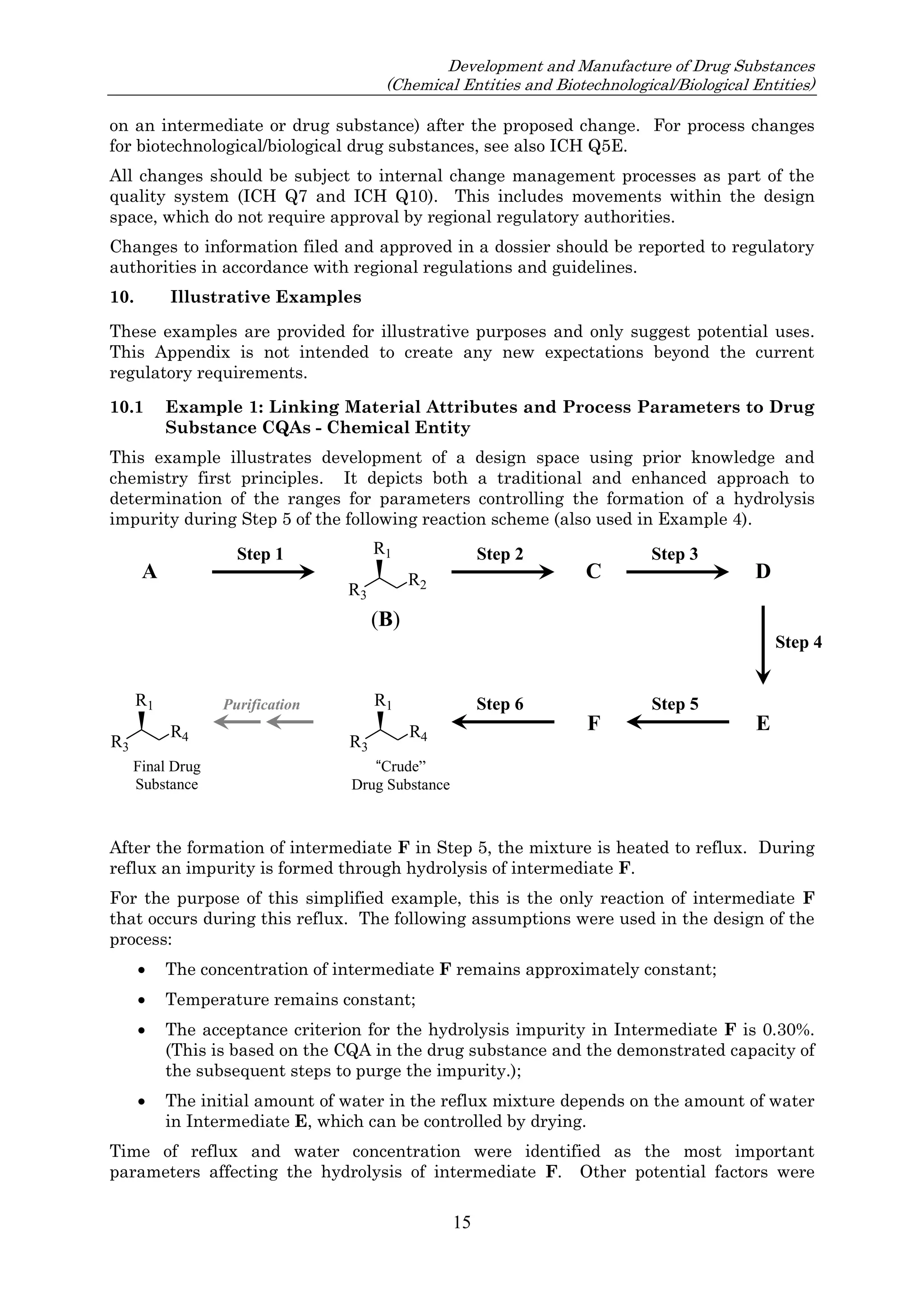
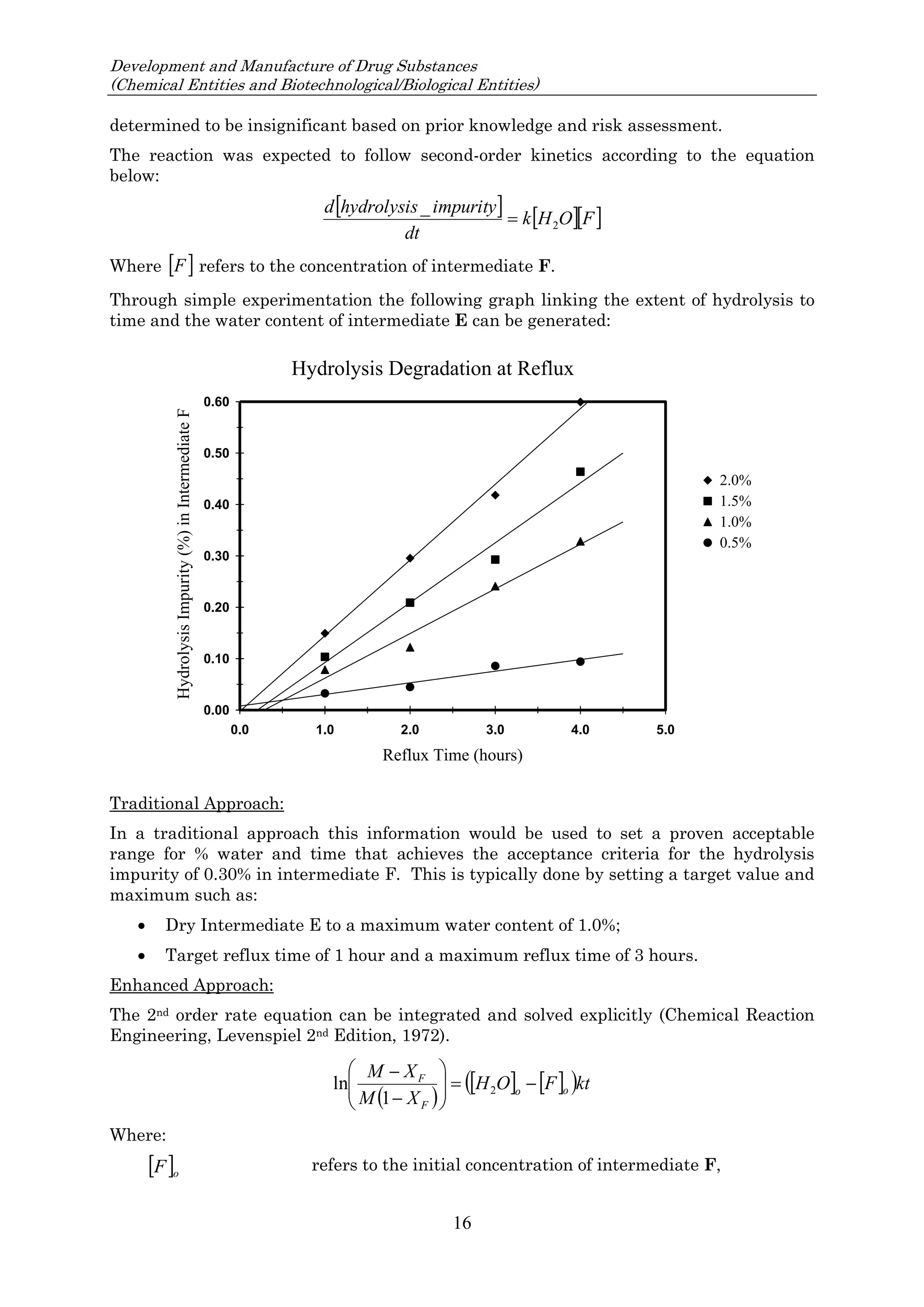
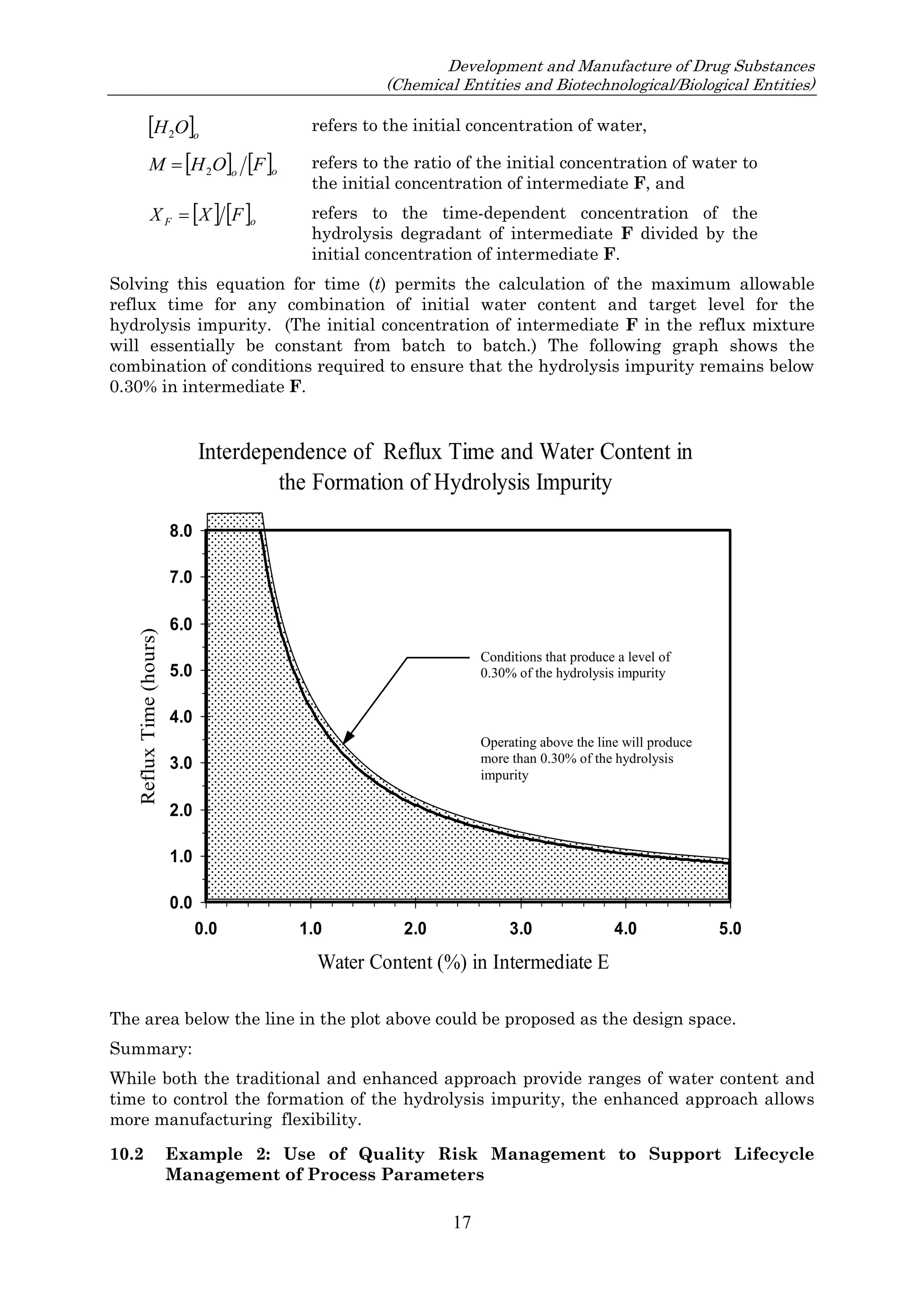
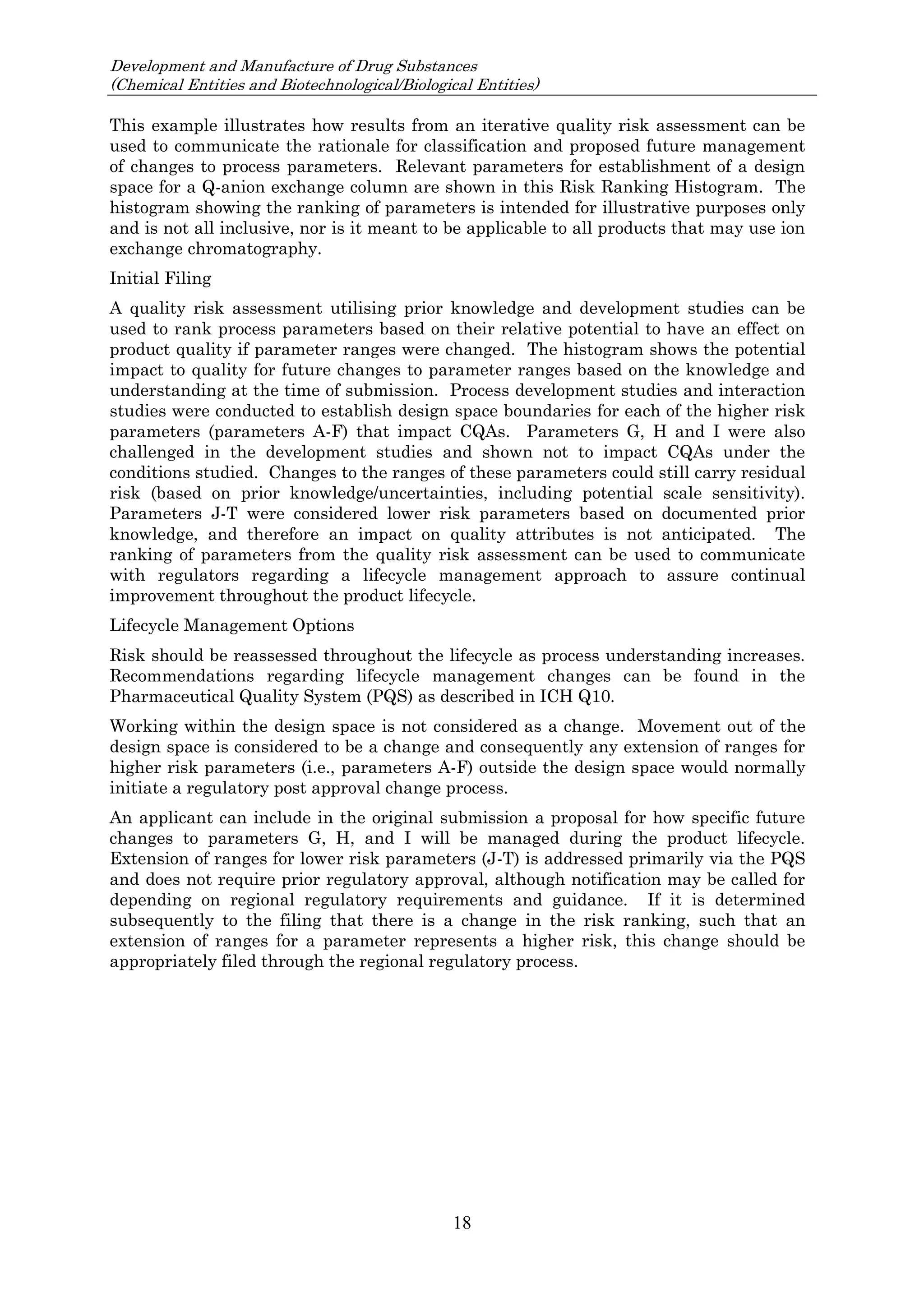
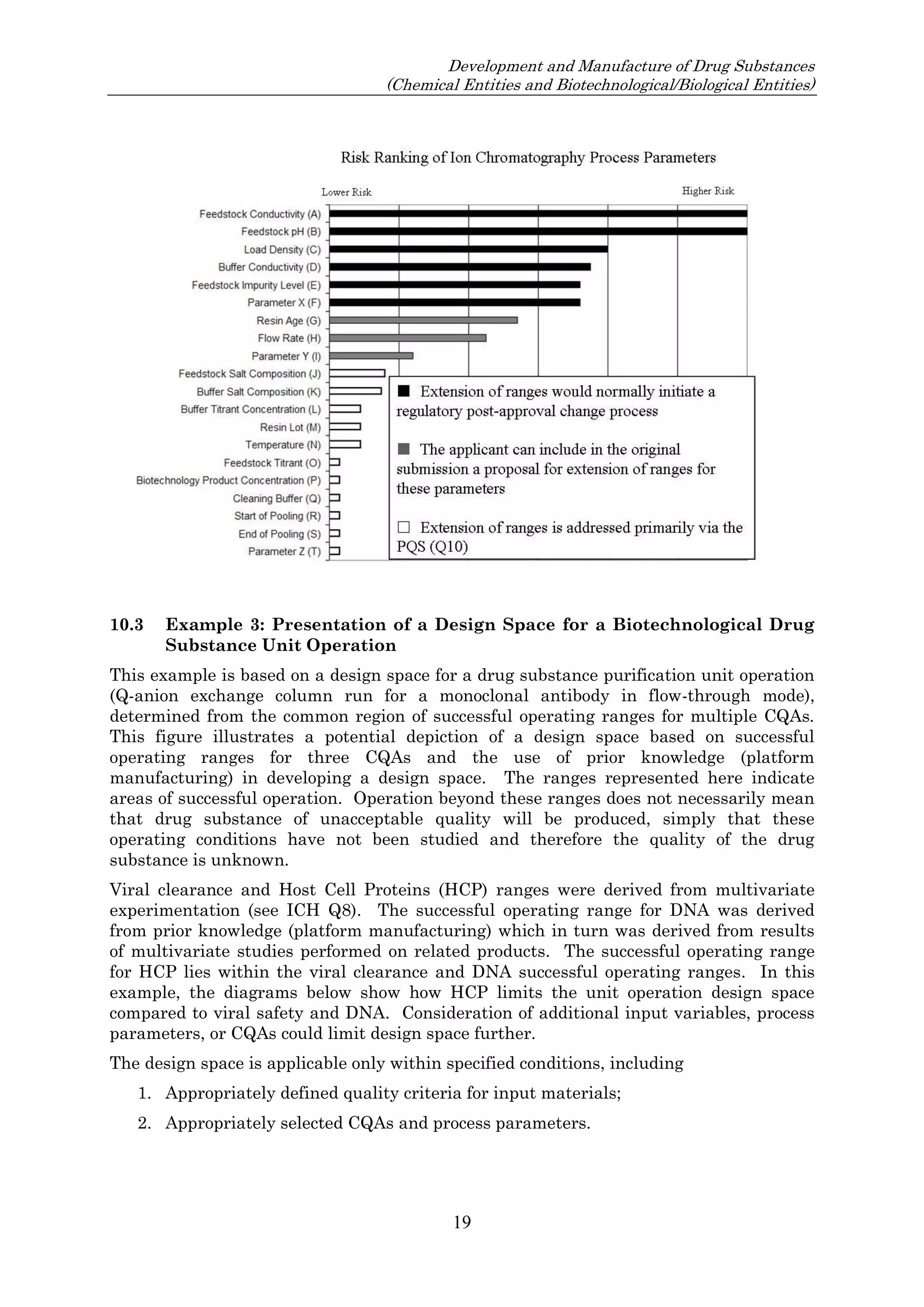
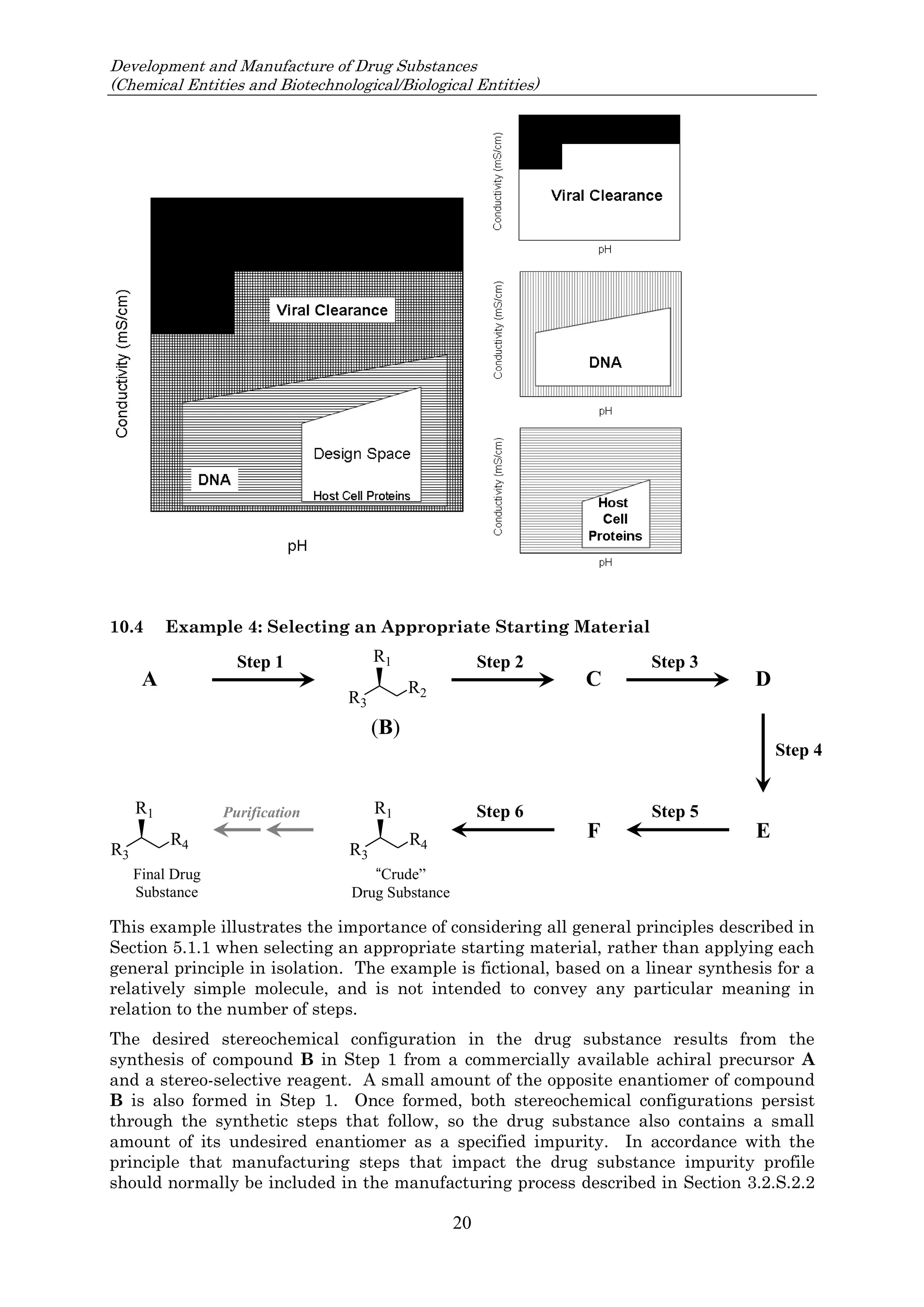
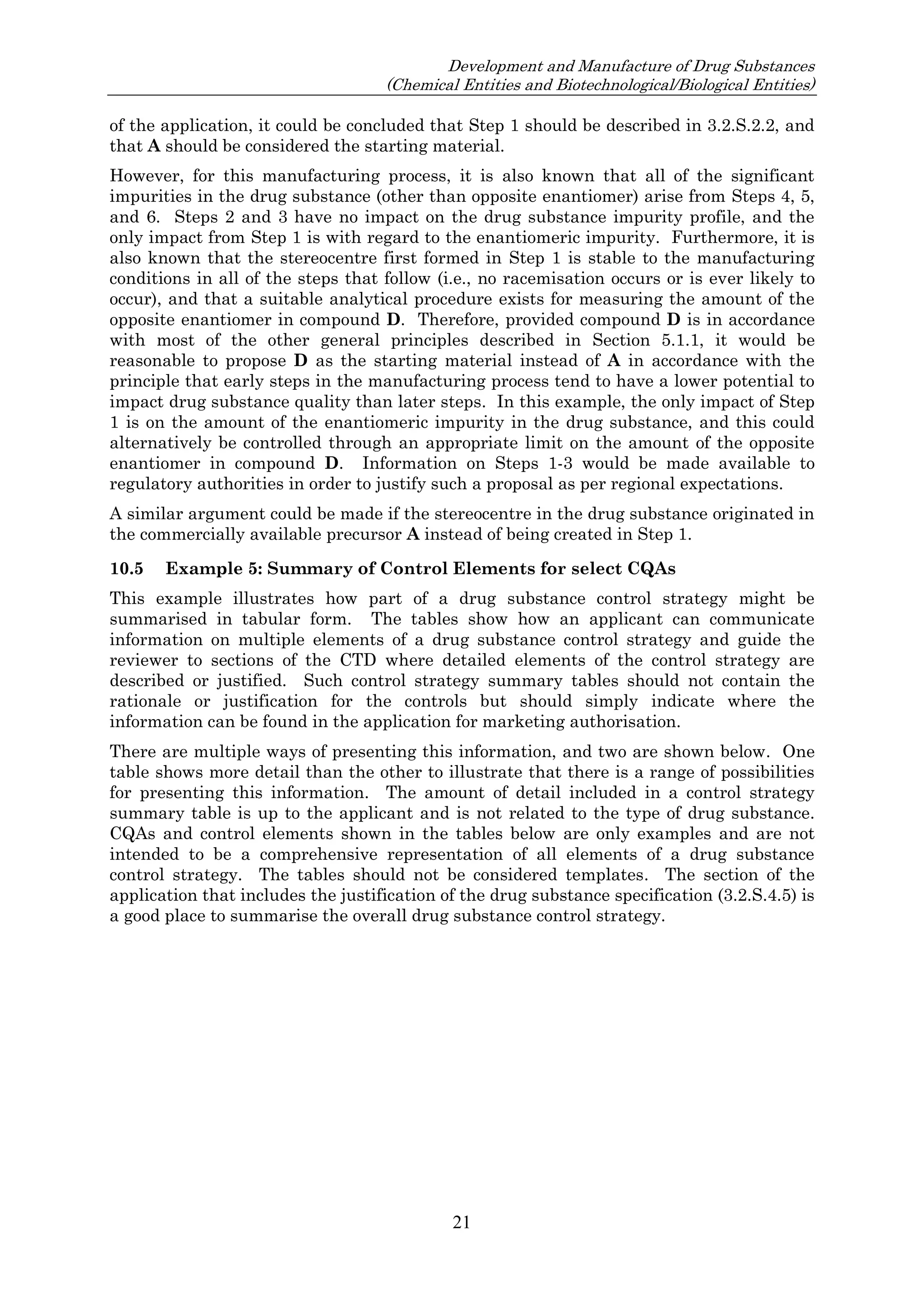
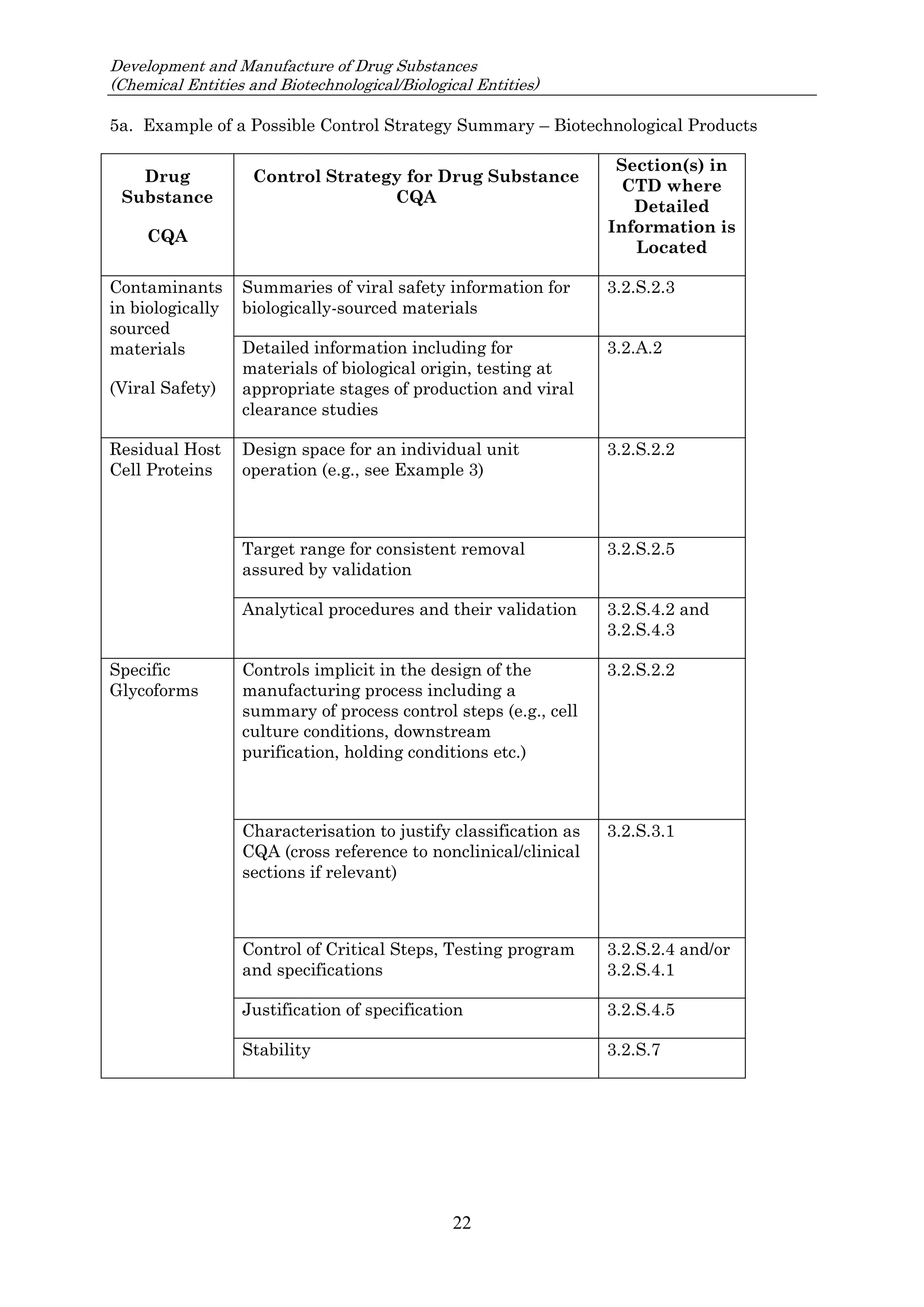
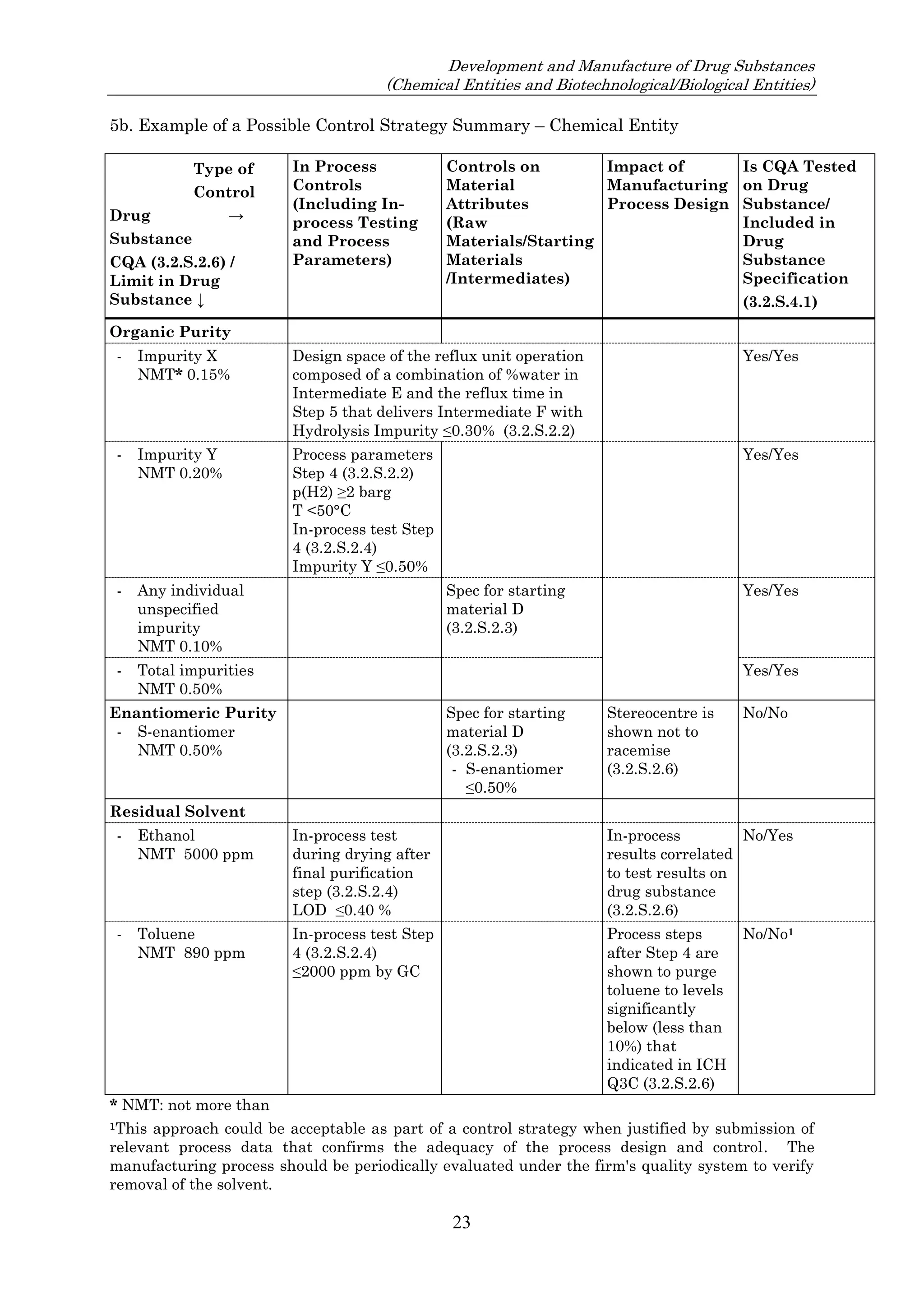
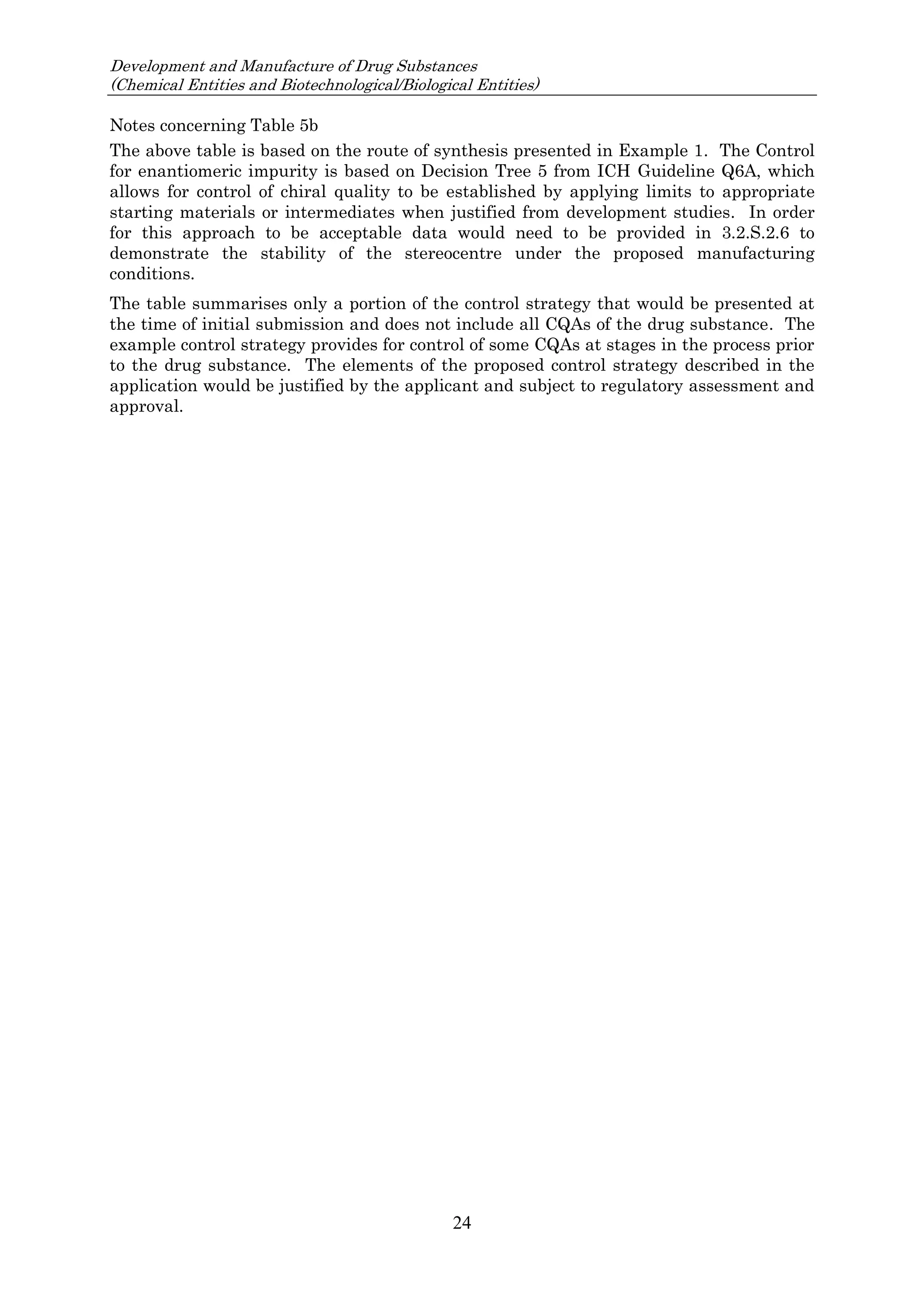
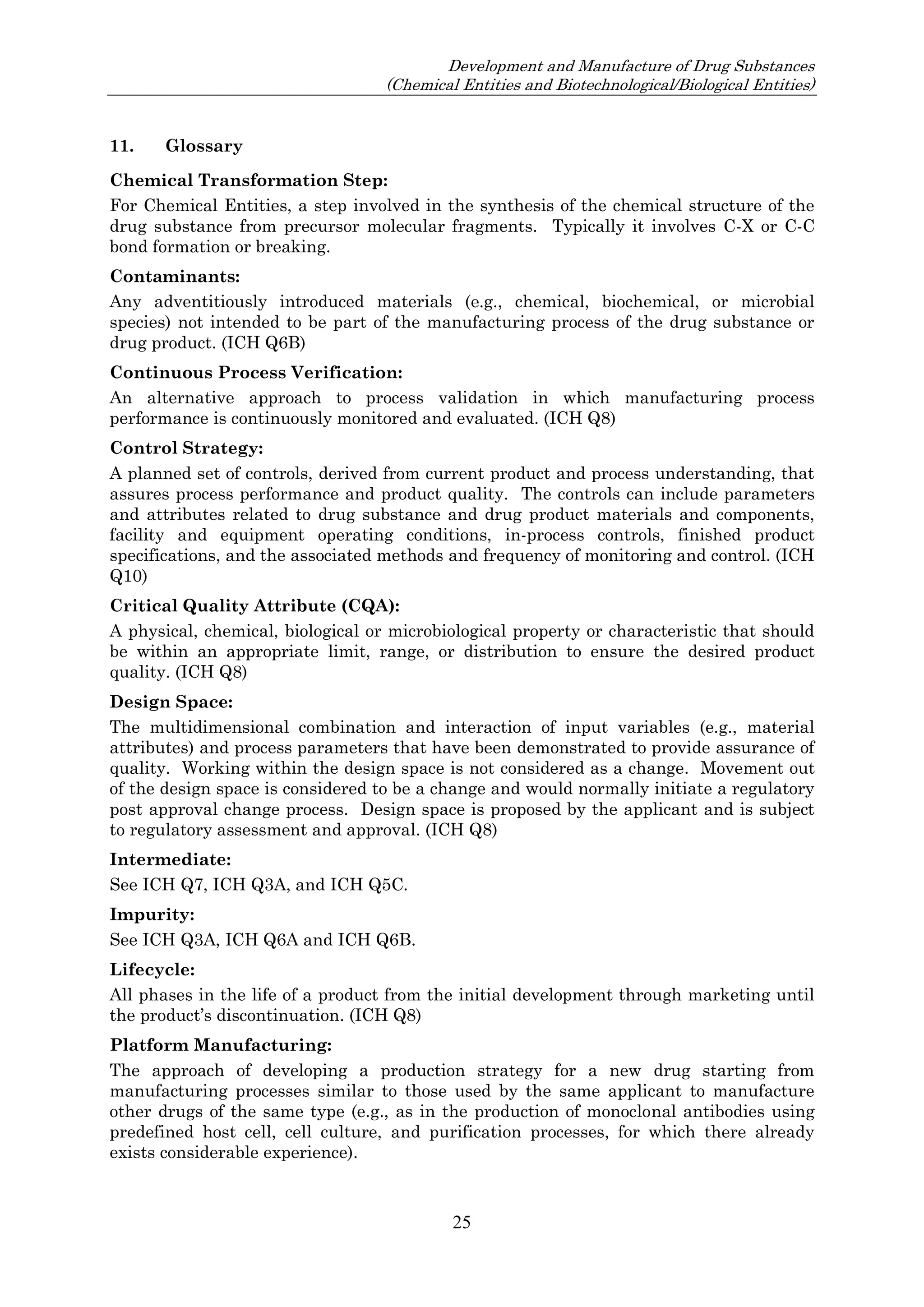
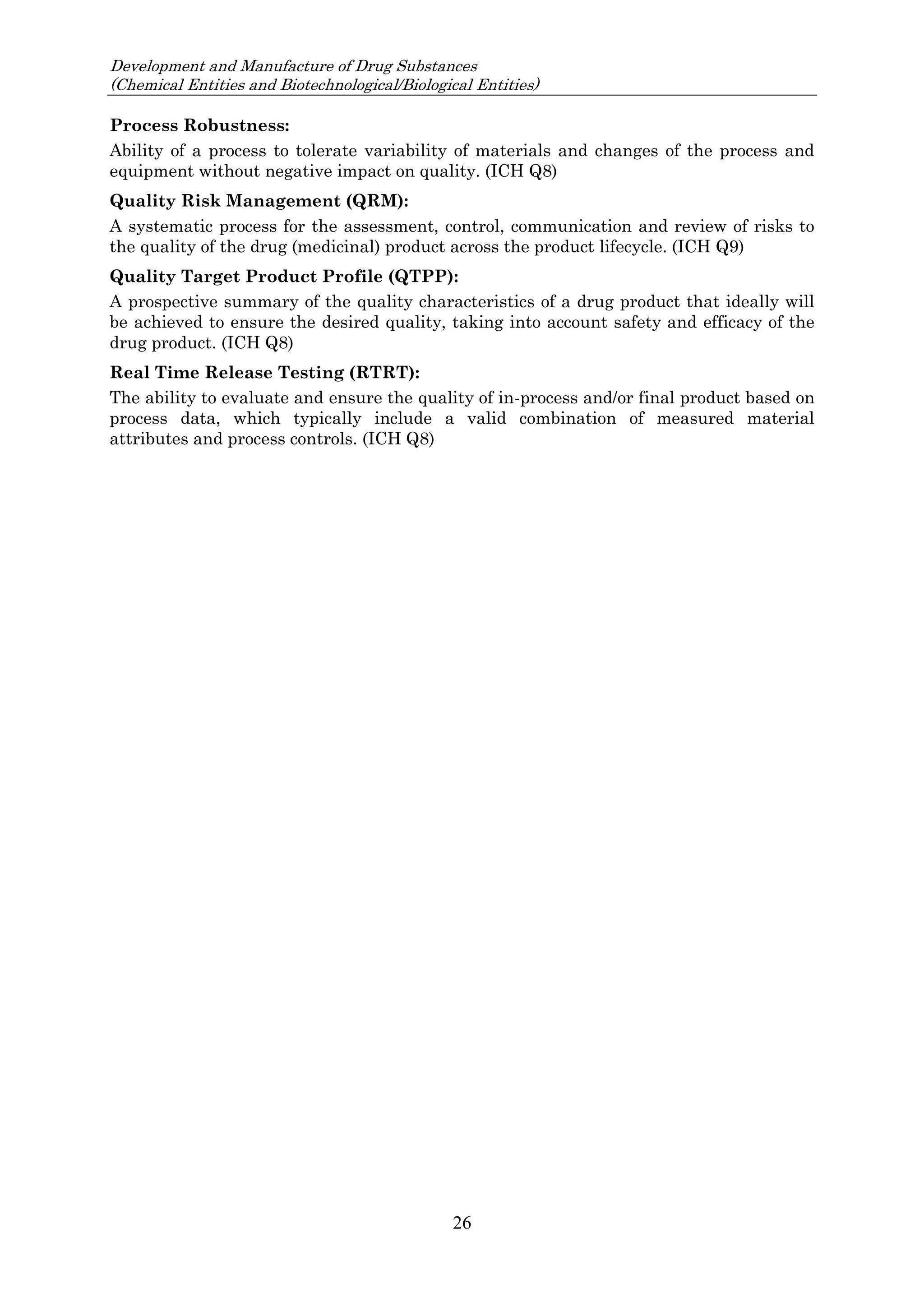
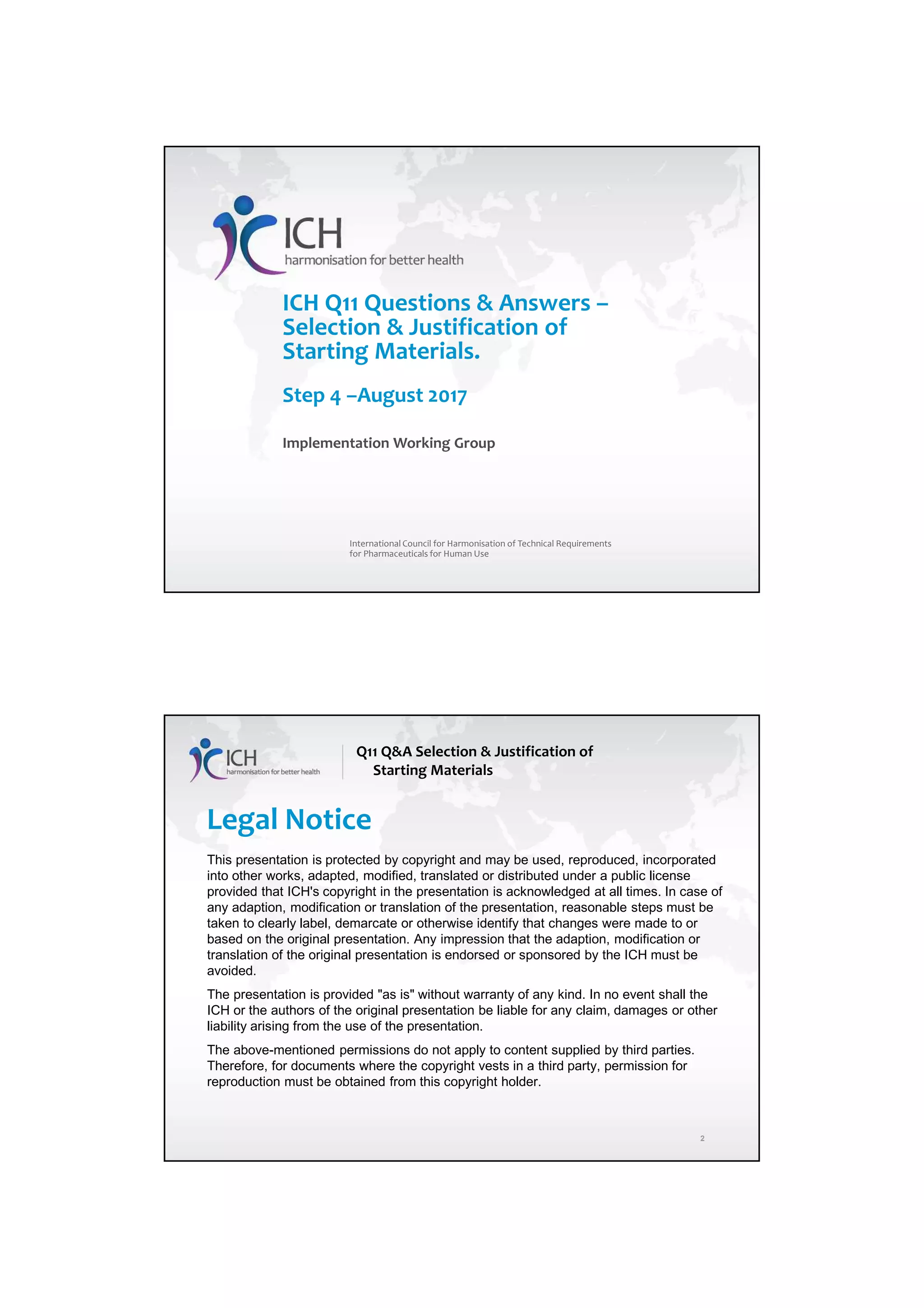
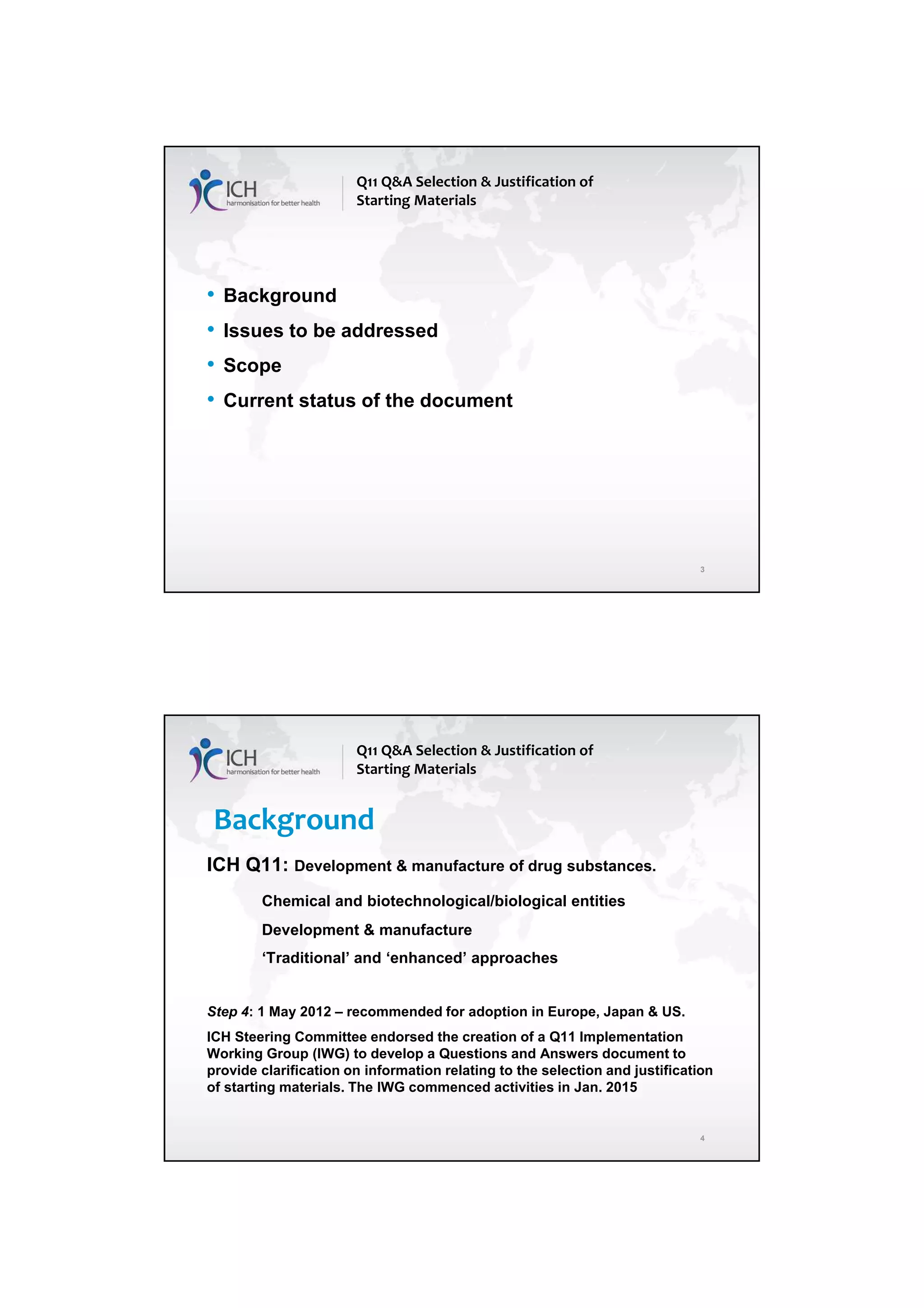
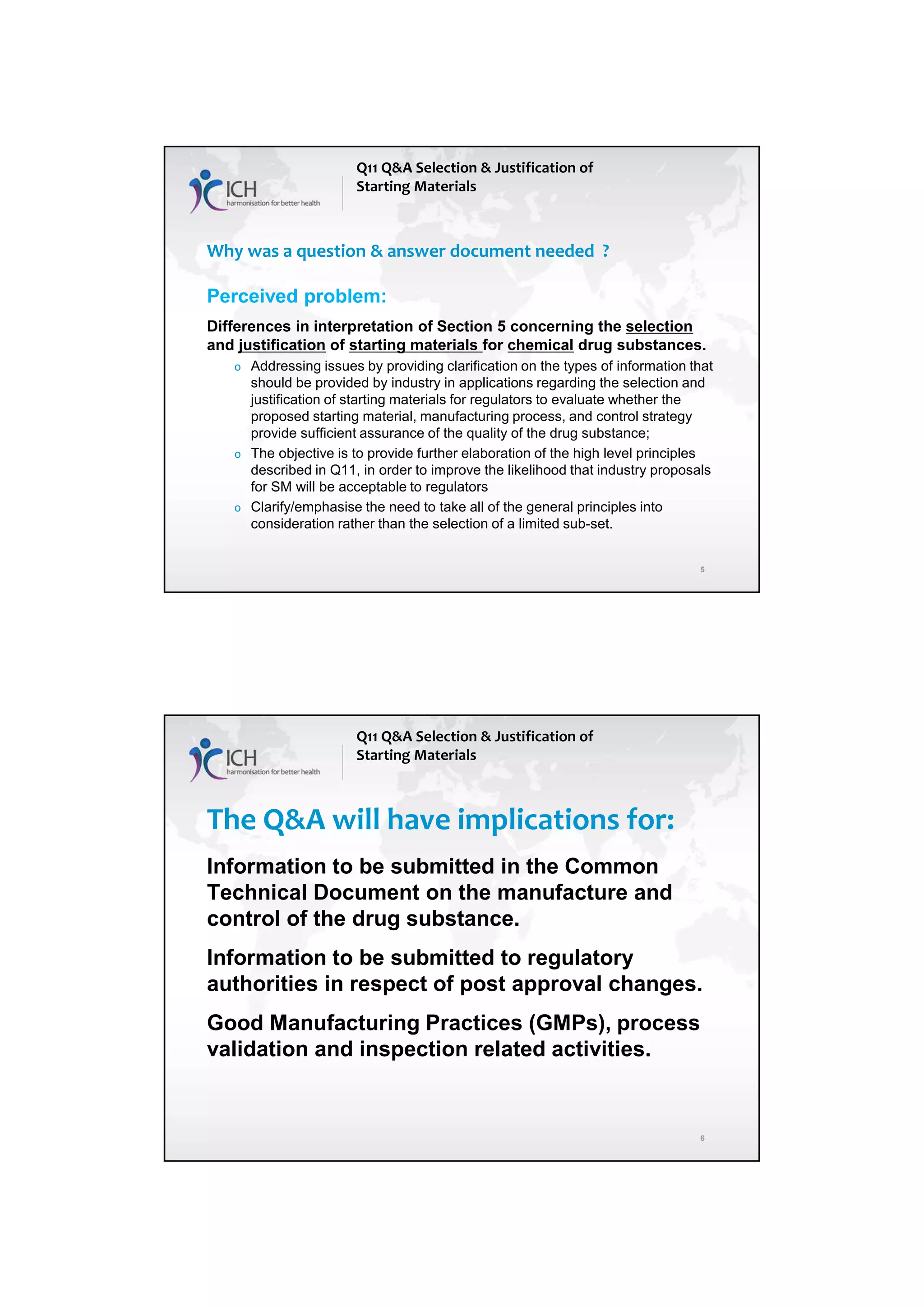
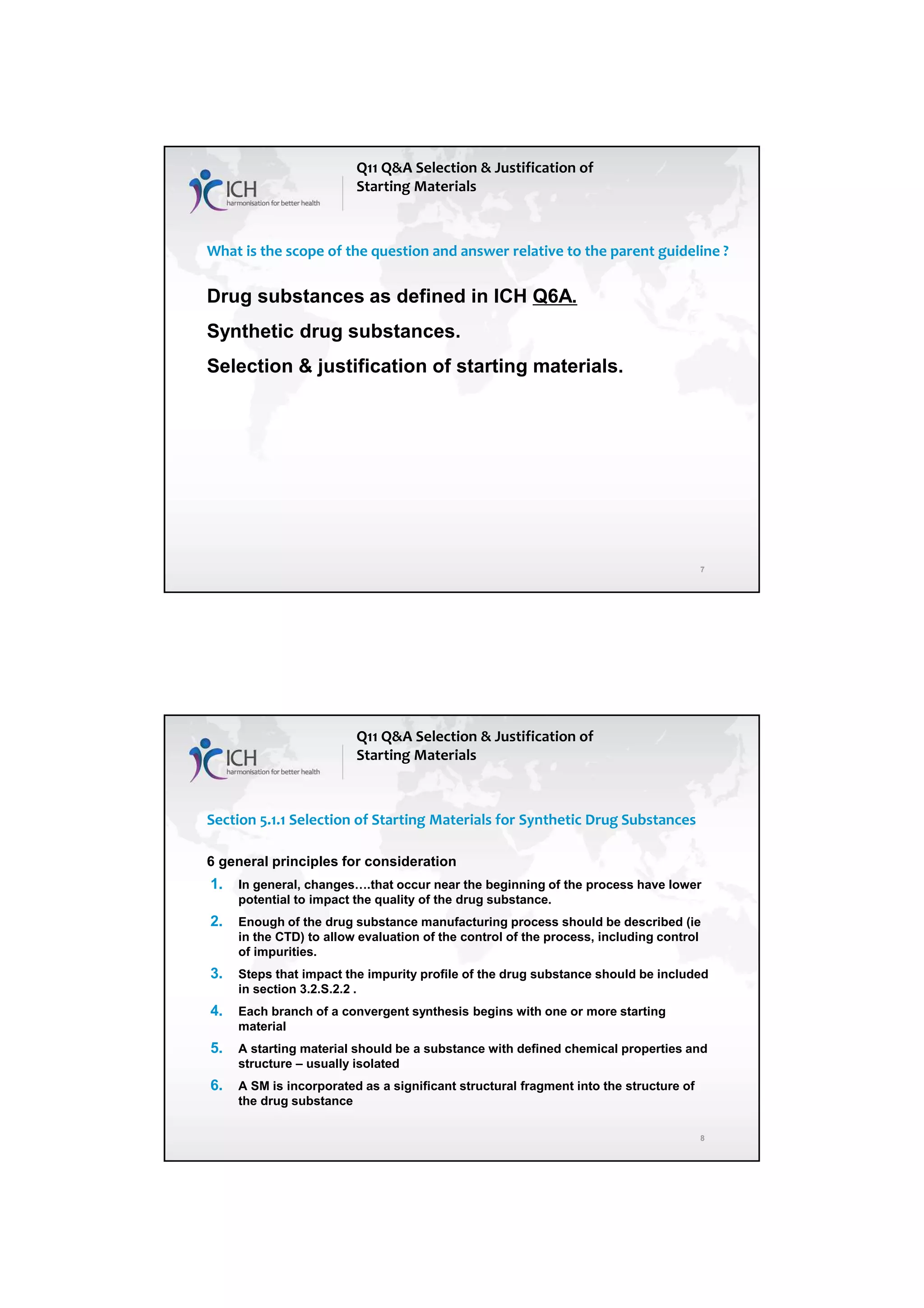
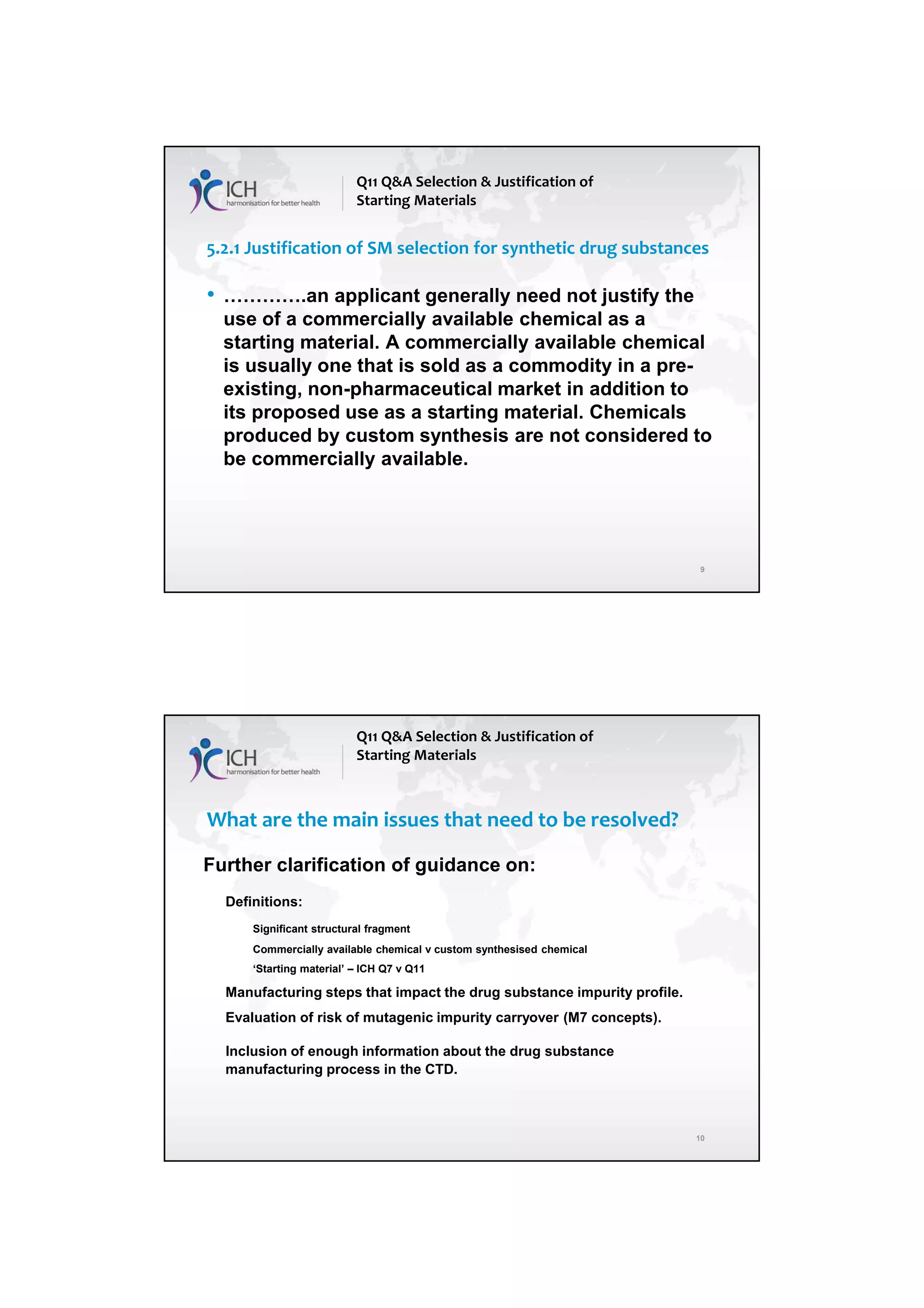

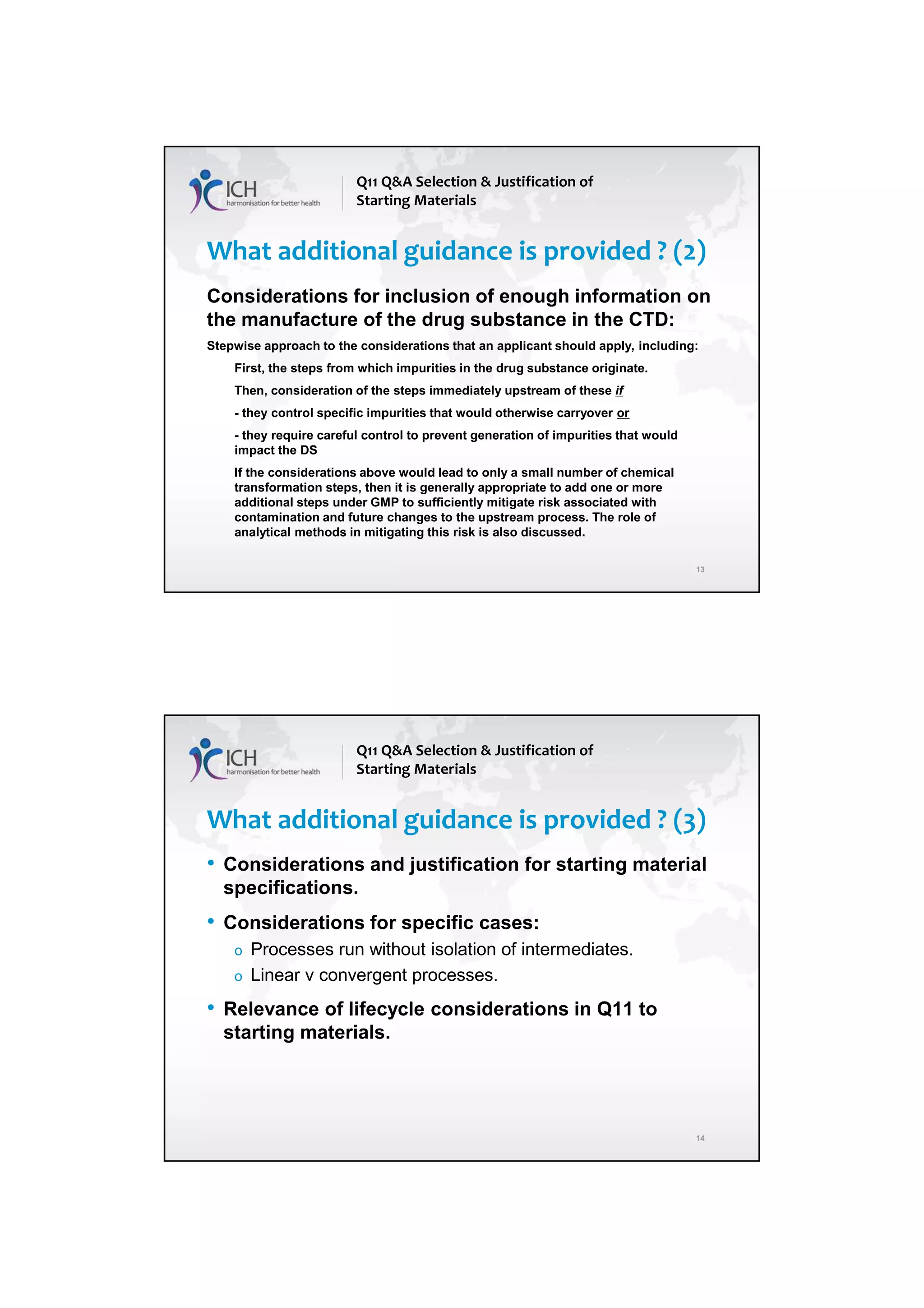
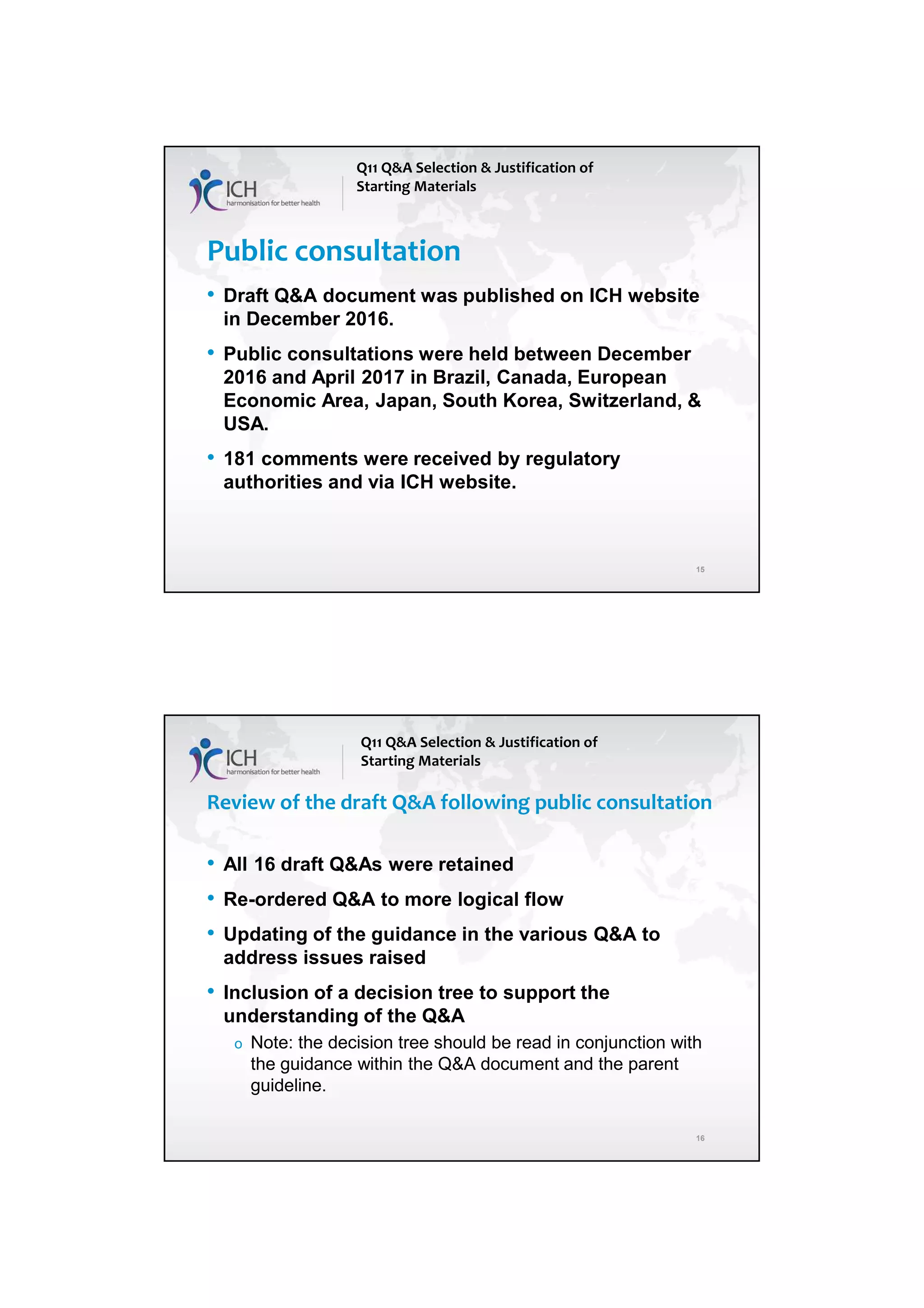
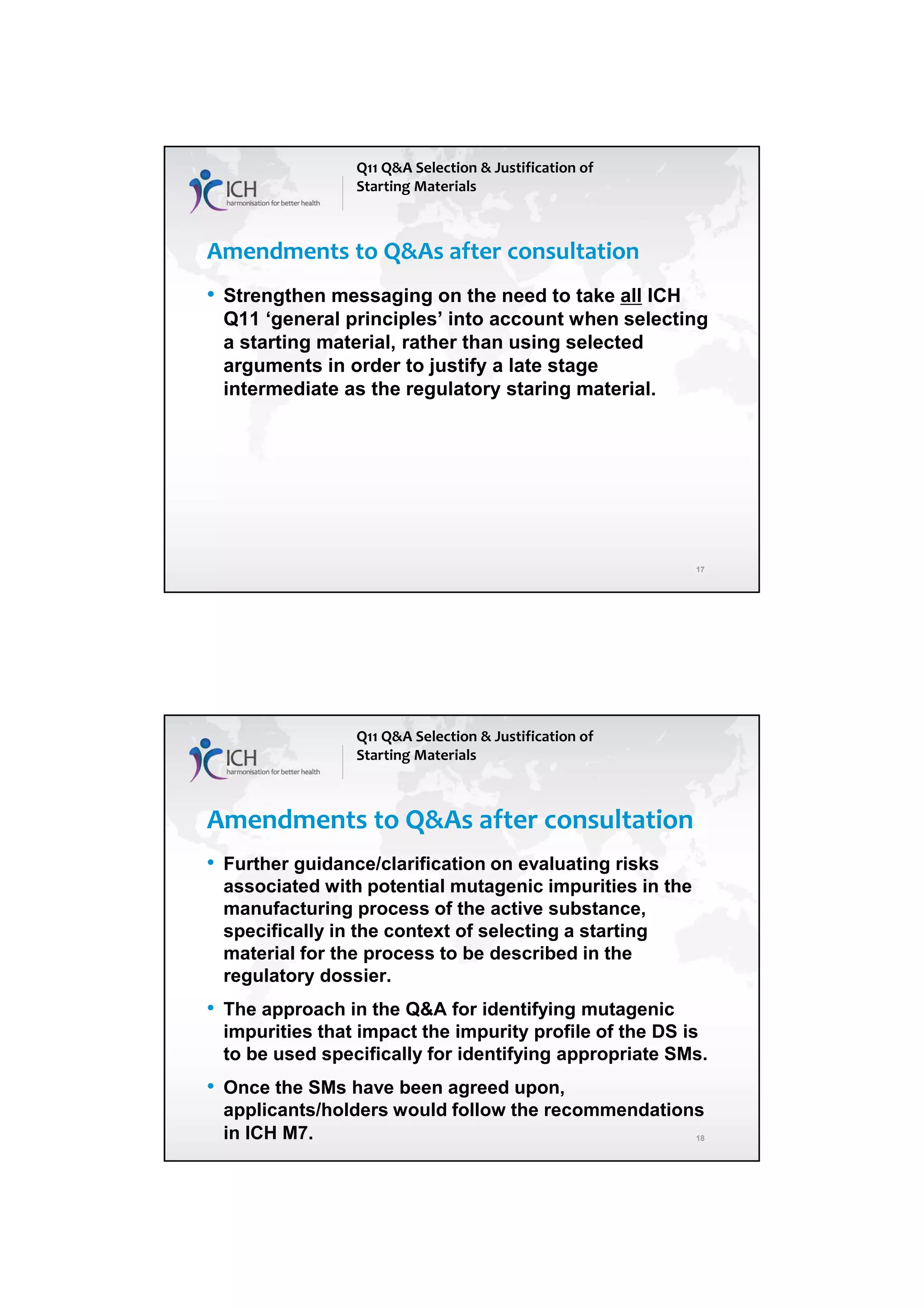
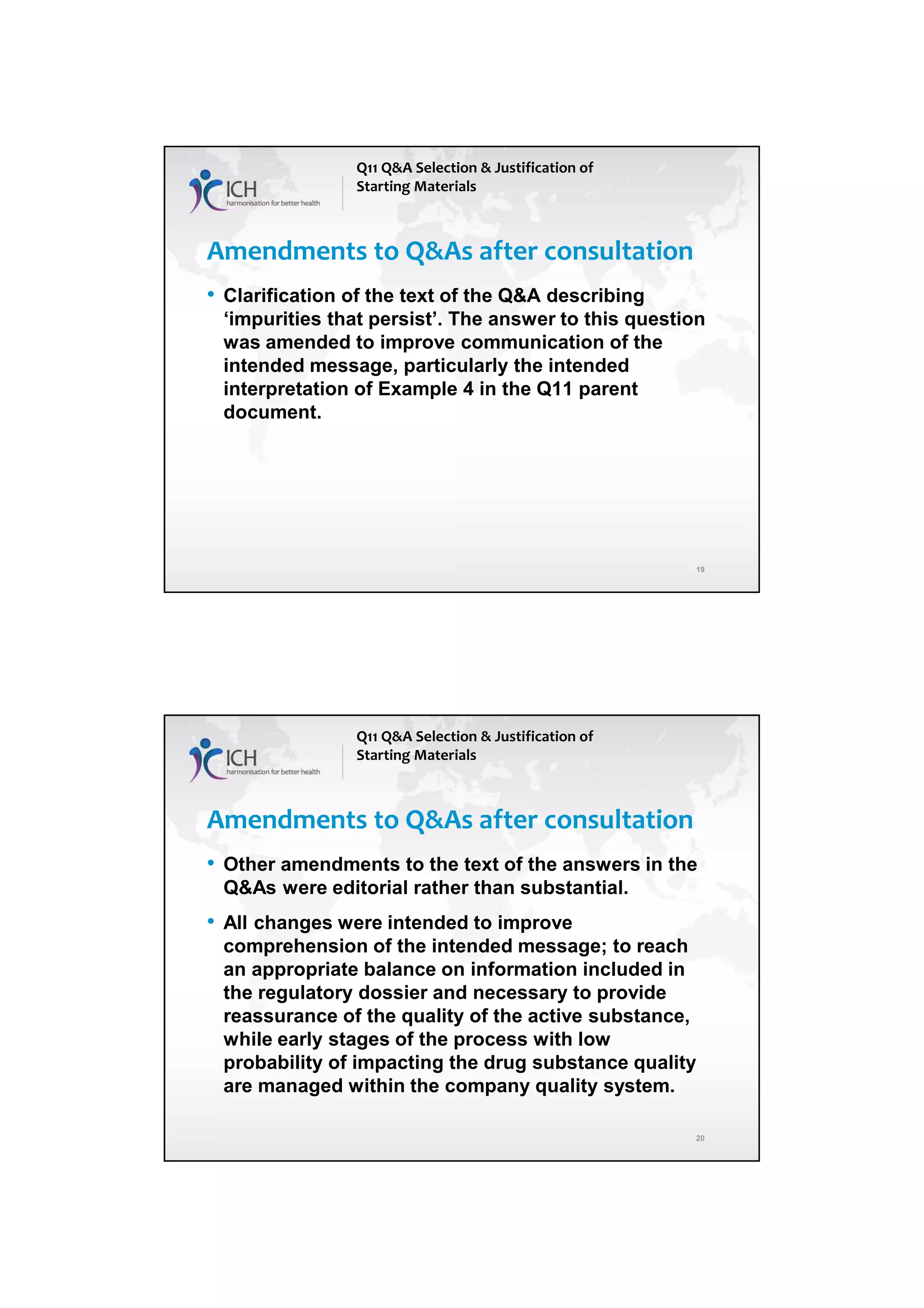
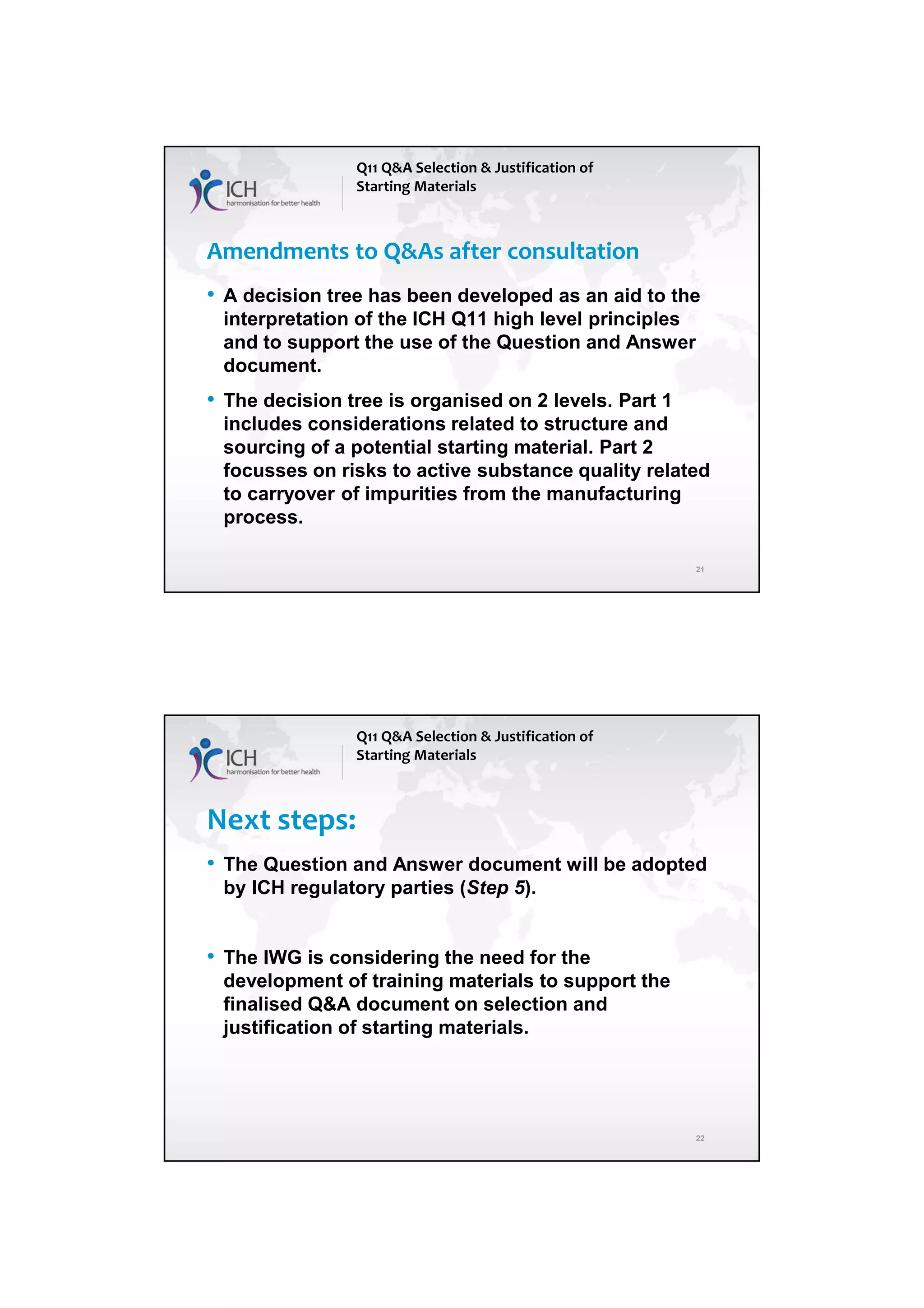

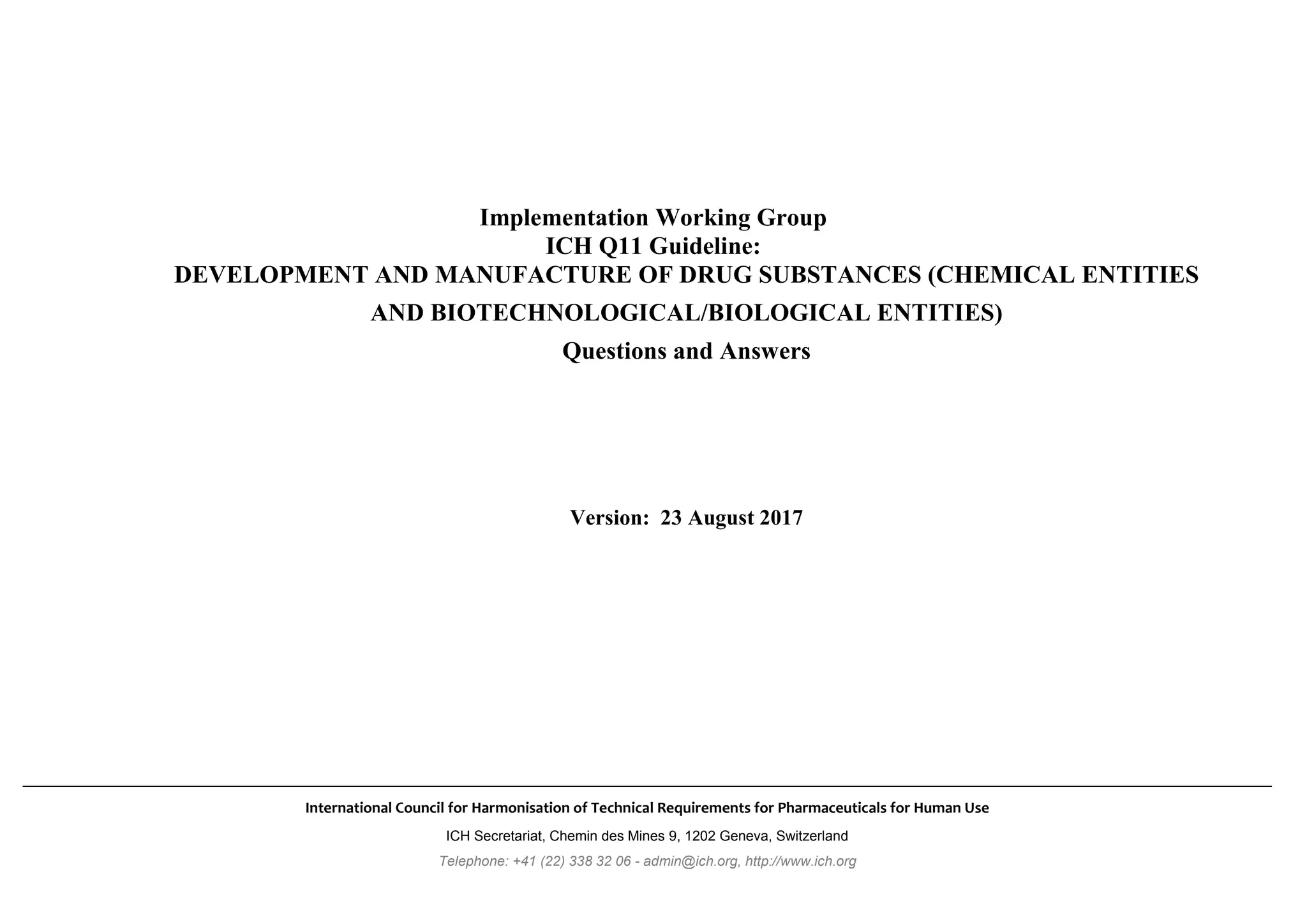
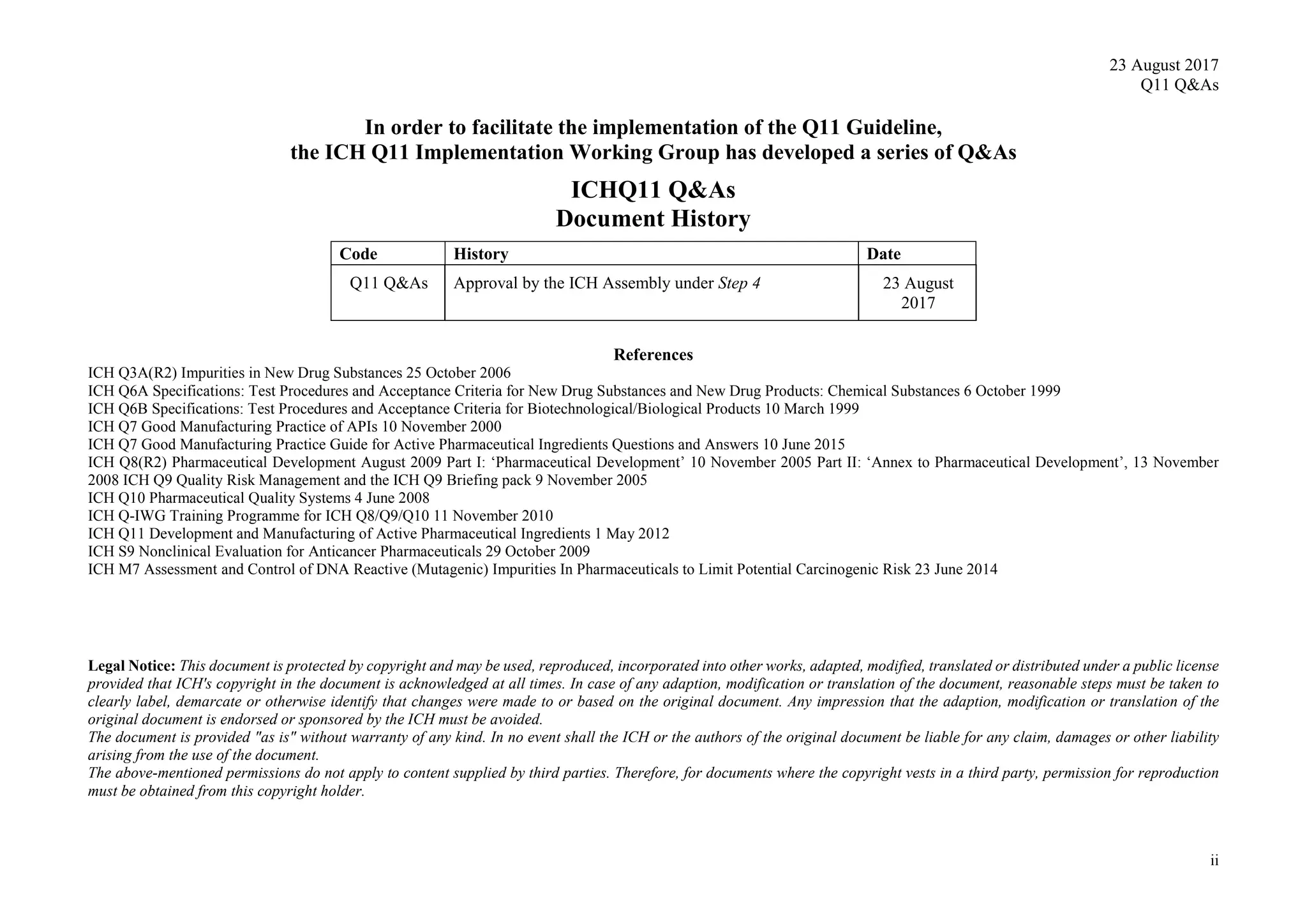
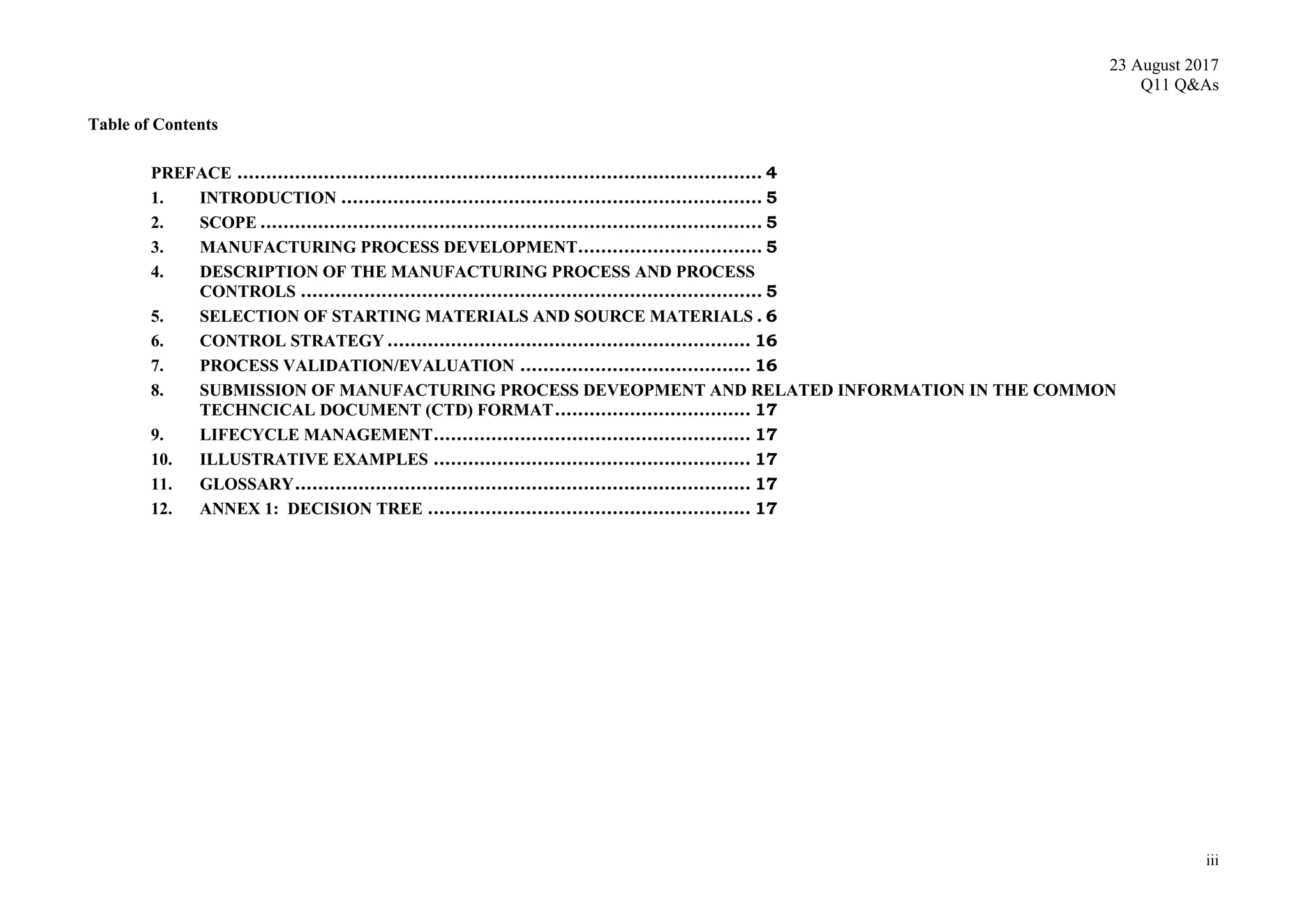
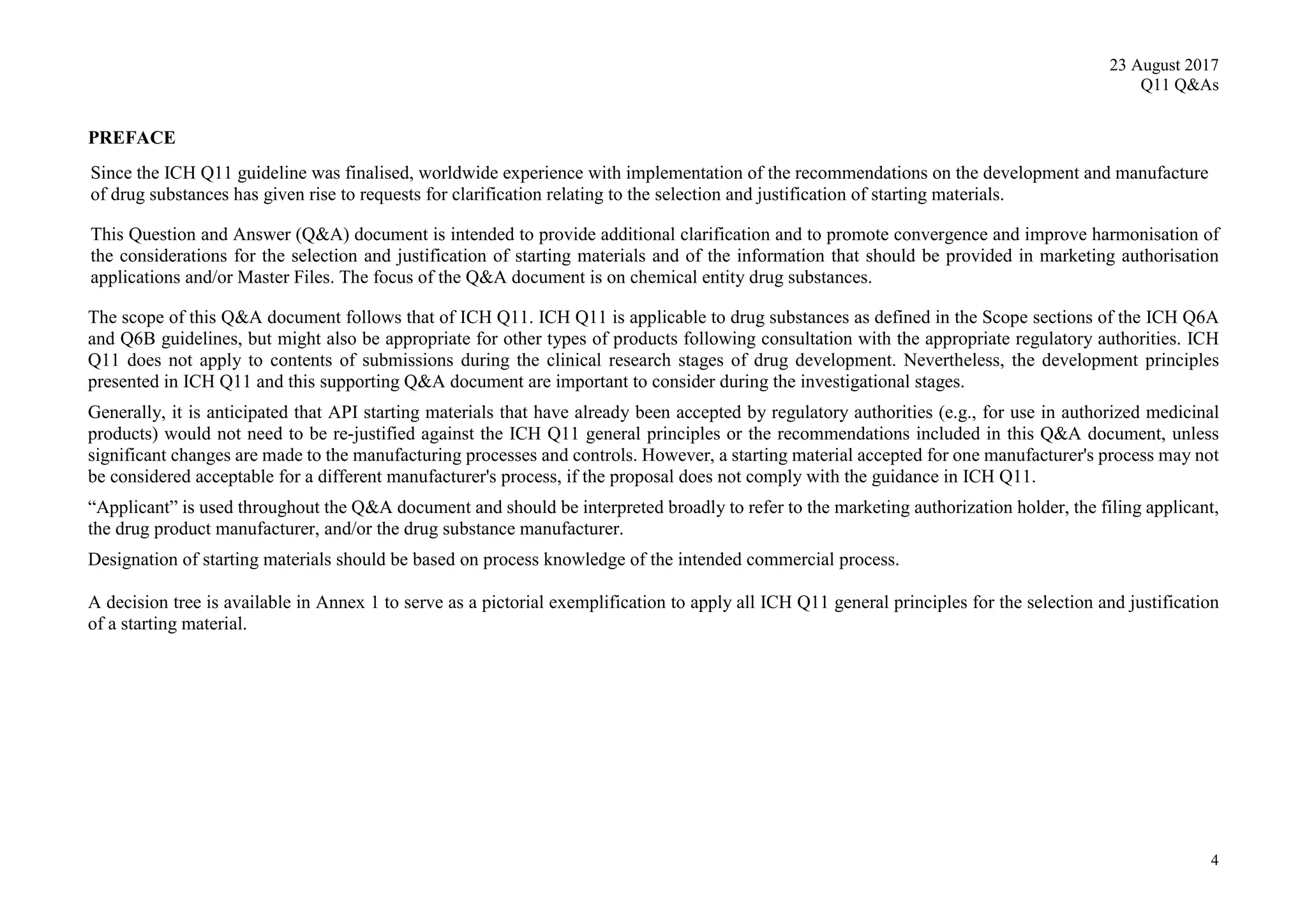
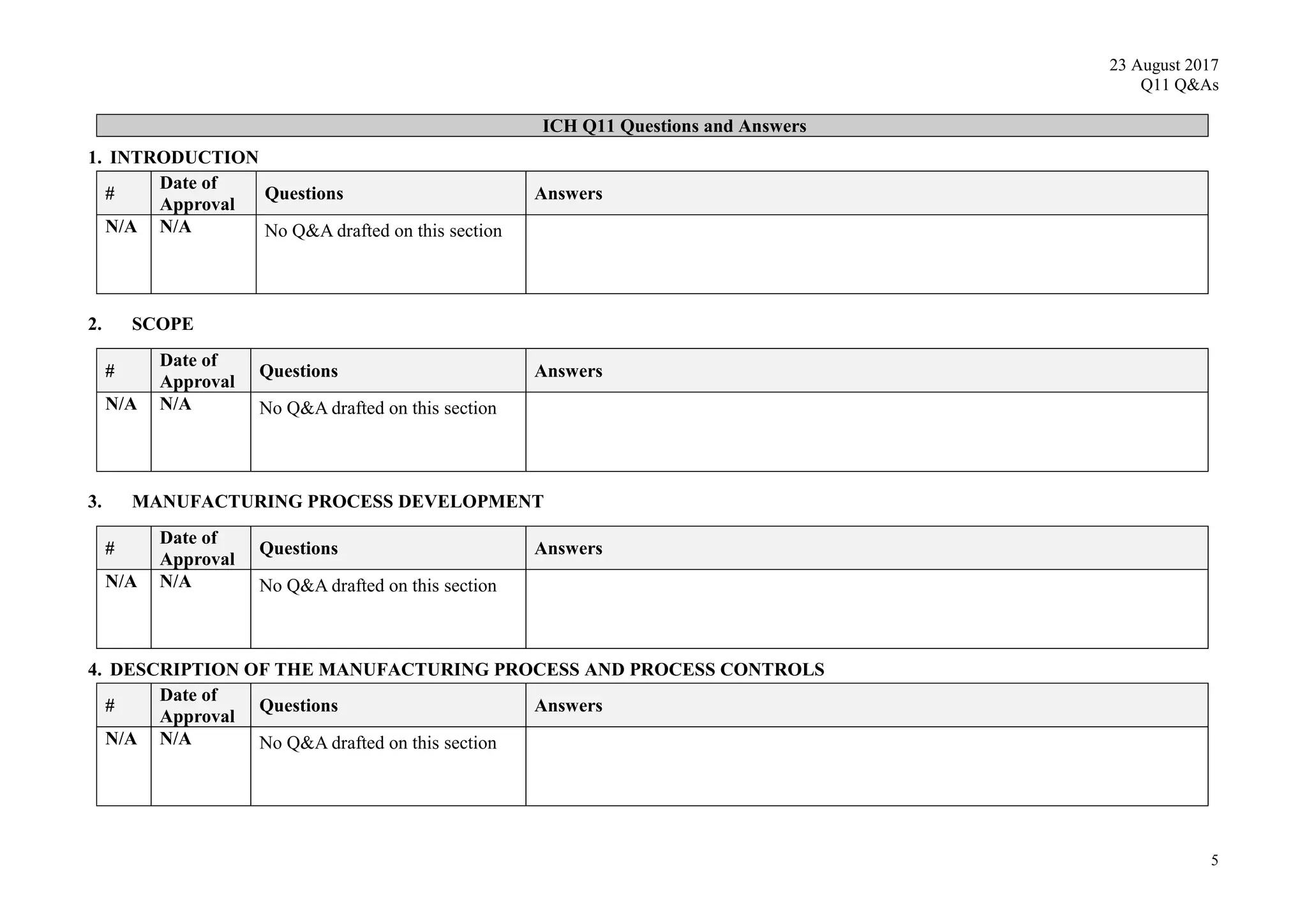
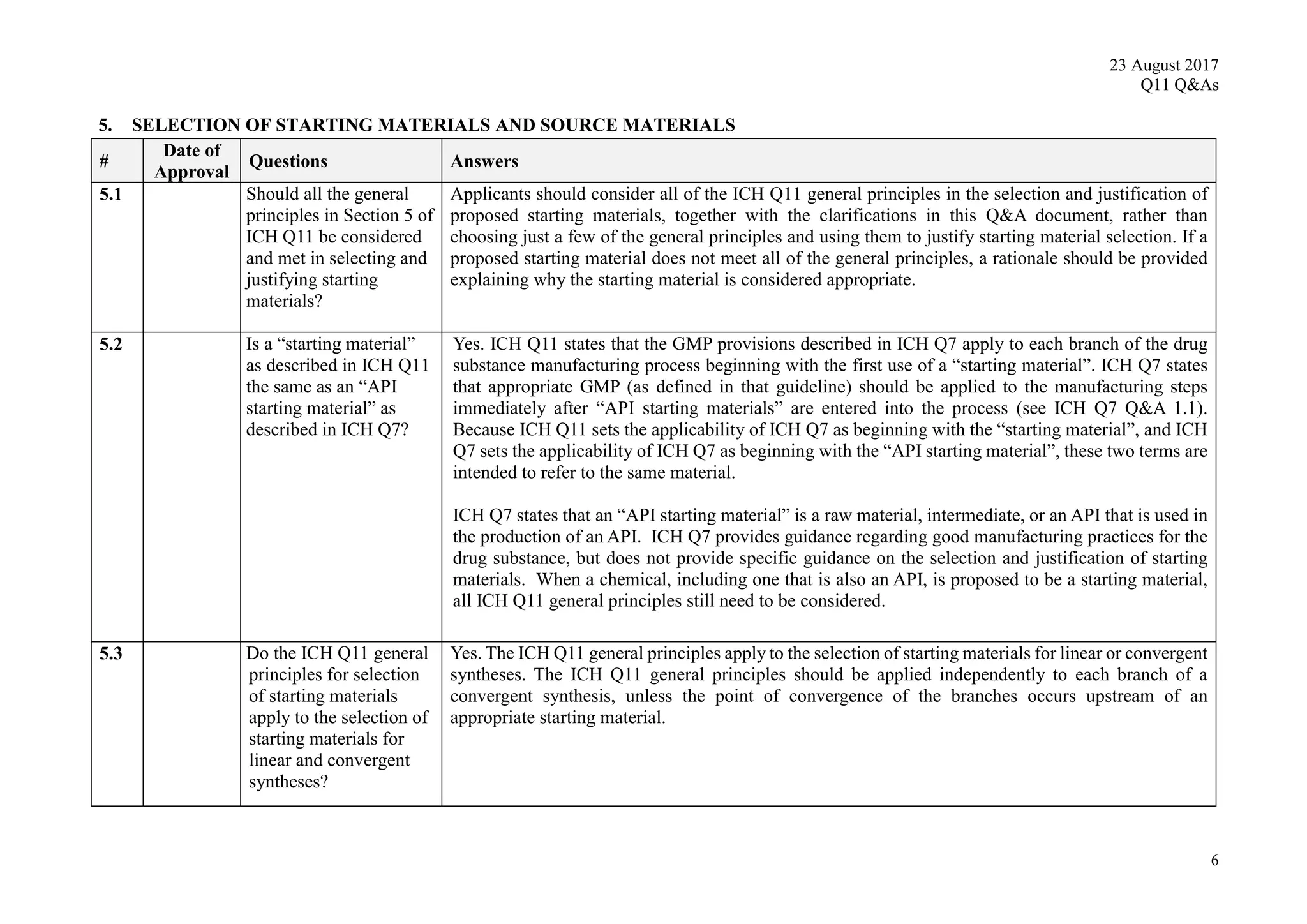

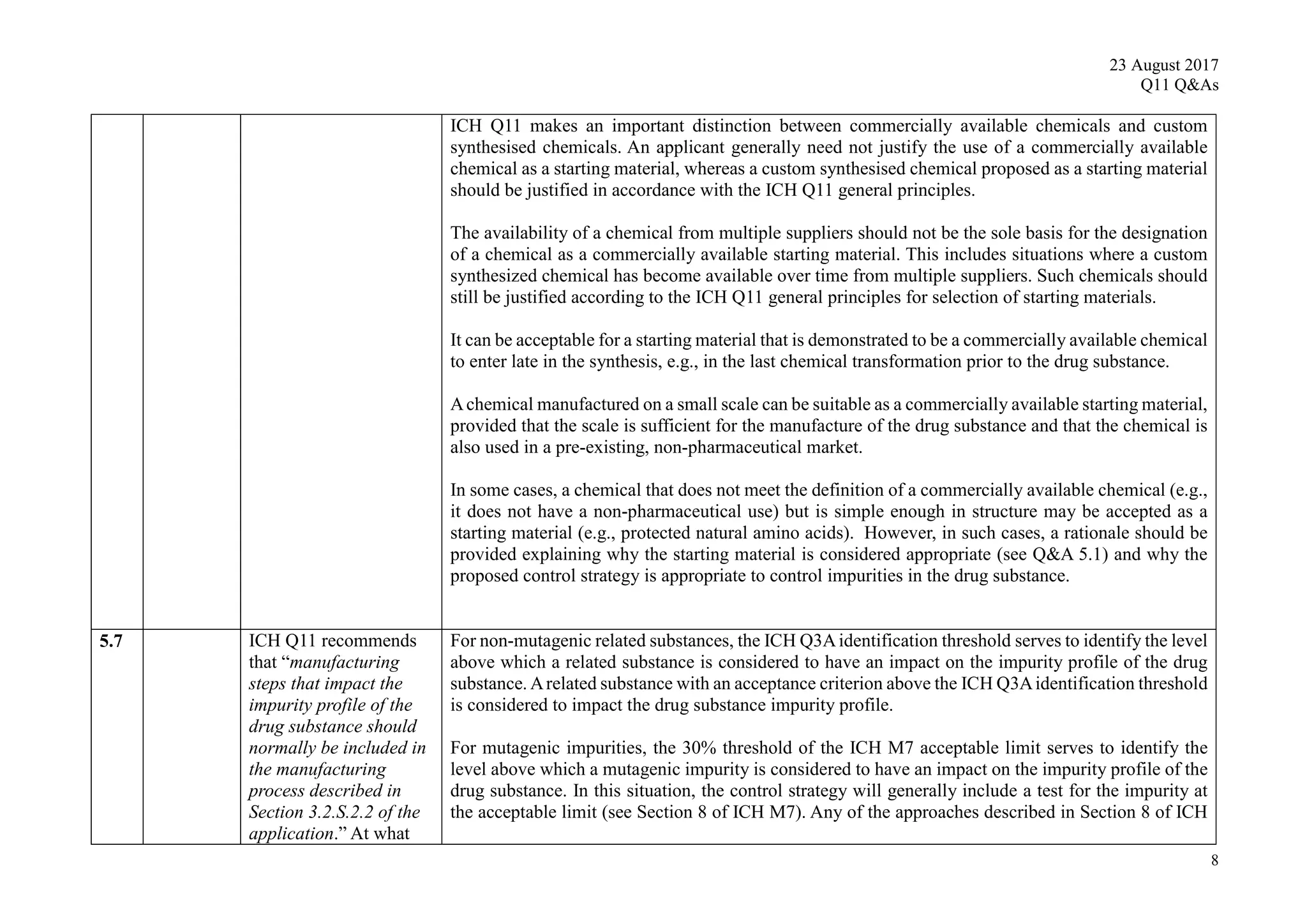
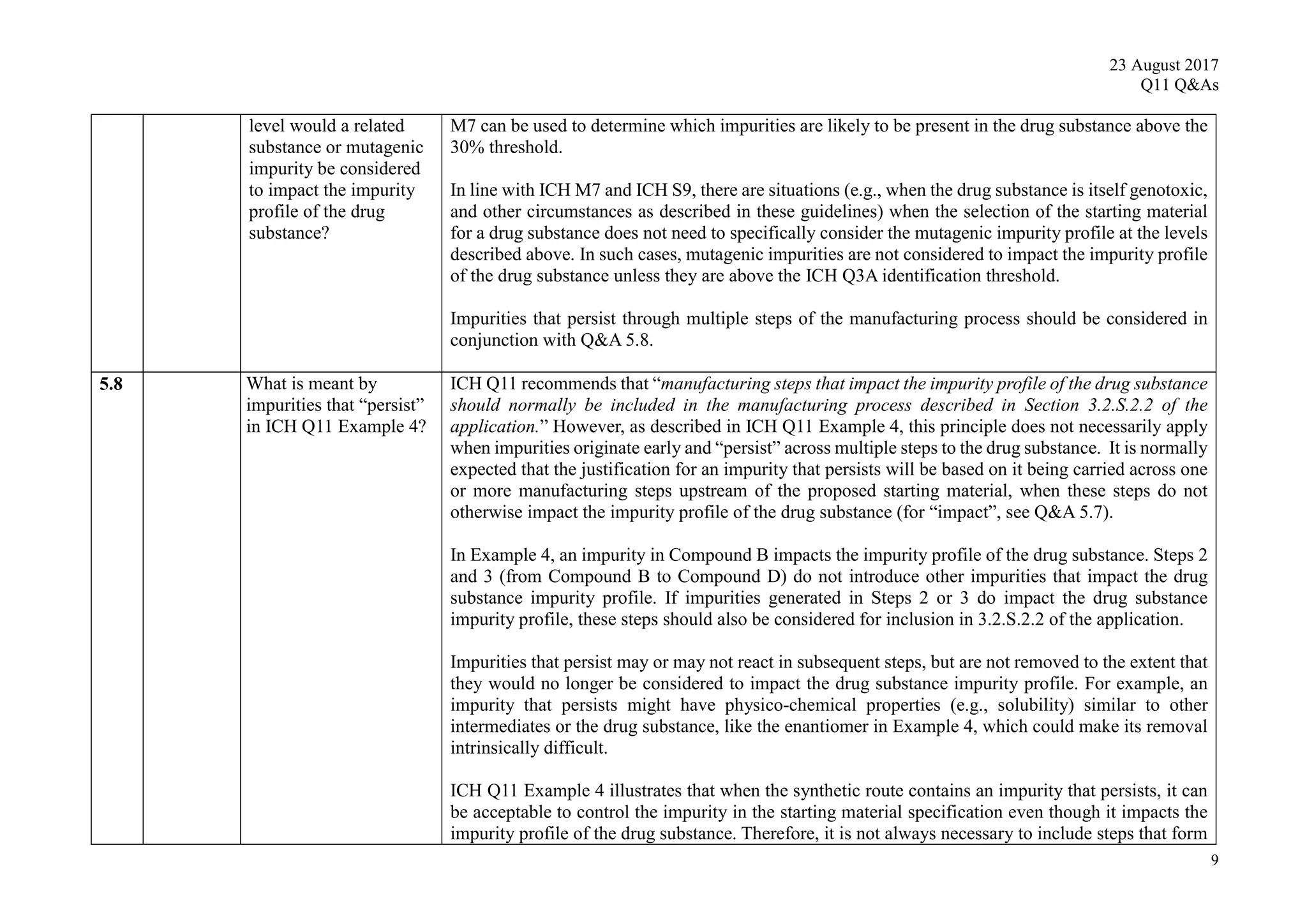
![23 August 2017
Q11 Q&As
10
such an impurity in Section 3.2.S.2.2, provided that the other ICH Q11 general principles are addressed
[ICH Q11 Section 5.1.1]. Example 4 is not exclusive to stereoisomers and can be applied to other types
of impurities that persist.
In Example 4, there are 3 chemical transformation steps between the starting material D and the drug
substance. The 3 steps in Example 4 are not intended to imply that 3 chemical transformation steps are
considered enough (see Q&A5.11) in all cases, nor that 3 chemical transformation steps are mandatory.
In the case of Example 4, application of the ICH Q11 principles includes control of the enantiomer in
the specification of the proposed starting material D, in combination with the understanding that the
steps immediately prior to D do not introduce other impurities that impact the impurity profile of the
drug substance. The applicant should provide information in the application on the upstream process
to justify the proposed starting material including control strategy of the impurity that persists.
5.9 What should an
applicant consider when
determining which
manufacturing steps
impact the mutagenic
impurity profile of the
drug substance, as part
of the selection and
justification of starting
materials?
As part of determining which manufacturing steps impact the impurity profile of the drug substance,
the applicant should identify mutagenic materials that are likely to be formed or are introduced in the
manufacturing process. The applicant should also determine which steps contribute mutagenic
impurities to the drug substance at a level considered to impact the impurity profile (see Q&A 5.7).
The Hazard Assessment Elements from ICH M7 can be used to determine which of the actual and
potential impurities are considered to be mutagenic.
For the selection and justification of starting materials, the following approaches are recommended:
Impurities that have been identified in the drug substance (“actual impurities”) should be
assessed for mutagenicity.
Reagents and intermediates used in the synthesis from commercially available chemicals to the
drug substance should be assessed for mutagenicity if they are likely to impact the impurity
profile of the drug substance. Note that this may include assessment of the mutagenicity of
some reagents and intermediates used in steps before the starting material that is eventually
proposed.](https://image.slidesharecdn.com/ichq11combine-230821090349-df7d2b39/75/ICH-Q11-Combine-pdf-52-2048.jpg)

